
Regis University Regis University
ePublications at Regis University ePublications at Regis University
Regis University Student Publications
(comprehensive collection)
Regis University Student Publications
Summer 2012
Transitioning From Relational to Nosql: a Case Study Transitioning From Relational to Nosql: a Case Study
John McPhillips
Regis University
Follow this and additional works at: https://epublications.regis.edu/theses
Part of the Computer Sciences Commons
Recommended Citation Recommended Citation
McPhillips, John, "Transitioning From Relational to Nosql: a Case Study" (2012).
Regis University Student
Publications (comprehensive collection)
. 224.
https://epublications.regis.edu/theses/224
This Thesis - Open Access is brought to you for free and open access by the Regis University Student Publications
at ePublications at Regis University. It has been accepted for inclusion in Regis University Student Publications
(comprehensive collection) by an authorized administrator of ePublications at Regis University. For more
information, please contact [email protected].

Regis University
College for Professional Studies Graduate Programs
Final Project/Thesis
Use of the materials available in the Regis University Thesis Collection
(“Collection”) is limited and restricted to those users who agree to comply with
the following terms of use. Regis University reserves the right to deny access to
the Collection to any person who violates these terms of use or who seeks to or
does alter, avoid or supersede the functional conditions, restrictions and
limitations of the Collection.
The site may be used only for lawful purposes. The user is solely responsible for
knowing and adhering to any and all applicable laws, rules, and regulations
relating or pertaining to use of the Collection.
All content in this Collection is owned by and subject to the exclusive control of
Regis University and the authors of the materials. It is available only for research
purposes and may not be used in violation of copyright laws or for unlawful
purposes. The materials may not be downloaded in whole or in part without
permission of the copyright holder or as otherwise authorized in the “fair use”
standards of the U.S. copyright laws and regulations.
Disclaimer

TRANSITIONING FROM RELATIONAL TO NOSQL: A CASE STUDY
A THESIS,
SUBMITTED ON 24 OF AUGUST, 2012
TO THE DEPARTMENT OF INFORMATION SYSTEMS,
OF THE SCHOOL OF COMPUTER & INFORMATION SCIENCES
OF REGIS UNIVERSITY
IN PARTIAL FULFILLMENT OF THE REQUIREMENTS OF MASTER OF
SCIENCE IN SOFTWARE ENGINEERING AND DATABASE TECHNOLOGIES
BY
John McPhillips
APPROVALS
Darl Kuhn, Thesis Advisor
Donald J. Ina - Faculty of Record
____________________________________
Nancy Birkenheuer, Program Coordinator
TRANSITIONING FROM RELATIONAL TO NOSQL ii
Abstract
Data storage requirements have increased dramatically in recent years due to the explosion in
data volumes brought about by the Web 2.0 era. Changing priorities for database system
requirements has seen NoSQL databases emerge as an alternative to relational database systems
that have dominated this market for over 40 years. Web-enabled, always on applications mean
availability of the database system is critically important as any downtime can translate in to
unrecoverable financial loss. Cost is also hugely important in this era where credit is difficult to
obtain and organizations look to get the maximum from their IT infrastructure from the least
amount of investment. The purpose of this study is to evaluate the current NoSQL market and
assess its suitability as an alternative to a relational database. The research will look at a case
study of a bulletin board application that uses a relational database for data storage and evaluate
how such an application can be converted to using a NoSQL database. This case study will also
be used to assess the performance attributes of a NoSQL database when implemented on a low
cost hardware platform. The findings will provide insight to those who are considering making
the switch from a relational database system to a NoSQL database system.
TRANSITIONING FROM RELATIONAL TO NOSQL iii
Acknowledgements
To Majka and Oisín, thank you for your love, support, encouragement, understanding and
patience during the last two years.
To my parents, for always encouraging me to better myself and for your never ending support
and assistance.
To my advisor Darl Kuhn, thank you for your time and the incredible advice and support you
have given during this process.
To my employer, thank you for providing the financial assistance to complete this course.
To the staff at NUIG and Regis University, thank you for providing this tremendous learning
experience.
TRANSITIONING FROM RELATIONAL TO NOSQL iv
Table of Contents
Table of Contents
Abstract .......................................................................................................................................... ii
Acknowledgements ...................................................................................................................... iii
Table of Contents ......................................................................................................................... iv
List of Figures (If Applicable) ................................................................................................... viii
List of Tables (If Applicable) ....................................................................................................... x
Chapter 1 – Introduction ............................................................................................................. 1
Thesis Statement ......................................................................................................................... 1
Preface ......................................................................................................................................... 1
Research Methodology ................................................................................................................ 3
Thesis Scope ................................................................................................................................ 4
Success Criteria ........................................................................................................................... 4
Chapter Summary ........................................................................................................................ 5
Chapter 2 – Literature Review .................................................................................................... 6
Introduction ................................................................................................................................. 6
Classification of NoSQL Systems ............................................................................................... 6
Characteristics of NoSQL systems .............................................................................................. 9
TRANSITIONING FROM RELATIONAL TO NOSQL v
Use Cases in Industry ................................................................................................................ 11
Facebook ................................................................................................................................ 11
Nokia ..................................................................................................................................... 11
Danish Department of Health ................................................................................................ 12
Guardian.co.uk....................................................................................................................... 12
Scalability Concepts .................................................................................................................. 13
The Cost Advantage of Scaling with NoSQL ........................................................................... 19
NoSQL Performance Characteristics ........................................................................................ 20
Yahoo! Cloud Serving Benchmark ........................................................................................... 21
Challenges for NoSQL Adoption .............................................................................................. 26
Vendor Support...................................................................................................................... 27
Data Querying........................................................................................................................ 27
Immaturity of the technology ................................................................................................ 29
Chapter 3 - Methodology............................................................................................................ 31
Introduction ............................................................................................................................... 31
Use Case .................................................................................................................................... 31
Application Details .................................................................................................................... 33
Database Description................................................................................................................. 35
Application Description ............................................................................................................ 37
TRANSITIONING FROM RELATIONAL TO NOSQL vi
Choosing a NoSQL Database .................................................................................................... 40
MongoDB Comparison to Relational Database .................................................................... 41
Designing the Schema ........................................................................................................... 43
Data Types in MongoDB ....................................................................................................... 46
Test Data ................................................................................................................................... 47
Test data format. .................................................................................................................... 47
Mapping the test data to the schema. ..................................................................................... 49
Loading the Test Data ............................................................................................................ 51
Deployment ............................................................................................................................... 52
Amazon EC2 Instances .......................................................................................................... 52
Web Server Setup .................................................................................................................. 53
MongoDB Setup .................................................................................................................... 57
Chapter Summary ...................................................................................................................... 60
Chapter 4 – Analysis ................................................................................................................... 61
Converting the PHP Code ......................................................................................................... 61
Converting read queries. ........................................................................................................ 62
Converting the insert/update/delete queries. ......................................................................... 71
Performance and Optimization.................................................................................................. 77
Hardware setup. ..................................................................................................................... 77
TRANSITIONING FROM RELATIONAL TO NOSQL vii
Method used for measurement taking. .................................................................................. 77
Comparison of MySQL and MongoDB write performance .................................................. 78
Comparison of MySQL and MongoDB read performance. .................................................. 80
Using Map-Reduce for Aggregation. .................................................................................... 87
Chapter Summary ...................................................................................................................... 92
Chapter 5 – Conclusions ............................................................................................................. 93
Research Findings ..................................................................................................................... 93
Lessons Learned ........................................................................................................................ 95
Summary of Contributions ........................................................................................................ 96
Future Research ......................................................................................................................... 96
References .................................................................................................................................... 97
Appendix A ................................................................................................................................ 102
Appendix B ................................................................................................................................ 111
Appendix C ................................................................................................................................ 124
Appendix D ................................................................................................................................ 132
TRANSITIONING FROM RELATIONAL TO NOSQL viii
List of Figures (If Applicable)
Figure 1. System cost vs. No of users of RDBMS (Couchbase, 2012) ........................................ 14
Figure 2. Cost effectiveness of horizontal scaling (Couchbase, 2012) ......................................... 15
Figure 3. ACID vs. BASE (Brewer, 2000) ................................................................................... 16
Figure 4. Characterisation of DBMS applications (Stonebraker & Cattell, 2011) ....................... 20
Figure 5. YCSB Client Architecture (Cooper et al., 2010) ........................................................... 23
Figure 6. YCSB Workloads (Cooper et al., 2010) ........................................................................ 24
Figure 7. Workload A results - (a) is read operations and (b) is update operations (Cooper et al.,
2010) ............................................................................................................................................. 24
Figure 8. Workload B results - (a) read operations, (b) update operations (Cooper et al., 2010) 25
Figure 9. Scalability test (Cooper et al., 2010) ............................................................................. 25
Figure 10. Elasticity results (Cooper et al., 2010) ........................................................................ 26
Figure 11. Bulletin Board Relational Schema .............................................................................. 35
Figure 12. Comparison between MyISAM and InnoDB Storage Engines ................................... 36
Figure 13. Launching EC2 Instance from AWS Marketplace ...................................................... 54
Figure 14. LAMP Instance running in EC2 .................................................................................. 55
Figure 15. Accessing the LAMP Management Interface .............................................................. 56
Figure 16. Defining a hostname .................................................................................................... 56
Figure 17. Connecting through SSH ............................................................................................. 58
Figure 18. Security Group for MongoDB ..................................................................................... 59
Figure 19. MongoDB Web Interface ............................................................................................ 59
Figure 20. Converted PHP code for the getForum() function ...................................................... 64
TRANSITIONING FROM RELATIONAL TO NOSQL ix
Figure 21. Code for index.php query ............................................................................................ 66
Figure 22. Converted PHP code for viewforum.php .................................................................... 70
Figure 23. Converted PHP code for transact-post.php insert function ......................................... 73
Figure 24. Converted PHP code for transact-post.php update function ....................................... 75
Figure 25. Converted PHP code for transact-post.php delete function......................................... 76
Figure 26. PHP code to measure MySQL query time .................................................................. 78
Figure 27. Comparison of import times for users.xml files .......................................................... 79
Figure 28. Comparison of import times for posts.xml files .......................................................... 80
Figure 29. Create view statement.................................................................................................. 81
Figure 30. Revised SQL query for viewforum.php ...................................................................... 82
Figure 31. Results of Test No. 1 ................................................................................................... 84
Figure 32. Results of Test No. 2 ................................................................................................... 84
Figure 33. Results of Test No. 3 ................................................................................................... 85
Figure 34. Results of Test No. 4 (Using the MyISAM engine) .................................................... 87
Figure 35. Map function from viewforum.php ............................................................................. 88
Figure 36. Reduce function from viewforum.php ........................................................................ 89
Figure 37. Executing the Map-Reduce command......................................................................... 89
Figure 38. viewforum.php using Map-Reduce ............................................................................. 90
Figure 39. Comparison of query times using Map-Reduce .......................................................... 91
TRANSITIONING FROM RELATIONAL TO NOSQL x
List of Tables (If Applicable)
Table 1. Comparison between MongoDB and RDBMS ............................................................... 43
Table 2. Mapping Tables to Collections ........................................ Error! Bookmark not defined.
Table 3. MongoDB users Schema ................................................. Error! Bookmark not defined.
Table 4. MongoDB posts Schema ................................................................................................ 46
Table 5. MongoDB forum Schema ................................................ Error! Bookmark not defined.
Table 6. MongoDB forum_admin Schema .................................... Error! Bookmark not defined.
Table 7. users.xml format ............................................................................................................. 48
Table 8. posts.xml format .............................................................. Error! Bookmark not defined.
Table 9. Relational Schema Mapping: forum_users ...................... Error! Bookmark not defined.
Table 10. Relational Schema Mapping: forum_posts .................... Error! Bookmark not defined.
Table 11. NoSQL Schema Mapping: users................................................................................... 51
Table 12. NoSQL Schema Mapping: posts................................................................................... 51
Table 13. SQL Analysis for functions.php ................................................................................... 63
Table 14. Comparison of PHP code for the getForum function ................................................... 64
Table 15. SQL Analysis for index.php ......................................................................................... 65
Table 16. SQL Analysis for viewforum.php ................................................................................. 68
Table 17. SQL Analysis of transact-post.php insert function ....................................................... 72
Table 18. SQL Analysis for transact-post.php update function .................................................... 74
Table 19. SQL Analysis of transact-post.php delete function ...................................................... 76
Table 20. Test specifications......................................................................................................... 83
Table 21. MongoDB read performance results summary ............................................................. 86
TRANSITIONING FROM RELATIONAL TO NOSQL 1
Chapter 1 – Introduction
Thesis Statement
Web 2.0 applications are turning to NoSQL databases as a more scalable solution than a
relational database for data storage. Transitioning an application from a relational environment
to NoSQL environment presents many challenges in terms of schema design and data access
methods.
Preface
Information explosion is a term that first appeared in the 1960’s in reference to the
increasing amounts of electronic data that was starting to appear at that time. It would have been
impossible to envisage, however, how big that explosion would become once the Internet
became mainstream over 40 years later. The amount of data that exists today is growing at an
alarming rate year on year and this has put an increasing amount of pressure on the database
systems that are tasked with storing and managing this data. In 2008, the number of devices
connected to the Internet exceeded the population of the planet (Evans, 2011). And this number
has continued to grow to the point where it is expected to be at 50 billion devices by 2020.
The vast majority of these devices produce data of some shape or form that needs to be
persisted, communicated or otherwise processed in some way. We use our personal computers to
create documents, write email, download music; smart phones are used to take pictures which are
posted to social networking sites along with other user generated content. High speed mobile
networks have enabled us to stay connected outside of the home or office, and once we are
connected, we are generating data.
This unprecedented increase in data has put new demands on database systems. The more
data contained in a database, the more difficult it becomes to manage this data and, more
TRANSITIONING FROM RELATIONAL TO NOSQL 2
importantly to retrieve this data so it can be used. The relational model has been the mainstay of
data storage systems since its inception by Edgar F. Codd in 1969. Commercially, vendors such
as IBM, Oracle and Microsoft have had tremendous success with their database products which
are all based on the relational model. However, as successful as this model has been, recently,
companies have found that when the volume of data reaches a certain level, maintaining a
relational database becomes an increasingly difficult task. There are of course methods of
implementing a relational database that can handle even the largest volumes of data that need to
be stored, but the cost of implementing such systems is out of reach of many organizations.
This has created somewhat of a gap in the data storage market for a system that is capable
of handling large volumes of data but does not carry a cost beyond the boundaries of a
company’s budget. NoSQL databases have emerged as the leading contender to fill this gap.
These systems are designed to handle huge volumes of data through a scale-out model that
allows the database to be spanned over hundreds, or even thousands, of low cost commodity
servers. This distributed model is designed to be highly fault tolerant as each piece of data in the
database is replicated a number of times on other participating nodes in the cluster. Although
relational database systems also support distributed architectures, the difficulty and cost of
implementing this with the relational model has been a barrier for many. NoSQL databases aim
to make this type of architecture more accessible by automating many of the difficult aspects of
data distribution. Features such as automatic data sharding and replication abstract much of the
complexity of distribution, allowing an organisation to easily expand their data storage system.
On top of all this, NoSQL databases provide a flexible schema for data storage, as opposed to the
rigid schema required in the relational model. This makes them more suitable for unstructured
TRANSITIONING FROM RELATIONAL TO NOSQL 3
data and changing requirements which has become increasingly important when designing
databases systems.
These benefits have seen an increasing uptake in NoSQL technology in recent years. Web
industry giants such as Google, Facebook and Twitter have led the way in terms of adopting this
technology and this has given confidence to others to move in the same direction. But what if an
organisation is heavily invested in the relational world? Making the change to a new technology
may seem like a daunting prospect for many, particularly as such a high value is placed on an
organisations information. The goal of this study is to show that moving from a relational
environment to a NoSQL environment can be achieved if the right approach is taken. Schema
translation from relational to NoSQL is a key aspect of making the transition. Normalisation of
data is the order of the day when designing relational databases, but a different thought process is
required for NoSQL databases. Another important aspect is data retrieval. Although there is no
standard query language for NoSQL, most SQL can be converted to equivalent commands in
whatever language the NoSQL database uses for data access. This thesis will evaluate both
schema design transfer and SQL to NoSQL translation.
Research Methodology
The research conducted for this thesis will require both qualitative and quantitative
research methodologies. I intend to research the usage of NoSQL databases in industry, in
particular the reasons organisations decided to utilize NoSQL and the steps taken to come to this
conclusion. A content analysis will be conducted on literature pertaining to the usage of NoSQL
in industry to identify patterns in the thought process undertaken by an organisation deciding to
TRANSITIONING FROM RELATIONAL TO NOSQL 4
use a NoSQL database. Customer service in the NoSQL sector will also be examined to
determine if it is comparable to the established relational database vendors.
To evaluate the process of transitioning from a relational database to a NoSQL database,
a case study will be undertaken that takes an existing application based on a relational database
and converts the application code to use a NoSQL database instead. This case study will also be
used to assess some of the performance characteristics of the NoSQL database in comparison to
the relational database.
Thesis Scope
A definition of a NoSQL database will be established in Chapter 2 and the research will
be confined to those databases classed as NoSQL. For reference, the relational database used in
the case study will be MySQL and the NoSQL database will be restricted to a single vendor.
Other aspects such as backup & recovery, performance tuning tools, high availability tools,
replication, and the robustness of the query language will not be considered.
Success Criteria
The following list makes up the success criteria for this study:
• The reasons for transitioning to a NoSQL database have been established through
research;
• An analysis of the support provided by NoSQL vendors has been undertaken;
• A case study has been undertaken to convert an application from using a MySQL
database to a NoSQL database;
TRANSITIONING FROM RELATIONAL TO NOSQL 5
• An analysis of the performance of the NoSQL database compared to the MySQL
database has been completed.
Chapter Summary
NoSQL databases are an emerging technology that provides an alternative to the more
established relational databases that have traditionally dominated the data storage market. They
aim to provide a more scalable and highly available database system with less cost and overhead,
while sacrificing certain characteristics such as consistency and a simple query language.
The remainder of this thesis is structured as follows:
• Chapter 2 provides a review of the literature pertaining to the use of NoSQL
databases in industry, the different classifications of NoSQL databases,
performance characteristics of NoSQL database and the challenges they face in
order to achieve wide spread adoption.
• Chapter 3 describes the methodology used to transfer an existing relational
database in to a NoSQL environment.
• Chapter 4 provides an analysis of converting existing database access code from
relational to NoSQL in a typical application and a comparative analysis of the
performance differences between the existing application and the converted
application.
• Chapter 5 summarises the findings of the research and details some further
research areas to be explored.
TRANSITIONING FROM RELATIONAL TO NOSQL 6
Chapter 2 – Literature Review
Introduction
This literature review will research the current trends in the large data store industry as it
relates to NoSQL databases and scalable relational databases. NoSQL databases are a recent
addition to this industry and as such, the various vendors are constantly altering their offerings to
provide continuous improvements to the underlying system. This creates somewhat of a moving
target in terms of the correctness of the literature available. Articles and papers that make
statements about a particular NoSQL system can quickly become outdated by revisions to that
system. Bearing this in mind, this literature review will attempt to draw information from sources
that are as recent as possible.
The purpose of the literature review is to gather and analyse information relating to
NoSQL databases and scalable relational databases to support the decisions made in the practical
element of the thesis. The first part will deal with NoSQL systems currently available and the
classification of these systems. The next section will look at how NoSQL systems are currently
being used in industry. This will be followed by a discussion of how NoSQL systems support
scalability in comparison to scalable relational databases, the performance characteristics of
NoSQL systems and the challenges facing NoSQL in terms of widespread adoption in the
industry.
Classification of NoSQL Systems
The NoSQL movement came about largely because of the increasing data storage needs
of the Web 2.0 industry. The big players in this industry became frustrated with the difficulties of
building distributed storage architectures based on traditional RDBMS systems. Because of this,
TRANSITIONING FROM RELATIONAL TO NOSQL 7
web application developers took matters in to their own hands and developed their own database
technologies (Couchbase, 2012). Google and Amazon are two such companies that are now seen
as pioneers of the NoSQL movement (Cattell, 2010; Couchbase, 2012; Neo Technology, 2011).
Google’s BigTable showed that it was possible to store simple data on a system that could scale
to hundreds or thousands of nodes (Cattell, 2010). Amazon’s Dynamo database pioneered the
idea of sacrificing strong consistency in favour of high availability; data was not guaranteed to
be up-to-date on every node but updates would be applied to each node eventually (Cattell,
2011).
Since then, there have been a many developments in the NoSQL industry with many
more vendors now providing NoSQL systems. Of the systems currently available, most will fall
in to one of three categories (Cattell, 2010):
• Key-value stores: All data is stored as a simple key-value index. The key is used to
identify a value that is typically stored as a BLOB, but can contain other data types
such as strings or pointers. These systems can be equated to a distributed index that
was popularised by the memcached open source cache system which took advantage
of the increasing availability of main memory to store in-memory indexes (Cattell,
2011). These systems are highly efficient, they can scale to a high number of nodes,
but provide a very simple data model (Pokorny, 2011). Examples of key-value stores
include Redis, Riak, Scalaris and Project Voldemort
• Document Stores: Data is stored in semi-structured documents that are indexed by a
key. Documents can have a varying number of attributes of varying types and can
also be queried to look for matching attributes contained within the document
(Cattell, 2010). They offer additional functionality to key-value stores while
TRANSITIONING FROM RELATIONAL TO NOSQL 8
maintaining the ability to partition data over multiple nodes and provide support for
replication and automatic recovery (Cattell, 2010). Examples of document stores are
CouchDB, MongoDB and Dynamo.
• Extensible Record Stores: Also referred to as wide column stores due to the fact that
each row in a related dataset can contain a varying amount of attributes (Cattell,
2010). Of the NoSQL systems, this data model is the closest to the relational data
model. Data is stored in tables but each row has a dynamic number of attributes
(Cattell, 2010). Both rows and columns can be distributed across nodes providing
high scalability and availability (Cattell, 2011). Examples of extensible record stores
are Google BigTable, Cassandra, HyperTable and HBase.
Other non-relational database systems in existence have been put into the NoSQL
category that do not fit in to the three categories above. Graph databases, such as Neo4j, store
data as relationships between key value pairs (Neo Technology, 2011). Object-oriented databases
store data as collections of objects that can be easily materialized as programming language
objects (Cattell, 2011). Both of these systems provide features such as horizontal scaling and the
ability to store massive amounts of data, however as Cattell (2011) points out, these systems
differ from those found in the three categories described above in that they generally provide
ACID transactions and data querying involves complex object behaviour rather than simple key
lookups (Cattell, 2011). This represents a significant characteristic difference to the key-value
stores, document stores and extensive record stores. Therefore, this review will exclude these
systems from the NoSQL category and any reference to NoSQL will assume a system from the
three categories described above.
TRANSITIONING FROM RELATIONAL TO NOSQL 9
Characteristics of NoSQL systems
Besides placing each system in to one of the three categories described, all of the systems
have common characteristics which allow them to be collectively described as NoSQL
databases.
• Horizontal Scaling: This is a key feature of NoSQL. Data can be replicated and
partitioned over many servers in a “shared nothing” architecture (Cattell, 2011), that is,
all nodes are equal and none of the hardware is shared. This enables two important
features of NoSQL – storage of large amounts of data and the ability to use cheaper
commodity servers instead of more expensive enterprise class servers. The CouchDB
system derives its name from this characteristic: Cluster Of Unreliable Commodity
Hardware (Bhat & Jadhav, 2010).
• Automatic Sharding: Data is automatically spread across all servers in the cluster. Also
referred to as “elasticity”, due to the fact that servers can be added or removed without
any downtime. Any new server added immediately begins to receive data from the other
servers in the cluster. Data is also replicated across the cluster (Couchbase, 2012).
• No Schema: Unlike a traditional RDBMS, NoSQL databases are confined to a rigid data
schema. Any record that is inserted can have an arbitrary number of attributes associated
with it and these attributes can be altered at any time (Couchbase, 2012). This provides
excellent flexibility for applications whose data may not conform to a constant structure
and is likely to change regularly.

TRANSITIONING FROM RELATIONAL TO NOSQL 10
• Simple query interface: As the name implies, NoSQL does not support the SQL query
language
1
. Instead, querying is provided through various different mechanisms which
varies from one distribution to another. For example, Amazon’s SimpleDB uses a subset
of SQL commands such as SELECT and DELETE along with operations like
GetAttributes and PutAttributes. HBase uses another restricted SQL variant called HQL,
and CouchDB uses a procedural approach to querying its document based records
(Pokorny, 2011).
• Highly Available: Data is replicated across multiple servers (and even across multiple
data centres) allowing for a highly available configuration that can handle multiple server
failures and support disaster recovery (Cattell, 2010) (Couchbase, 2012).
• Weaker consistency model: Providing ACID semantics has been a staple feature of
RDBMS databases since their inception in the 1970’s. However, in a distributed
architecture, the consistency property becomes more difficult to guarantee. Because the
web has enabled 24x7x365 access to applications, availability has become a high priority
for a database system. Because of this, developers are willing to sacrifice strong
consistency in favour of higher availability. NoSQL systems provide this sacrifice,
offering eventual consistency instead of strong consistency. This means that it may not be
possible to get a consistent view of data across all nodes at any one time. Many
developers are willing to live with this compromise (Cattell, 2010).
1
Although lack of SQL support is a characteristic of NoSQL, the NoSQL name is commonly understood to mean
‘Not Only’ SQL.
TRANSITIONING FROM RELATIONAL TO NOSQL 11
Use Cases in Industry
Despite the relative immaturity of NoSQL, there has been a surprisingly positive uptake
of various implementations in industry. Unsurprisingly, a large percentage of organisations that
are using NoSQL are Web 2.0 industry leaders such as Google and Facebook. However, there
are also implementations from organisations in the areas of media, online entertainment and
governmental departments.
Facebook.
In November 2010, Facebook launched their new messaging system which is based on
HBase. Other platforms such as MySQL and Cassandra were considered for the project but
HBase was chosen based on its ability to scale well, the replication system it employs and
previous experience with the underlying technology within Facebook (DBPedias.com, n.d.).
MySQL was originally used to support this application but the volume of data involved (25TB
per month) necessitated a system capable of supporting a high write throughput
(Muthukkaruppan, 2011).
Nokia.
Like Facebook, Nokia have also converted a working relational database system to a
proprietary NoSQL system developed in-house by Nokia (Farrell, 2011). The Nokia Places
application is a POI registry used to support GPS applications. The system was originally built
on a MySQL database and contained about 600GB of data (Farrell, 2011). However, due to a
possible merger with Bing maps and the unwillingness to make a significant investment in
upgrading the current RDBMS server, Nokia took the decision to move to a NoSQL system
(Farrell, 2011). This enabled on demand scaling, which was a key requirement given the possible
TRANSITIONING FROM RELATIONAL TO NOSQL 12
merger. Another factor was the fact that the schema required for the system was not rigid. This is
another area where NoSQL provided an advantage over the existing MySQL system.
Danish Department of Health.
The Department of Health in Denmark are using the key-value store Riak to store data for
a medicine card system which controls the administration of drugs to medicine card holders
(Thorub, 2011). This is another example of a system that was based on MySQL and converted to
NoSQL. The main reasons cited for this were (Thorub, 2011):
• High availability: Because of the criticality of the system, high availability was a high
priority requirement. Using Riak allowed the system to be configured in a distributed
architecture across multiple data centres.
• Scalability: To prepare for expected growth by allowing dynamic scaling of the system.
• Operational improvements: Such as the ease of creating backups in comparison to the
MySQL system.
This use case demonstrates that the use of NoSQL is not confined to the Web 2.0 industry; it
is also being employed to support highly critical enterprise applications.
Guardian.co.uk.
Developers at the guardian.co.uk took the decision to move to a NoSQL environment
when they began to hit continuous road blocks with their J2EE/RDBMS/ORM solution due to
the complexity associated with every upgrade of their web site. Every change they made required
a schema upgrade which changes had to be made to over 300 tables, 10,000 lines of hibernate
XML configuration, 1000 domain objects mapped to the database and 70,000 lines of domain
object code (Wall, 2011). The tight binding to the application prompted them to look for an
TRANSITIONING FROM RELATIONAL TO NOSQL 13
alternate solution and because they were using a JSON API, it made sense for them to store the
data as JSON documents. This eventually led them to the document store MongoDB.
Where most of the NoSQL use cases in industry originate from the need for scalability
and availability, the primary reasons for choosing MongoDB in this particular case were because
of its data model, its ability to do complex queries, the flexible consistency modes, no schema
and the fact that it works well at large and small scale deployments (Wall, 2011). This shows that
NoSQL databases are being used for a range of reasons and not just for scalability and
availability.
Scalability Concepts
The ability to scale easily and on demand is seen as one of the most appealing
characteristics of NoSQL systems amongst adopters in industry. This is worth discussing in the
context of current scalability options user of relational databases are faced with. The relational
database was designed on a centralised computing model. Notably, other tiers in an enterprise
architecture, such as the web tier and the application tier, are typically built on a distributed
model (Couchbase, 2012). The only option to increase the capacity of a standalone relational
database system is to invest in more powerful hardware; increasing CPU, memory, I/O capacity
and disk space. Pokorny (2011) refers to this as vertical scaling, or scale up. This form of scaling
introduces a number of undesirable characteristics:
• Big servers are usually highly complex and expensive. The more users a system must
support, the bigger the server required. This brings an exponential growth in cost for a
linear increase in users (Figure 1);
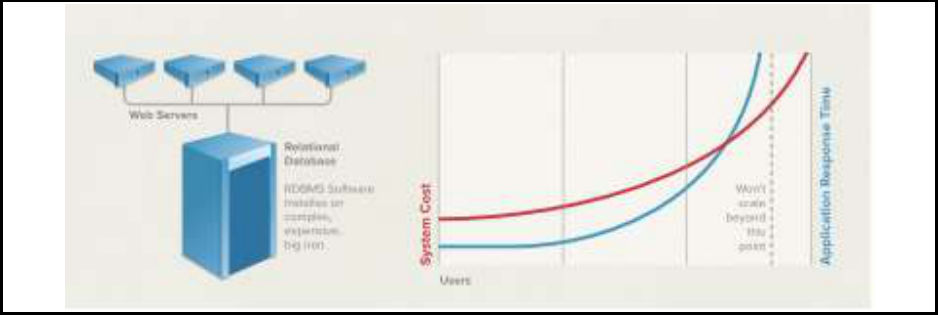
TRANSITIONING FROM RELATIONAL TO NOSQL 14
• No matter how much a server is upgraded, there is a limit to the total capacity of a
system (Figure 1);
• There is increased pressure on fault tolerance and high-availability strategies if there
is only one database server and often these strategies involve highly complex
hardware configurations (Couchbase, 2012).
Figure 1. System cost vs. No of users of RDBMS (Couchbase, 2012)
In contrast, NoSQL systems scale horizontally, or scale out, using cheaper commodity
servers. This mirrors more closely the distributed architectures found in web tiers and application
tiers. Each server contributes equally in a shared-nothing architecture and there is no one single
point of failure (Cattell, 2011). Horizontal scaling allows for a more agile and cost effective way
to scale a database (Figure 2).
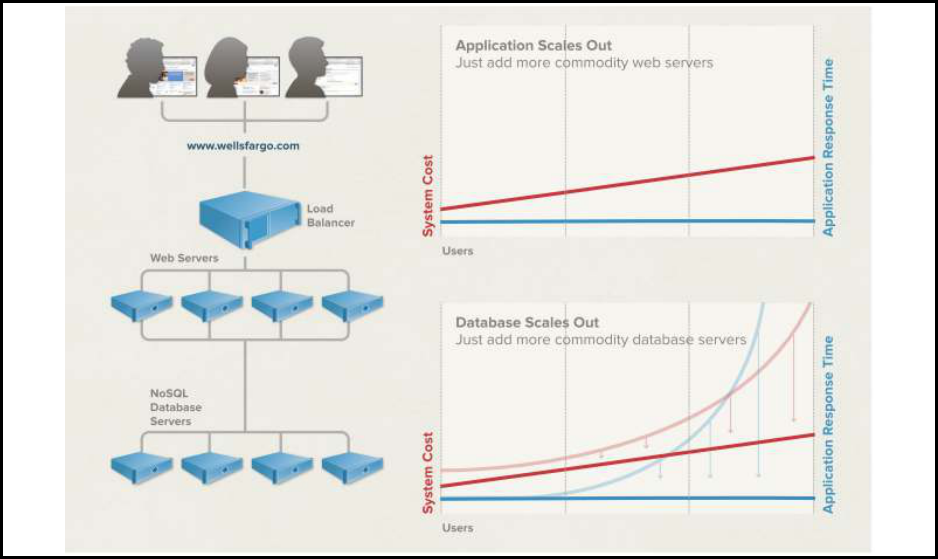
TRANSITIONING FROM RELATIONAL TO NOSQL 15
Figure 2. Cost effectiveness of horizontal scaling (Couchbase, 2012)
In order to provide horizontal scaling, NoSQL systems provide a weaker concurrency
model than the ACID transactions found in relational database systems. The acronym BASE
(Basically Available, Soft State, Eventually consistent) has been suggested in many sources as a
more appropriate term for NoSQL (Cattell, 2011). What this acronym alludes to is that a NoSQL
system will always be available, but the data may not be in a consistent state. Instead, most
NoSQL systems provide eventual consistency, meaning all nodes will eventually be in a
consistent state after updates have been propagated. The properties of an ACID system versus
those of a BASE system are presented by Brewer (2000) and shown in Figure 3.
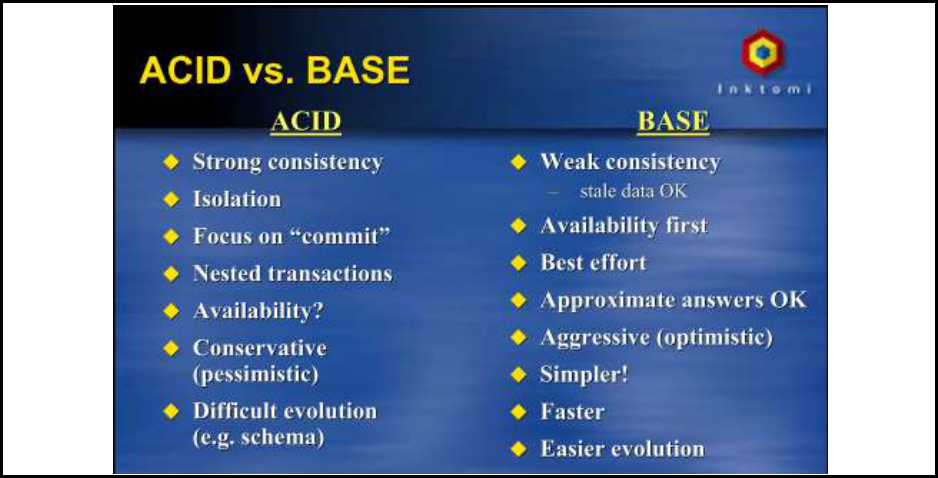
TRANSITIONING FROM RELATIONAL TO NOSQL 16
Figure 3. ACID vs. BASE (Brewer, 2000)
An alternative view is to compare scalability in a relational database and a NoSQL
database in terms of the CAP theorem, also presented by Brewer (2000). This theorem states that
of the three properties consistency, availability and partition tolerance, only two of these can be
guaranteed in a shared data system. Pokorny (2011) explains these properties in more detail:
• Consistency: After data is written, all users will see the same version of the data
• Availability: Every operation on the database will terminate successfully.
• Partition tolerance: The database can still operate even when some nodes in the
distribution are unavailable.
Distributed relational databases tend to forfeit the availability property in favour of
consistency and partition tolerance. But in order to provide this strong consistency in a
distributed system, any writes to the database must be committed on every node before a
TRANSITIONING FROM RELATIONAL TO NOSQL 17
transaction can complete. This is the critical factor that limits the scalability of relational
systems.
Conversely, NoSQL systems forfeit the consistency property in favour of availability.
The eventual consistency approach means that a transaction can complete once the data is written
to one node and it is then up to the database engine to propagate the data to each of the other
nodes in the distribution. If it is critical that an application be always available and an acceptable
possibility that it may read stale data, then this compromise may be more desirable than a
relational system. Furthermore, many NoSQL systems provide a level of control on the
consistency property, allowing the developer to specify a number of nodes in the cluster that the
write must propagate to before the transaction can be considered complete. Cassandra, for
example, provides six different consistency levels for write operations. Specifying a consistency
level of ONE or ANY requires a write to complete on only one node in a replica, ALL requires
the write to complete on all replica nodes and QUOROM requires the write to complete on a
quorum of nodes calculated by the formula (Black, 2009):
(replication_factor / 2) + 1
Therefore, if the number of replicas is 3, then writes must succeed on at least two of the
nodes before the transaction completes. The quorum can also be enforced on read operations. If
the data returned from each node in the quorum does not match, the conflict must be dealt with
before the data is returned. This ensures that no stale data is read because the write and read
quorums overlap (Black, 2009).
Even though a traditional RDBMS does not provide simple scalability, many developers
are left with no choice but to implement a distributed system when the demands of applications
outgrow what is achievable with a single server system. The most common approach to scaling
TRANSITIONING FROM RELATIONAL TO NOSQL 18
an RDBMS is to shard data across several servers. This involves partitioning a table based on
some pre-defined criteria and placing each partition on a separate node in the distribution.
Although this is a common technique, there are a number of drawbacks to this approach:
• A cross-shard filter or join must be performed in the application;
• If there are updates on multiple shards within a transaction, then the application is
responsible for guaranteeing consistency across nodes;
• As the system scales, node failures become more common. Consistent replicas are
difficult to maintain, it is difficult to detect failures, fail over to replicas and replace failed
nodes in a running system;
• Making schema changes is very difficult without taking shards offline;
• Adding additional nodes or changing configuration is “extremely tedious” and “much
more difficult if the shards cannot be taken offline” (Stonebraker & Cattell, 2011).
There are, however, a number of scalable relational systems available that claim to
provide comparable scalability and availability to NoSQL systems, such as MySQL Cluster,
VoltDB and Clustrix. Cattell (2011) notes that some RDBMS systems can provide scalability on
a similar level to NoSQL systems if they can abide by two conditions:
1. Avoid operations that span many nodes, e.g. joins over many tables.
2. Avoid transactions that span many nodes. The communication and two-phase commit
overhead will lead to inefficient performance.
It is worth noting that NoSQL systems inherently avoid these issues by making it difficult
to perform these types of operations (Cattell, 2011). If these scalable RDBMS systems prove to
TRANSITIONING FROM RELATIONAL TO NOSQL 19
be comparable with NoSQL, then the fact that they retain ACID properties and the SQL query
language could make them a more attractive option for a scalable data store.
The Cost Advantage of Scaling with NoSQL
As well as being easier to scale with NoSQL, it can also be more cost effective than it is
to scale out with a relational database system. Many NoSQL database vendors license the
database engine under the GNU Free Software Foundation license, leaving the only costs with
the hardware required to implement the cluster. Compared to a commercially licensed relational
database system, the savings can be significant. For example, the cost for a typical 4 node Oracle
RAC Cluster set up:
• Standard license: $17,500 X 2 processors X 4 nodes = $140,000;
• Real Application Clusters option: $23,000 X 2 processors X 4 nodes = $184,000;
• Partitioning option: $11,500 X 2 processors X 4 nodes = $92,000;
• In-memory Database Cache: $23,000 X 2 processors X 4 nodes = $184,000
(Oracle, 2012).
This gives a total licensing cost of $600,000. MySQL Cluster is probably a more
comparable option as, like the NoSQL databases, it is free to license. However, if support is
required, this costs $10,000 per year for each 1-4 socket server (Oracle, n.d.). Not all NoSQL
vendors offer a support option, but two that do are Riak and MongoDB. They provide support at
a cost of $3,995 and $4,000 per node per year respectively (10Gen, 2012) (Basho Technologies
Inc., 2012).

TRANSITIONING FROM RELATIONAL TO NOSQL
NoSQL Performance Characteristics
Besides from the scalability advantages, the other area in which NoSQL claims to
provide an advantage over traditional RDBMS systems is in performance. However,
performance of a database system can be affected by several different factors and performance
r
equirements can vary from one application to another. A classic OLTP type system is generally
more write intensive than read intensive, while a data warehouse type system will normally be
more read intensive. A Web 2.0 application will normally fall at a v
two.
Stonebraker & Cattell (2011)
application and plot the graph in Figure 4 to depict where such an application will fall on a write
focus vs. read-
focus scale. Different applications will have different performance requirements
and therefore it is not possible to simply state tha
than distributed relational databases. The reality is likely to be that NoSQL can provide
performance gains for
certain
Figure 4.
Characterisation of DBMS
Although there are a number of recognised benchmarks for me
a relational DBMS, such as TPC
typical OLTP workload
(Raab, Kohler, & Shah, n.d.)
TRANSITIONING FROM RELATIONAL TO NOSQL
NoSQL Performance Characteristics
Besides from the scalability advantages, the other area in which NoSQL claims to
provide an advantage over traditional RDBMS systems is in performance. However,
performance of a database system can be affected by several different factors and performance
equirements can vary from one application to another. A classic OLTP type system is generally
more write intensive than read intensive, while a data warehouse type system will normally be
more read intensive. A Web 2.0 application will normally fall at a v
arying point between these
Stonebraker & Cattell (2011)
take social networking as a typical Web 2
application and plot the graph in Figure 4 to depict where such an application will fall on a write
focus scale. Different applications will have different performance requirements
and therefore it is not possible to simply state tha
t NoSQL databases provide better performance
than distributed relational databases. The reality is likely to be that NoSQL can provide
certain
types of applications.
Characterisation of DBMS
applications
(Stonebraker & Cattell, 2011)
Although there are a number of recognised benchmarks for me
asuring the performance of
a relational DBMS, such as TPC
-
C, which measures performance of a database processing a
(Raab, Kohler, & Shah, n.d.)
, there has been a limited amount of
20
Besides from the scalability advantages, the other area in which NoSQL claims to
provide an advantage over traditional RDBMS systems is in performance. However,
performance of a database system can be affected by several different factors and performance
equirements can vary from one application to another. A classic OLTP type system is generally
more write intensive than read intensive, while a data warehouse type system will normally be
arying point between these
take social networking as a typical Web 2
.0 DBMS
application and plot the graph in Figure 4 to depict where such an application will fall on a write
-
focus scale. Different applications will have different performance requirements
t NoSQL databases provide better performance
than distributed relational databases. The reality is likely to be that NoSQL can provide
(Stonebraker & Cattell, 2011)
asuring the performance of
C, which measures performance of a database processing a
, there has been a limited amount of

TRANSITIONING FROM RELATIONAL TO NOSQL 21
research in the area of performance measurement for NoSQL systems, and any systems that have
been developed are in the early stages of maturity. The most widely recognised benchmark for
NoSQL is the Yahoo! Cloud Serving Benchmark (YCSB), developed by Yahoo! to facilitate
comparisons between “new generation cloud data serving systems”, which are analogous to
NoSQL systems (Cooper, Silberstein, Tam, Ramakrishnan, & Sears, 2010). The YCSB is not
confined however to NoSQL systems. It is the intention of the framework to provide evaluation
of any cloud based storage systems, including sharded relational systems. The YCSB is a
significant tool in terms of comparing sharded relational and NoSQL systems to assist in the
selection of an appropriate data storage solution and merits further discussion.
Yahoo! Cloud Serving Benchmark
The YCSB is an extensible open source framework and it is the intention of the
developers that the benchmark be adapted for use with multiple database systems. However, the
system is in the very early stages of maturity, having been released in 2010, and there is a limited
amount of results of usage of the system at this point.
The benchmark currently evaluates systems on two tiers: Performance and Scalability
2
:
•
Performance is evaluated in terms of latency of requests when the database is under
load. There is a trade-off between latency with throughput. A system is evaluated by
measuring latency as throughput is increased until a saturation point is reached
(Cooper et al., 2010).
2
Other aspects such as availability and replication can be supported through extension of the system
TRANSITIONING FROM RELATIONAL TO NOSQL 22
•
The scalability tier examines the impact on performance as more servers are added.
The benchmark measures two metrics in this tier:
o
Scale up – A workload is run on a given number of servers and performance is
evaluated. More servers are then added and a larger workload is run on this
configuration. Good scaling is indicated if performance remains constant as
the workload and the number of servers are proportionally increased.
o
Elastic Speedup – This metric evaluates how performance is impacted as the
number of machines is increased in a running system. A system that provides
good elasticity should show an increase in performance when a machine is
added, after an initial period of reconfiguration.
The YCSB uses a set of predefined workloads to produce results. These workloads can be
tweaked to perform various combinations of insert, update, read and scan operations. In order to
decide which records should be operated on, the tool uses one of several distribution algorithms:
•
Uniform: An item is chosen uniformly at random. All records are equally likely to be
chosen;
•
Zipfian: Choose an item according to the Zipfian distribution. In this mode, some
records will be extremely popular while most will be unpopular. This is useful for
modelling items whose popularity is independent of their newness, for example in a
social networking application where some profiles are updated more often than
others, even though the profile may be many years old;
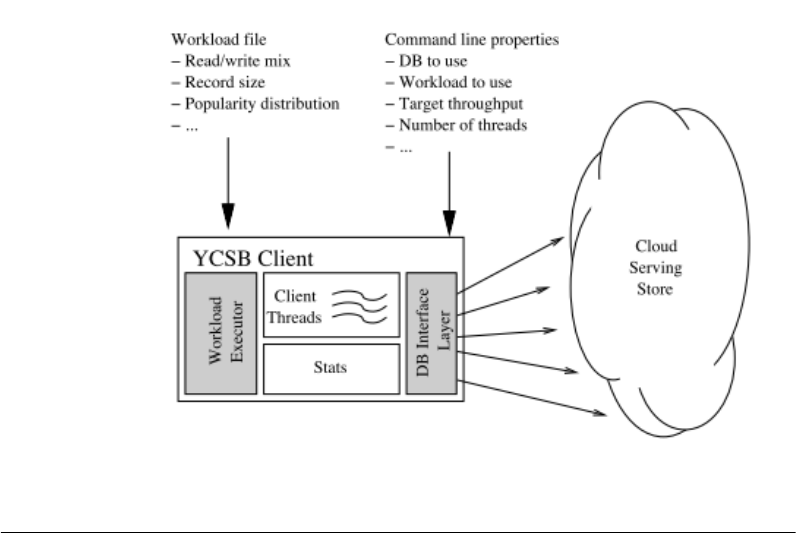
TRANSITIONING FROM RELATIONAL TO NOSQL 23
• Latest: The most recent records are more likely to be chosen. This could be used to
simulate something like a blogging application where the most recent posts are more
likely to see activity;
• Multinomial: The probability of operations can be assigned a value. For example, a
probability of 0.95 can be assigned to the write operation to simulate a write-heavy
workload (Cooper et al., 2010).
Once the workload has been created, it is executed against the database using a Java
program called the YCSB client. This client is responsible for generating both the data to load
and the operations to be performed. The workload executor drives multiple threads which throttle
the rate at which requests are generated to control the load on the database. They are also
responsible for measuring latency and throughput and reporting the results to a statistics module
(Cooper et al., 2010). The client architecture is shown in Figure 5.
Figure 5. YCSB Client Architecture (Cooper et al., 2010)
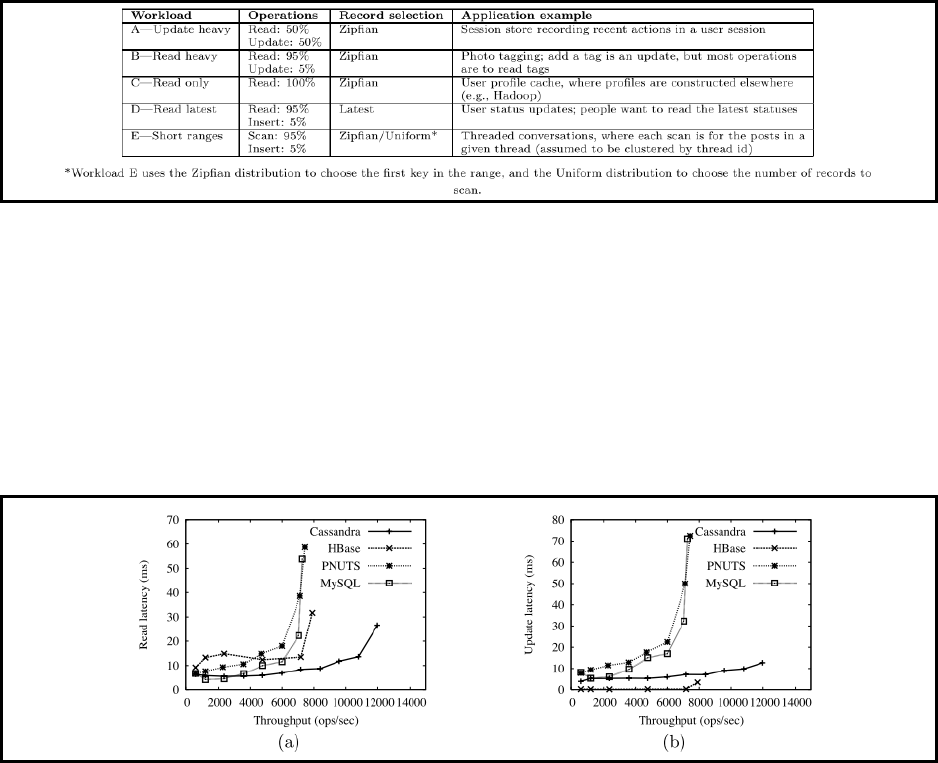
TRANSITIONING FROM RELATIONAL TO NOSQL 24
In order to demonstrate the YCSB tool, Cooper et al. (2010) present benchmarking
results for four distributed database systems: Cassandra, HBase, PNUTS and sharded MySQL.
These results provide a valuable insight in to how a distributed relational system might compare
against a NoSQL system under certain conditions. Five workloads were created and these are
detailed in Figure 6.
Figure 6. YCSB Workloads (Cooper et al., 2010)
Results for performance are presented in a graph of Read latency (measured in
milliseconds) versus throughput (measured in total operations per second, reads and writes).
Workload A results, shown in Figure 7, indicate that the NoSQL systems (Cassandra and HBase)
perform better for update-heavy workloads consisting of an equal amount of reads and updates.
Figure 7. Workload A results - (a) is read operations and (b) is update operations (Cooper et al.,
2010)
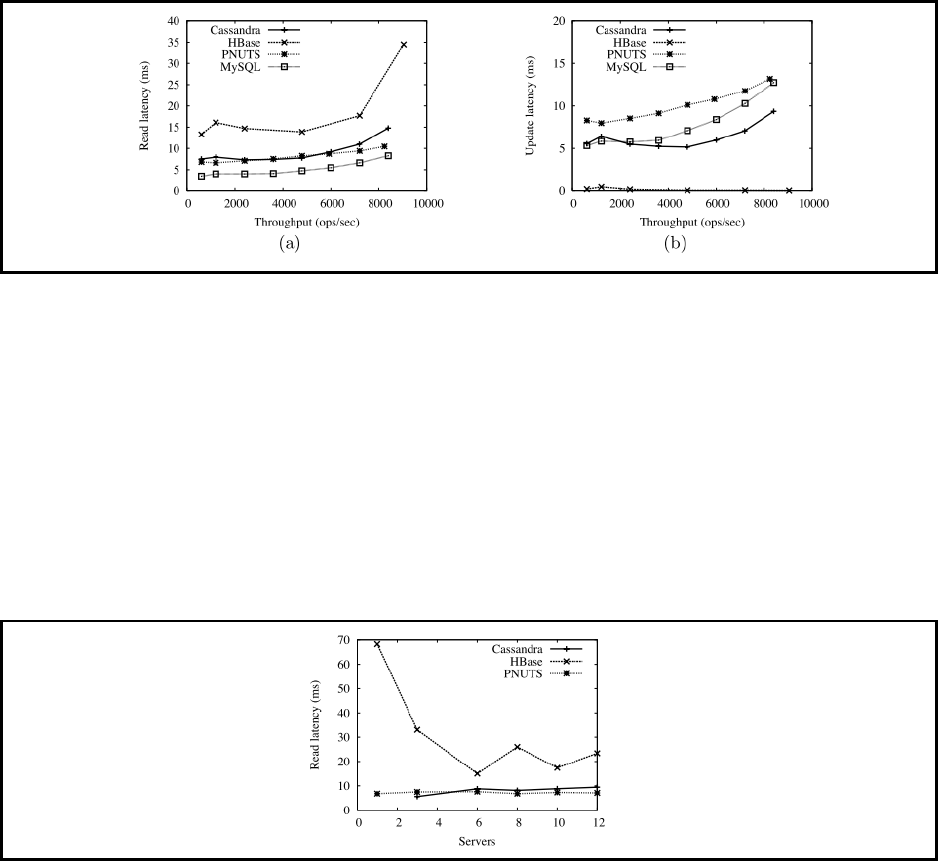
TRANSITIONING FROM RELATIONAL TO NOSQL 25
The read-heavy operations of workload B, however, show that the sharded relational
system performs significantly better than the NoSQL systems (Figure 8), indicating again that
NoSQL is a more suitable candidate for write-heavy or update-heavy types of applications.
Workloads C (read only) and workload D (read latest) also indicated that the sharded MySQL
system performed better for these operations.
Figure 8. Workload B results - (a) read operations, (b) update operations (Cooper et al., 2010)
The remainder of the tests focus on the tier 2 benchmarks, scalability and elasticity. To
test scalability, performance is measured with a varying number of servers. The load is increased
proportionally with each server added, which should produce a straight line result. This is shown
to be the case in Figure 9, apart from HBase which only begins to perform consistently at a
higher number of servers. MySQL is omitted from this test which is unexplained by the authors.
Figure 9. Scalability test (Cooper et al., 2010)

TRANSITIONING FROM RELATIONAL TO NOSQL 26
The final set of tests demonstrate elasticity by measuring performance as a single server
is added to a cluster. Results were expected to show high latency at the point where the server is
added before returning to a consistent level. However, as Figure 10 shows, this was not exactly
the case, in particular with Cassandra which performed erratically after the server was added.
The sharded MySQL system is automatically omitted from this test on account of being
“inherently inelastic”, giving an instant win for NoSQL systems in this area.
Figure 10. Elasticity results (Cooper et al., 2010)
The YCSB benchmark results presented by Cooper et al. (2010) provide a solid
foundation for testing the performance of NoSQL systems in comparison with a distributed
relational system. The results predominantly match the claims of the NoSQL systems, but there
are some exceptions, particularly in the elasticity tests, indicating that vendor claims need to be
fully tested before a system can be put to use. There are other factors, such as availability and
replication which have not been addressed and this provides an area for further research.
Challenges for NoSQL Adoption
Despite the advantages of NoSQL, there are a number of challenges facing vendors that
must be addressed before widespread adoption can occur.
TRANSITIONING FROM RELATIONAL TO NOSQL 27
Vendor Support.
Although there are many different NoSQL vendors, many are community driven and do
not provide any formal support structure. Most businesses will look for the assurances of a
support contract when choosing a database system to prevent any potential data loss or
unavailability of data. Some NoSQL vendors however do provide a support option for enterprise
level applications. The initiator and sponsors of MongoDB, 10gen, offer two support packages
with varying levels of support for an annual fee of either $2,500 or $4000 per cluster node
(10Gen, 2012). Riak provides an Enterprise license for their database system which includes
24x7 customer support, developer support and implementation consultancy at an annual cost of
$3,995 per cluster node (Basho Technologies Inc., 2012). Other vendors will need to follow suit
in order to penetrate the enterprise market.
Data Querying.
One of the main advantages of relational databases is the ability to query for data using
SQL. Apart from some minor differences between vendors, the SQL language can be used on
practically all relational database systems. Consequently, extracting data from relational
databases is a standardized process that has been in existence for nearly 40 years. People are
familiar with how to use SQL and it makes it easier to transfer from one relational DBMS to
another. Because NoSQL is relatively new technology, a standardized query language that is
capable of extracting data from all NoSQL database types has yet to be developed. There are
efforts in existence that are attempting to achieve this, one of which is UnQL, an unstructured
query language for JSON, semi-structured and document databases (Young, 2011). However,
efforts on this project have slowed recently and it does not seem likely that it will be continued
(Celler, 2012).
TRANSITIONING FROM RELATIONAL TO NOSQL 28
Relational databases are all based on the use of tables to store data and therefore a
universal language is easier to create. With NoSQL, there are several different approaches to
storing data, as discussed above, therefore making it more difficult to create a universal
language. SQL succeeded because it was easy to learn, easy to read and easy to understand. With
NoSQL, you either need to learn the query language that the vendor has created for each
individual product or be proficient in a programming language that is compatible with the
NoSQL system. For instance, Google has created its own query language called GQL which is
compatible with its own data store products such as Google Big Table (Google, 2012). Riak
bases its query language on Lucene, an open source search engine written in Java (Rowe, 2012).
These are two vastly different approaches to querying data and in the case of Riak and other
vendors that use Java based languages for querying, it is likely to deter people from transitioning
from the familiarity of relational databases and SQL.
Using Map-Reduce for data retrieval.
One area of querying where NoSQL vendors do seem to be united on is the use of Map-
Reduce for distributed queries. Map-Reduce is a model for processing large amounts of data that
is distributed over a large number of nodes, in order to produce a set of derived data. Essentially,
Map-Reduce is a method to abstract the complexity of parallelization, fault tolerance, data
distribution and load balancing that is required when running computations across hundreds or
thousands of nodes (Dean & Ghemawat, 2008). A Map-Reduce operation is capable of retrieving
data at rates of up to 30GB/s by using its approach of assigning worker threads to each node in
the cluster to process the data and then merging the output of these worker threads in to one final
result (Dean & Ghemawat, 2008).
TRANSITIONING FROM RELATIONAL TO NOSQL 29
Map-Reduce is a concept that transfers well to NoSQL environments. If the data is
sharded across several nodes, the database engine can dispatch the Map-Reduce job to all of the
nodes and run them in parallel. This allows even the largest databases to return the results of
queries very quickly in a “divide and conquer” approach. Because of the way Map-Reduce
iterates over data in a collection, it is possible to aggregate data which have fields with matching
values and store these computations in secondary collections. As a result, Map-Reduce functions
are an ideal replacement for SQL GROUP BY statements that would be found in a relational
database.
Immaturity of the technology.
NoSQL databases have only been in existence for a matter of years and many vendors are
still in beta stage or are releasing updates continuously. This could be unsettling for potential
adopters of the technology as most are looking for ultra reliability in the system that is managing
their critical data. Software often needs to go through many minor and major revisions before
bugs are discovered and patched.
The immaturity of the technology also brings a shortage of expertise in the field.
Relational database systems have built up sizeable knowledge bases and technical papers to
assist users in the deployment and use of their system. With NoSQL, many adopters are taking a
“learn as we go” approach, which may not be to everyone’s liking. For example, Foursquare, the
location based social network were one of the first major users of MongoDB and they suffered
an 11 hour outage early in their NoSQL adoption because of a flaw in their design which led to
uneven growth of their partitions in the database which eventually resulted in the database
having to be taken offline (Bodkin, 2010). As a result, the creators of MongoDB used this
incident to improve the reliability of their system and the learning’s were passed on to other

TRANSITIONING FROM RELATIONAL TO NOSQL 30
users through the MongoDB community, but, this episode does indicate that there may be
potential issues with the software that the vendors have not yet encountered.
TRANSITIONING FROM RELATIONAL TO NOSQL 31
Chapter 3 - Methodology
Introduction
This section will outline the methodology used to convert an existing PHP/MySQL
application to a NoSQL application. The relational model used for the bulletin board application
will be discussed first and subsequently outline how this model can be converted to a NoSQL
system. By comparing the chosen NoSQL database to a relational database, the existing
relational schema can be converted to a NoSQL schema. This model will then form the basis for
a new version of the PHP application which will need to be converted to work with the NoSQL
schema.
This chapter will also describe how test data was loaded to both the relational database
and the NoSQL database for the purposes of performance analysis. The last section of the
chapter describes how both databases were set up and deployed.
Use Case
Choosing a data storage platform for an application is no longer the straightforward
choice that it once was. The relational database was, by and large, the only option available and
usually the decisions at this level revolved around what vendor to choose and what version of
DBMS from that vendor. But with new data storage technologies emerging, such as NoSQL,
designers are starting to evaluate data storage needs from a different viewpoint. Estimating the
volume of data that an application is likely to produce is becoming an increasingly difficult task,
particularly if the application is web enabled and accessible by an arbitrary number of users that
could potentially grow in to the millions. Therefore, scalability is now a much higher priority
than it may have been 15 to 20 years ago. The database must be able to grow in line with
TRANSITIONING FROM RELATIONAL TO NOSQL 32
potential demand and, as alluded to in the literature review, the cost of scaling up a relational
database can be a significant barrier. Increasing volumes of data also bring performance
considerations which must be addressed. Read and write operations can be adversely affected if
the database is not designed to cope with high volumes of data.
These are all problems that many users are facing with relational databases and for this
reason are starting to look at other options. NoSQL databases can potentially provide the
solution. They have better scaling capabilities because they can be horizontally scaled, they can
support large volumes of data with minimal impact to performance through Map-Reduce, and
they can provide a simpler method of implementing a distributed database. Some of the use cases
where this may be particularly beneficial include Content Management Systems, Ecommerce,
Online Games, Real-Time Analytics, Event Logging and the Operational Data Store for a
website (Merriman & Francia, 2011).
To evaluate these potential benefits, a single use case will be presented in this chapter to
provide a basis for comparison between a NoSQL system and a relational system. Online bulletin
board applications are widespread on the web today and are among the most popular destinations
for internet users. Many of these sites must be able to support thousands of concurrent users on a
24x7 basis, who are constantly producing new data and interacting with the database. These are
exactly they types of requirements to which a NoSQL system is potentially well suited.
However, many of these bulletin boards are PHP applications which use a relational
database for data storage. This can be attributed to the fact that sites like phpBB and vBulletin
offer free open source online bulletin board applications with this configuration. PHP and
MySQL are two closely knit technologies, but this does not necessarily mean that MySQL offers
the best solution for a PHP application such as this one. The use case presented in this chapter
TRANSITIONING FROM RELATIONAL TO NOSQL 33
will include a PHP application that connects to both a MySQL database and a comparable
NoSQL database. The intent is to show that a NoSQL database can work just as well as a
MySQL database as the operational data store for a PHP application and in particular situations
can actually provide a better solution.
Application Details
There are many options available in terms of creating a bulletin board application. The
aforementioned vBulletin and phpBB applications provide “off the shelf” frameworks which
allow anyone to create a customized bulletin board application instantly. These frameworks
provide a rich set of features such as search optimization, security add-ons like captcha, email
verification, granular privileges etc., user management functions, customizable styles and many
more (phpBB, 2007; vBulletin Solutions, 2012).
Although either of these systems would be ideal to use as the basis for the use case in this
methodology, converting either to use a NoSQL back-end would be a considerable project. For
this reason, an application with a subset of this functionality was chosen as the basis for the use
case. This application is presented in (Naramore & Glass, 2005). It is a basic PHP/MySQL
bulletin board application. As well as post and forum creation, the application has the following
additional functions:
• User Authentication
• Search Engine
• Board Administration
• Regular Expressions for post formatting
• Pagination to limit the number of posts per page
TRANSITIONING FROM RELATIONAL TO NOSQL 34
The application interacts with the relational database for all of these functions and
therefore affects the amount of time required to load a page. At small amounts of data and users,
this time will be unnoticeable to the end user. But as the number of concurrent users grows and
the database size increases, this time will eventually reach a point where performance is
negatively affected to the point where the application becomes unusable. At this point, a course
of action must be taken to ensure that the application can continue to operate in a usable manner.
Assuming that this application is running on a single database server, there are a number
of options available to improve the performance of this application. One is to upgrade the
hardware of the database server to increase transaction performance. This might include the
addition of memory, a faster CPU, quicker hard disks in a striped configuration etc. One would
need to analyze the system to determine where the bottlenecks are in the system and what
particular hardware can alleviate this bottleneck. This approach can provide a “quick fix” to
performance problems. In the long term however, this approach will not prove successful. A
further increase in user traffic in the future will require further upgrades leading to exponential
cost increases for hardware and eventually reaching a point where upgrading is no longer
possible.
A second option is to add a second database server and implement a partitioning strategy
so that data is divided between the two servers thereby halving the workload of the single server
system. This approach will prove effective at improving performance but it also adds a layer of
complexity to the application layer which may prove to be overwhelming for developers and
unsustainable if the application requires additional servers in the future.
Replication is also a common methodology used to improve the performance of a
database application. This involves copying the data from the main database server to one or
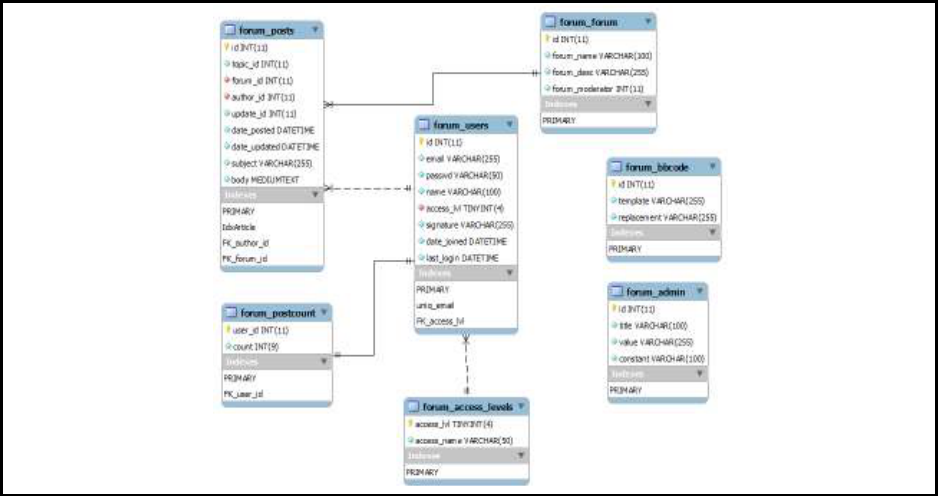
TRANSITIONING FROM RELATIONAL TO NOSQL 35
more replicas. The replicas can then be used for read operations allowing the writes to happen
exclusively on the main server.
This study proposes that a NoSQL database provides a further option for improving
application performance. MongoDB, which will be used in this case study, provides automatic
replication and sharding, thereby combining both of the options discussed above without the
complexity overhead. This methodology will describe how an application can be converted to
using MongoDB to take advantage of these features.
Database Description
The application uses a MySQL relational database for storage of all persistent data. This
includes user registration details, user posts, forum metadata and configuration data such as the
board title and pagination limits. The schema for the database is shown in Figure 11.
Figure 11. Bulletin Board Relational Schema

TRANSITIONING FROM RELATIONAL TO NOSQL 36
MySQL offers pluggable data storage engines, the two most common of which are
MyISAM and InnoDB. The original schema for this application uses the MyISAM engine for all
tables, however, as of MySQL 5.5, the default engine is now InnoDB. The main feature
differences between MyISAM and InnoDB are outlined in Figure 12. Traditionally, MyISAM
was seen as the better performing option, but recent benchmark tests have shown that with more
relaxed ACID constraints, InnoDB can perform comparably with MyISAM while providing
additional benefits such as crash recovery, referential integrity and scalable performance
increases (Oracle, 2011). For this reason, the InnoDB engine was chosen as the default for this
application.
Figure 12. Comparison between MyISAM and InnoDB Storage Engines
Most of the activity in this database will occur in the forum_posts table as users create
and update posts through the web interface. The majority of activity will be inserts as users

TRANSITIONING FROM RELATIONAL TO NOSQL 37
create new posts as either the initial post in a new topic or a reply to a post in an existing topic.
There will also be a significant amount of updates as users and moderators edit existing posts.
Frequently accessed columns are also indexed in this table; idxArticle is a multi-column index on
the fields forum_id, topic_id, author_id and date_posted.
The original application from Naramore & Glass (2005) provides a full-text index on the
subject and body fields. However, the InnoDB engine that will be used in this application does
not support full-text searches
3
and therefore will be excluded.
The next largest table to this will be the forum_users table which holds the data for all
registered users. A new user registration will produce an insert while any changes to user profiles
will produce an update. There is also a separate table for storing the number of posts a user has.
Transactions on this table will be predominantly updates. The other tables in the schema are
mainly used for site metadata and configuration data and therefore the majority of transactions
will be reads.
Application Description
The application consists of 21 PHP files, some of which contain the embedded HTML
required to display the content in a web browser, and the remaining of which are pure PHP used
for scripting and database interaction. The files that are of most interest in the context of
database performance are those that initiate a connection and subsequent transaction on the
MySQL server. These files will be described in this section.
3
Full-text search is due to be added to InnoDB in the upcoming 5.6.4 release of MySQL
TRANSITIONING FROM RELATIONAL TO NOSQL 38
Starting with the home page, index.php, a request to this page alone creates several
transactions in the database. Initially, there are three other files included with this file: conn.php
which creates the connection to the database, functions.php is a helper file containing useful
functions and header.php which displays the header for the site. Cascading from here, header.php
includes the file config.php which queries the database for the site administration data contained
in the forum_admin and forum_bbcode tables. The index.php page then queries the forum_forum
table to get a list of the forum names and the forum_posts table to get a count of the number of
threads in each forum.
Progressing from the index.php page, a user will either choose to log in, register or view
forum. The log in and registration functions both post to the file transact-user.php which contains
the functionality to create and modify user information in the database. This file reads an
“action” parameter sent by the posting page and interacts with the forum_users table accordingly.
The actions are as follows:
• Login Action: Reads from forum_users to check the given email and password
combination and then updates this table with the last login time for this user.
• Create Account: Writes the new user information to the forum_users table.
• Modify Account: Updates the supplied information in the forum_users table.
• Edit Account: Reads the users existing password from the forum_users table for
verification and then updates the supplied user information.
• Send Reminder: Reads the users existing password from the forum_users table.
TRANSITIONING FROM RELATIONAL TO NOSQL 39
Choosing the option to view a forum brings the user to the viewforum.php page. This
page retrieves a list of the threads in the selected forum, the originating author of the thread, the
number of posts in the thread and the date of the last post.
Clicking on any thread will load the viewtopic.php file. This file calls the showTopic
function, which is defined in the file functions.php, along with many other functions that are
used throughout the application. The showTopic function retrieves all of the post details from the
database to be displayed in the browser. This includes the post subject, body, author and date, as
well as the number of posts each user has made and the users signature. This function triggers a
series of read transactions in the database involving the forum_posts, forum_forum, forum_users
and forum_postcount tables.
Logged in users have a number of additional options in using the application. In terms of
database transactions, this mainly involves updating the user profile, which has been discussed
already, and creating and editing posts, which will be the predominant activity during normal
application operation. Transactions related to forum posts are contained within the file transact-
posts.php. This file operates in a similar manner to the transact-user.php file, reading an action
parameter from the posting file and responding accordingly. The actions it performs are as
follows:
• Submit new post: Writes a new post to the forum_posts table and upserts the
forum_postcount table
• Create a new topic: Performs the same action as submitting a new post but with a
new topic id.
• Update existing post: Updates the specified post in the forum_posts table.
• Delete a post: Deletes the specified post from the forum_posts table.
TRANSITIONING FROM RELATIONAL TO NOSQL 40
A user logged in with elevated privileges can also carry out a number of admin functions
which will also initiate transactions in the database. The transact-admin.php and transact-
affirm.php encapsulate this functionality. The type of transactions carried out by these files are
CRUD operations on the forum definitions and the application data (forum_forum and
forum_admin) tables. Admin users can also modify and delete posts, but this is just an extension
of the transactions already described in the transact-posts.php file. The level of database activity
generated by admin users will be fractional compared to normal users however it should be noted
that deleting a forum will cause a cascading delete of all the posts in that forum and this function
is only available to an admin user.
Choosing a NoSQL Database
MongoDB was selected as the NoSQL database to use for this use case. The reasons for
choosing MongoDB were:
• A reasonably simple evolution from a relational database can be achieved;
• It works at small and large scale, unlike other NoSQL databases, such as
Cassandra and HBase, which are only suited to very large scale deployments.
• It has the capability to replicate any complex queries that may be encountered in a
complex relational database.
MongoDB is a document oriented database where data is stored in schema-less
documents which have a unique identifier (the document id). Documents are grouped in to
collections and each document within a collection can have an arbitrary number of fields. It
supports indexing of fields in the same way as a relational database, however there are no joins
TRANSITIONING FROM RELATIONAL TO NOSQL 41
between collections. It provides easy scalability through automatic sharding of data across
servers and high availability through replicated servers with automatic failover.
Documents in MongoDB are stored as BSON documents, which is short for Binary JSON
(JavaSript Object Notation). JSON is a language independent “lightweight data-interchange
format” (“Introducing JSON,” n.d.). It is a basic human readable format that is built around a
collection of key/value pairs or an ordered list of values. A value can be a string, number, object,
array, Boolean type or null. Below is a sample JSON document:
{
"Car": {
"Doors": 4,
"Instructor": 600,
"Title": "View from 15th Floor",
"Engine": {
"CC": "2.0",
"Fuel": "Petrol"
},
"Colours": ["Blue","Black","Red","Silver"]
}
}
BSON then, is a “binary-encoded serialization of JSON-like documents” (Creative
Commons, n.d.). It expands on the JSON format by adding data types such as Date and BinData.
BSON documents can be traversed easily, are lightweight, and can be easily encoded and
decoded in most languages (Creative Commons, n.d.).
MongoDB Comparison to Relational Database.
When converting a relational database to MongoDB, it is important to take a comparative
look at the objects in MongoDB and how they relate to a relational database. At the top level, a
database in MongoDB is conceptually equivalent to a relational database. The major difference
to note is that the database does not need to be explicitly created in MongoDB, it is implicitly
created once the first document is inserted.
TRANSITIONING FROM RELATIONAL TO NOSQL 42
A collection in MongoDB is analogous to a table in a relational database (Murphy &
Chodorow, 2012a). Instead of containing rows, a collection contains documents which are in
BSON format. Every document has an “_id” field, but apart from this, a document can have a
varying number of fields and all documents in a collection do not have to contain the same fields,
unlike in a relational table where each row will have the exact same set of fields. Even though
the document structure is flexible, the design from the outset should identify the specific fields
required in each document to allow the application to be built around it.
Indexes are supported in MongoDB and are conceptually similar to indexes in relational
databases (Murphy & Chodorow, 2012b). The basic storage format for a MongoDB index is the
B-Tree and they can be created on any field in a document. The _id field automatically has an
index created on it, much like the primary key of a relational table.
Another important concept in MongoDB is sharding. This allows a collection to be
partitioned across several nodes in a cluster if a collection becomes too large to perform
sufficiently on a single node. MongoDB supports automatic load balancing of shards so that the
volume of data on any particular shard does not become proportionally greater than any other
shard. Sharding is conceptually similar to the partitioning in a relational database. . below
summarizes the comparisons between MongoDB and relational databases.

TRANSITIONING FROM RELATIONAL TO NOSQL 43
Table 1. Comparison between MongoDB and RDBMS
RDBMS MongoDB
Table Collection
Row BSON Document
Index Index
Join Embedding & Linking
Partition Shard
Designing the Schema.
In order to convert the PHP application to use MongoDB, the first task is to design a
schema for the database. To create the schema for the MongoDB database, I analysed the
relational schema to determine what data points are required and how this data is structured. This
information can then be used to organize the data in to the format that fits the MongoDB engine.
This schema will then be used as the basis for the analysis chapter where a number of changes
will be implemented to evaluate the effect this has on the application code and functionality.
Using the concepts and the table from the previous section, the MongoDB schema was
designed by converting the artefacts from the MySQL schema in to their equivalent MongoDB
artefacts. Tables will map to collections, as shown in Table 2.

TRANSITIONING FROM RELATIONAL TO NOSQL 44
Table 2. Mapping Tables to Collections
Table Collection
forum_users users
forum_posts posts
forum_forum forum
forum_admin forum_admin
forum_postcount postcount
forum_access_levels access_lvls
One of the main differences in NoSQL databases is that joins are not supported in the
same way as in relational databases. Collections can be linked through fields at the application
level but this will require an extra lookup for every link in the query. With this in mind, one of
the goals when converting from relational to NoSQL should be to minimize linking where
possible. Applying this concept to the proposed schema above, and referring to the schema
diagram in Figure 11, a possible area where links can be eliminated immediately is the one-to-
many relationship between forum_users and forum_postcounts, and forum_users and
forum_access_levels. The “one” side in these relationships contain only a minimal amount of
data (one field in both cases) and can be easily absorbed in the users collection. This reduces the
list of collections to:
• users
• posts
• forum
• forum_admin

TRANSITIONING FROM RELATIONAL TO NOSQL 45
To assess the impact of this change, we must first deduce why the schema was designed
like this in the relational database. In the case of the forum_access_levels table, a logical
explanation for keeping this separate to the forum_users table is to prevent insert anomalies –
new access levels can be added without the need to add a row to the users table. Furthermore, an
application can easily retrieve a list of access levels (to populate a control for example) by
issuing a SELECT query on the forum_access_levels table. Otherwise, retrieving such a list
would require issuing a SELECT DISTINCT query on the forum_users table. De-normalizing
these tables in the MongoDB schema raises the same concerns, however as will be demonstrated
in the Analysis chapter, it is preferable to design the schema in this way than to have three
collections with links.
When the collections have been identified, the next task is to add in the field names that
will be used in the JSON document. Again, the field names from the relational schema were used
as the basis for this. Tables 3 to 6 below list the details for each collection, including the data
type, an example value and the purpose of the field.
Table 3. MongoDB users Schema
users
Key Data Type Example Purpose
_id integer 234 Default ID Field
name string John Doe Users full name
Users email address
date_joined date 2012-01-01T13:15:41 Date the user joined
last_login date 2012-07-12T14:56:43 Date of last login
signature string Signature appended to each post
post_count integer 1025 Number of posts
access_lvl integer 3 Users access level

TRANSITIONING FROM RELATIONAL TO NOSQL 46
Table 4. MongoDB posts Schema
posts
Key Data Type Example Purpose
_id integer 221
Default ID Field
author_id integer 234
Link to the id of the poster (users)
forum_id integer 4
Link to the id of the forum (forum)
subject string Recipe for success The subject of the post
body string Work hard every
day…
The body of the post
date_posted date 2012-04-
12T12:13:32
Date the post was entered
date_updated date 2012-04-
12T12:13:32
Date the post was updated
update_id integer 65
Link to the id of the updater (users)
topic_id integer 21
Identifier for the thread
Table 5. MongoDB forum Schema
forum
Key Data Type Example Purpose
_id integer 2
Default ID Field
name string StackApps Name of the forum
description string Posts from Stack
Apps
A description of the forum
moderator_id integer -11
Link to the id of the moderator (users)
Table 6. MongoDB forum_admin Schema
forum_admin
Key Data Type Example Purpose
_id integer 2
Default ID Field
constant string titlebar A reference name for the code
title string description Key
value string StackApps Value
Data Types in MongoDB.
As MongoDB uses BSON documents, which is a “binary-encoded” serialization of
JSON-like documents” (Creative Commons, n.d.), all of the standard JSON data types are
TRANSITIONING FROM RELATIONAL TO NOSQL 47
available. This includes string, integer, Boolean, double, null, array and object. There are also a
number of additional types – date, object id, binary data, regular expression and code – which are
each implemented in language specific ways depending on the driver being used (Chodorow &
Merriman, 2011). In this case, the PHP driver supports saving and querying of data in all basic
PHP data types, compound arrays and a number of other classes such as Date, Regex, Timestamp
and DBRef, as well others listed at (The PHP Group, 2012).
Test Data
For the purposes of testing the PHP application, both the relational database and the
MongoDB database must be loaded with test data. Stack Exchange is a popular network of
forums where users can get answers to questions on a range of topics from their peers. With over
87 sites in the network, each site produces a large amount of user generated data every day. This
data is made publically available under the Creative Commons cc-wiki license (Atwood, 2009)
every three months as XML “data dumps”. It is ideally suited for testing the PHP application in
this study for the following reasons:
• It fits well with both the relational schema and the NoSQL schema, mainly
because the Stack Exchange sites are bulletin board type applications themselves.
• Each three-monthly data dump is 4-7GB which provides a significant volume of
data for performance testing purposes.
• The data is in XML format which can be easily parsed by the PHP application.
Test data format.
The data from each site is packaged in a zip file containing six XML files:
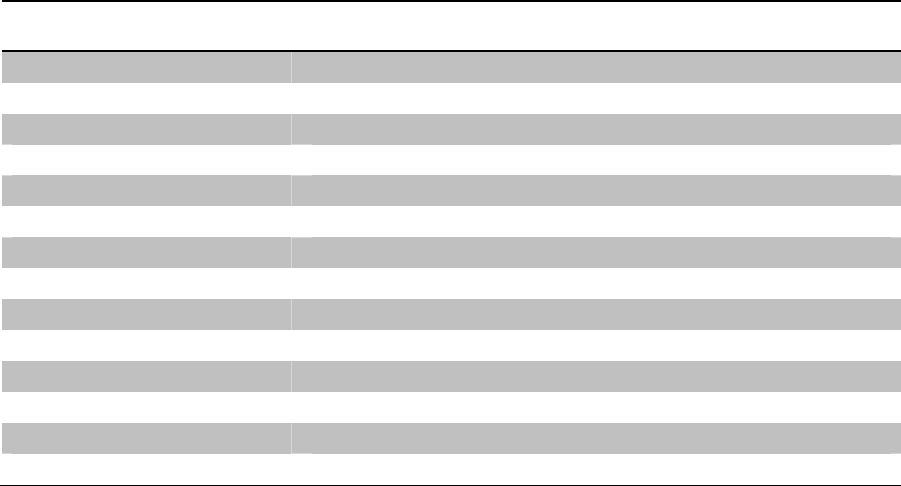
TRANSITIONING FROM RELATIONAL TO NOSQL 48
• badges.xml
• comments.xml
• posts.xml
• posthistory.xml
• users.xml
• votes.xml
Initially, the posts.xml file and the users.xml file were used as the source data to load.
Each of these files has a defined list of fields which are described in
Error! Reference source
not found.
and
Error! Reference source not found.
Error! Reference source not found.
.
Table 7. users.xml format
users.xml
Field Description
Id Unique Identifier
Reputation Users reputation score
CreationDate Date the account was created
DisplayName Users display name
EmailHash A hash of the users email
LastAccessDate Date of last login
WebsiteURL URL of the users website
Location Users location
Age Age
AboutMe A short profile
Views Number of times user has viewed a post
UpVotes The number of times user has up voted a post
DownVotes The number of times user has down voted a post

TRANSITIONING FROM RELATIONAL TO NOSQL 49
Table 8. posts.xml format
posts.xml
Field Description
Id Unique Identifier
PostTypeId Integer identifying post type (1=Question, 2=Answer)
ParentID The ID of the parent post (Only if post is an answer)
AcceptedAnswerId The ID of the post accepted as answer (Only if post is a
question)
CreationDate Date the post was created
Score Community score of the post
ViewCount Number of times post has been viewed
Body The body of the post
OwnerUserId The user id of the poster
LastEditorUserId The user id of the last editor
LastEditorDisplayName The display name of the last editor
LastEditDate The date the post was last edited
LastActivityDate The date of the last activity on the post
CommunityOwnedDate
ClosedDate The date the post was closed
Title The title of the post
Tags A list of tags describing the post
AnswerCount The number of answers (if post is a question)
CommentCount The number of comments on the post
FavouriteCount The number of users who have marked the post as a favourite
Mapping the test data to the schema.
Having described the fields available, the next step is to map these fields to both the
relational schema and NoSQL schema. Some fields will match exactly to those in each of these
schemas while others require a level of improvisation. There are also other fields that will not be
used in the mapping, but will have a role to play in the import code.
Error! Reference source
not found.
and
Error! Reference source not found.
Error! Reference source not found.
lists
the mappings for the relational schema.

TRANSITIONING FROM RELATIONAL TO NOSQL 50
Table 9. Relational Schema Mapping: forum_users
forum_users
Table field users.xml field
id Id
date_joined CreationDate
name DisplayName
email EmailHash
last_login LastAccessDate
signature WebsiteUrl
passwd N/A (password will be randomly generated)
access_lvl N/A (Access level will be randomly assigned)
Table 10. Relational Schema Mapping: forum_posts
forum_posts
Table field posts.xml field
id Id
topic_id ParentID (if post type is 2, otherwise set to 0)
forum_id N/A (Set manually depending on the forum posts are being
imported for)
author_id OwnerUserId
update_id LastEditorUserId
date_posted CreationDate
date_updated LastEditDate
subject Title
body Body
The NoSQL schema will be mapped in a similar fashion. Each field in the specified
collection will have a corresponding field in the xml files. The details are listed in
and
Error! Reference source not found.
below.

TRANSITIONING FROM RELATIONAL TO NOSQL 51
Table 11. NoSQL Schema Mapping: users
users
Collection field users.xml field
id Id
date_joined CreationDate
name DisplayName
email EmailHash
last_login LastAccessDate
signature WebsiteUrl
passwd N/A (password will be randomly generated)
access_lvl N/A (Access level will be randomly assigned)
post_count Set to 0 for initial import
Table 12. NoSQL Schema Mapping: posts
posts
Table field posts.xml field
id Id
topic_id ParentID (if post type is 2, otherwise set to 0)
forum_id N/A (Set manually depending on the forum posts are being
imported for)
author_id OwnerUserId
update_id LastEditorUserId
date_posted CreationDate
date_updated LastEditDate
subject Title
body Body
Loading the Test Data.
The PHP code for loading the test data to both the relational database and the MongoDB
database is straightforward. The XML file is loaded in to the PHP function simplexml_load_file
TRANSITIONING FROM RELATIONAL TO NOSQL 52
which returns an object of class SimpleXMLElement, an array like structure which can be used
to iterate through the individual elements of the XML file. As the code iterates through the
object, the elements needed from the array are assigned to individual variables. In the case of the
relational schema, I then executed an INSERT statement using the previously set variables as the
parameters for the insert statement. For MongoDB, all the variables are added to an array and I
used the MongoDB insert function provided by the PHP driver which takes the array as a
parameter and adds the data to the specified collection as a BSON document. Appendix C and
Appendix D contains the source code required for loading the test data to the MySQL database
and the MongoDB database.
Deployment
In this section, will describe how the application was set up from an infrastructure point
of view. In order to deploy this application a web server is required to serve the PHP web pages
and a database server is required to hold the data for the application. This server will initially
host a MySQL database and subsequently a MongoDB database. An additional number of
servers will be required to facilitate replication and failover.
Amazon EC2 Instances.
Amazon Elastic Cloud Compute (EC2) was chosen as the platform to deploy all of the
required servers for the application. EC2 is a pay as you go web service that allows new server
instances to be deployed in minutes to Amazon’s computing environment, making it an ideal
service for scaling up or down as required (Amazon, 2012a). Instances are deployed to the cloud
as preconfigured Amazon Machine Images (AMIs). There are a range of instance types available
TRANSITIONING FROM RELATIONAL TO NOSQL 53
offering varying amounts of computing power. In this study, all instances used were Micro
instances which provide:
• 613MB of memory;
• Up to 2 ECUs;
• 32-bit or 64-bit platform;
• Elastic Block Store (EBS) storage which is off-instance storage that persists
independently from the life of the instance itself (Amazon, 2012a).
Web Server Setup.
One of the easiest ways to create a web server is to use a LAMP stack. This is an
acronym for a server running a Linux operating system with Apache web server, MySQL
Database and PHP components (or Python or Perl). To create a LAMP stack on Amazon EC2,
one option would be to use the standard Linux instance and install each of the other three
components individually. A more efficient way to create the LAMP stack is to use a
preconfigured image from the Amazon Web Services Marketplace
The AWS Marketplace is an online shop which allows third parties to sell software to
AWS users in the form of pre-configured Amazon Machine Images (AMIs) which can be
deployed directly to the cloud as an EC2 instance (Amazon, n.d.-a). This allows software to be
deployed and made publicly available in a matter of minutes. Furthermore, the image will be pre-
tested and will be more reliable than a manually configured server. Rather than paying a license
fee for the software, users are charged per hour for use of the software in addition to the standard
EC2 charges.

TRANSITIONING FROM RELATIONAL TO NOSQL 54
There are many LAMP applications on AWS Marketplace. For this study I have chosen
one provided by TurnKey Linux. There is no charge to use the software and it has an easy to use
web management interface for configuration. To set up on EC2, the first task is to create an EC2
account. Once an account has been created, the instance can be launched from the AWS
Marketplace web page (Amazon, n.d.-b), as shown in Figure 13 below.
Figure 13. Launching EC2 Instance from AWS Marketplace
This screen requests a number of configuration settings for the instance:
• Version: If there are different versions of the application a specific one can be chosen. In
this case there is only one option.
• Region: The region that the instance is to run.
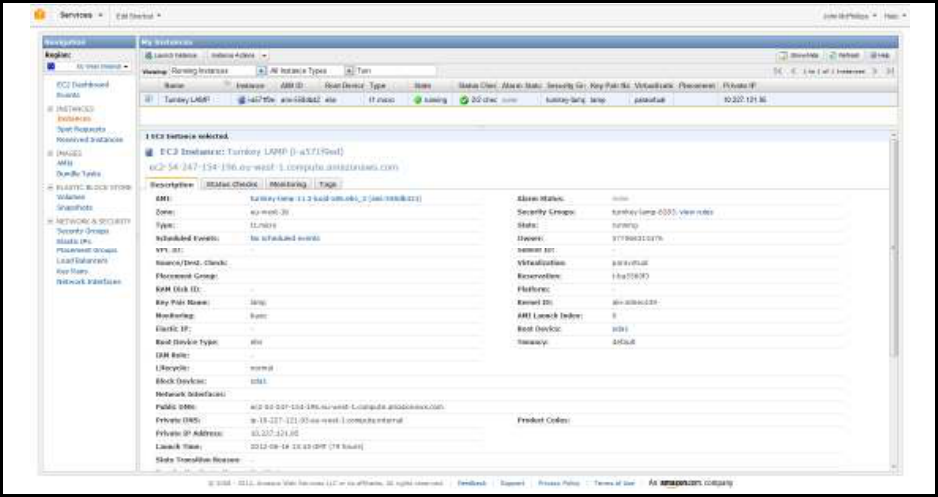
TRANSITIONING FROM RELATIONAL TO NOSQL 55
• EC2 Instance Type: The type of the instance. A micro instance was chosen in this case.
The instance type can be changed at a later date if volume increases on the web server.
• Firewall Settings: This is a list of firewall rules (termed security groups in AWS) that
define what traffic is allowed to connect to the server. This application provides a default
security group which allows traffic through ports for its web management interface
(12320-12322), MySQL connections (3306), SSH connections (22) and web traffic (80,
443).
• Key pair: This is the SSH public key which allows secure connections to be made to the
server. This key must be created within the EC2 management console. A private key can
then be downloaded to any clients connecting to the server to allow secure connections.
Once the configuration has been completed, clicking the “Accept Terms & Launch with
1-click” button will create the instance in EC2. After a few minutes the instance will be available
and can be managed further from the EC2 interface, shown in Figure 14 below:
Figure 14. LAMP Instance running in EC2
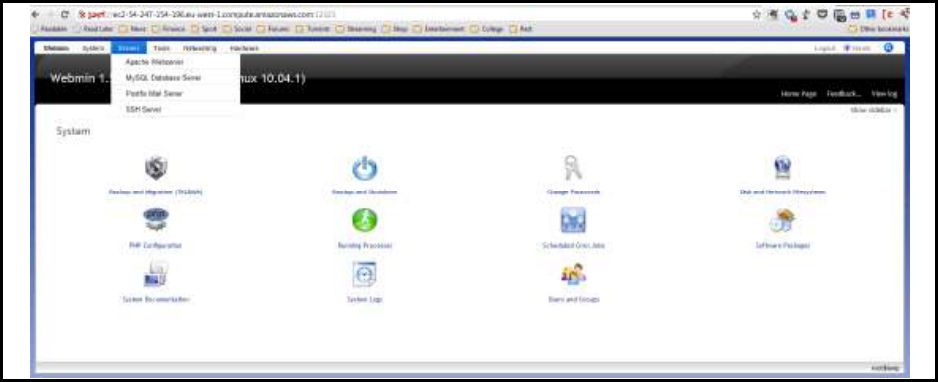
TRANSITIONING FROM RELATIONAL TO NOSQL 56
From here, the various instance parameters can be assessed, such as the public DNS name
of the server. This is needed for accessing the server through the management interface and
through SSH. Figure 15 below shows the management interface provided by Turnkey which is
accessed through port 12321.
Figure 15. Accessing the LAMP Management Interface
This DNS name is fine for accessing management features, but it is not ideal for
accessing any applications hosted on the server. A useful feature offered by Turnkey is the
ability to create a hostname on their website which is linked to the instance running on EC2. To
do this, details need to be registered with Turnkey. A hostname can then be entered for the
instance. In this case, the hostname is jmcp-lamp.tklapp.com, highlighted in Figure 16 below.
This interface can also be used to create an instance as an alternative to using the AWS
marketplace.
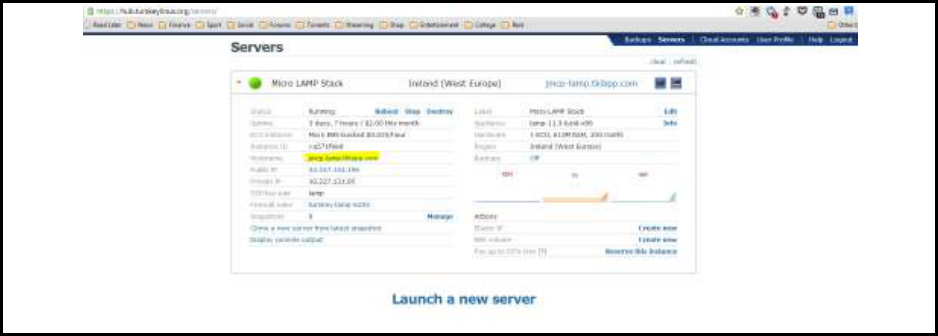
TRANSITIONING FROM RELATIONAL TO NOSQL 57
Figure 16. Defining a hostname
MongoDB Setup.
To create the MongoDB instances, I went again to the AWS Marketplace. The creators of
MongoDB, 10Gen, provide an AMI in the marketplace to allow consumers to easily get started
with using MongoDB. The process is the same as what was used earlier to create the LAMP
instance except this time it will be repeated two more times to make three instances in total.
Once the instances are launched they can be managed from the EC2 management interface.
Because the option is not available to assign a hostname in this case, three Elastic IP
addresses will be assigned to each of the MongoDB instances. Elastic IP addresses are static IP
addresses which can be assigned to any EC2 instance (Amazon, 2012b). If an instance is
restarted in EC2, the public DNS name will more than likely not be the same as it was
previously. Using an Elastic IP address provides a more consistent means to reference an
instance.
Once the instances are up and running, some additional configuration is required to start
the process on each instance and to ensure the process starts when the server is restarted (10Gen,
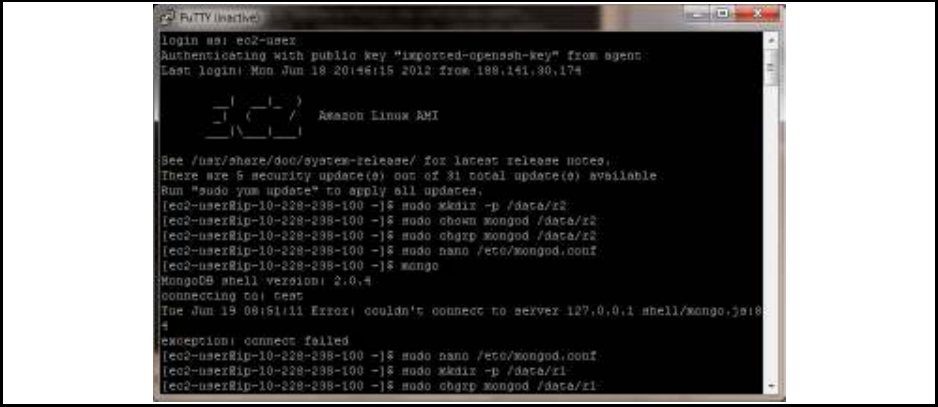
TRANSITIONING FROM RELATIONAL TO NOSQL 58
n.d.-a). This can be done through an SSH connection, as shown in Figure 17 below. The same
SSH key pair created earlier was used for authentication.
Figure 17. Connecting through SSH
To set up the MongoDB instances in a replica set, they must be able to communicate with
each other. Amazon EC2 instances are all given a private IP address for internal communication
between instances. To simplify configuration, an entry for each private IP address was added to
the /etc/hosts file. This allows communication to be set up through a host name rather than using
the IP address.
The default security group which was defined when the instance was created only allows
SSH connections through port 22. MongoDB instances communicate through node 27017 by
default so this was added to the security group. There is also a web interface for MongoDB
which runs on port 28017, this was also added to the security group. The complete security group
details are shown in Figure 18 below.
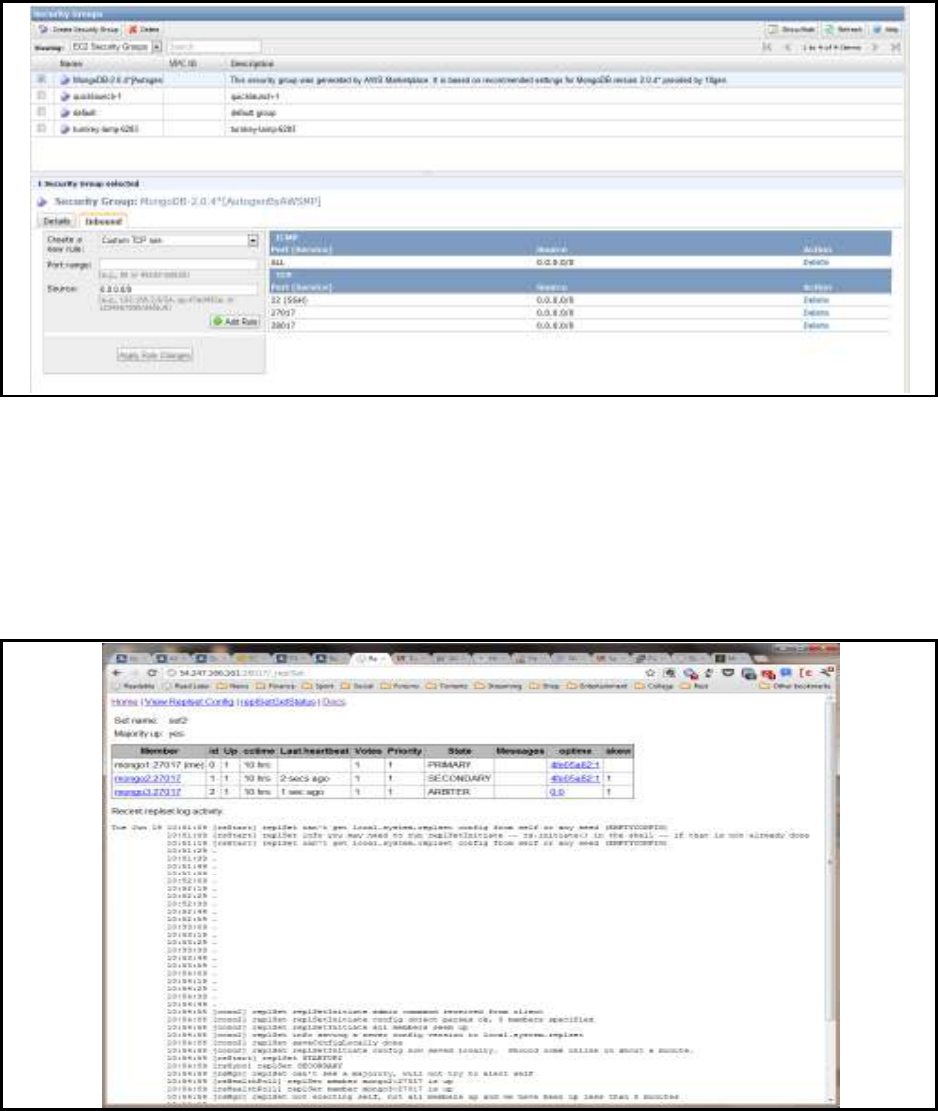
TRANSITIONING FROM RELATIONAL TO NOSQL 59
Figure 18. Security Group for MongoDB
The replica set can then be created using the process outlined in the MongoDB
documentation
(10Gen, n.d.-b)
and can be verified through the web interface, as shown in Figure
19 below.
Figure 19. MongoDB Web Interface
TRANSITIONING FROM RELATIONAL TO NOSQL 60
Chapter Summary
In this chapter, I have presented a PHP bulletin board application which uses a MySQL
database at its back end for data storage. The schema of this database was described in detail,
with a view to converting the schema to a NoSQL system. I have also presented MongoDB as a
candidate NoSQL system to facilitate this conversion. By making a comparison between
MongoDB and RDBMS artefacts, a MongoDB schema was designed to replace the relational
schema already in existence. This schema will now form the basis for our analysis in the next
chapter where the PHP application will be converted to use our newly created MongoDB
schema. I have also demonstrated how the application and the MongoDB database was deployed
to the Amazon EC2 web service.

TRANSITIONING FROM RELATIONAL TO NOSQL 61
Chapter 4 – Analysis
In this chapter, I will begin by analyzing the level of effort required to convert the PHP
application presented in the previous chapter from using a MySQL back end to a MongoDB back
end. Throughout the conversion process, I will analyze the differences between the relational and
non-relational systems in use. I will not discuss converting the entire application as many aspects
of the conversion are similar. Instead, a subset of pages from the PHP code will be chosen to try
to cover all of the MongoDB concepts required to carry out a complete conversion. For
reference, the source code for all pages discussed in this chapter can be found in Appendix A and
Appendix B. Once the conversion process is complete, a number of performance tests will be
carried out on both the MySQL and MongoDB versions of the application in order to compare
and contrast the performance characteristics of both systems. The chapter will conclude with an
implementation of a Map-Reduce function – the NoSQL approach to distributed queries and
aggregation.
Converting the PHP Code
The initial approach taken to convert the application is to analyze the database access
code in each of the pages of the application and try to create equivalent code to access the
MongoDB database. The steps taken were:
• Check each PHP page for SQL statements;
• Record each SQL statement in the page;
• Write down a logical sentence of what function the SQL statement is carrying out;
• Try to write data access code for MongoDB that produces the same result as the
SQL statement;
TRANSITIONING FROM RELATIONAL TO NOSQL 62
• If it is not possible to create equivalent MongoDB code, re-evaluate the
MongoDB schema design.
This will produce a first revision of our new PHP application which will be used for
further analysis and testing later. As each individual SQL statement is converted, I will begin to
develop a standard methodology in order to apply the approach to other relational based
applications.
To demonstrate the methodology in use, several of the PHP pages in our sample bulletin
board application will be converted. There are many candidate pages in this application that
require conversion. A subset of pages was chosen for this study. These pages have been carefully
selected in order to demonstrate a number of different query options available in MongoDB.
Converting read queries.
The first candidate page in the application that was converted is functions.php. This file is
a helper file containing functions which other pages in the application can use. Many of those
functions also contain SQL statements to retrieve information from the database. For each SQL
statement found in the file a table of information should be constructed, such as Table 13, which
details which PHP page the query is found in, the function within that page, the return type of the
function (if applicable) and an explanation of the purpose of the query.

TRANSITIONING FROM RELATIONAL TO NOSQL 63
Table 13. SQL Analysis for functions.php
File:
functions.php
Function:
getForum
Function Return Type:
Integer
SQL Statement:
SELECT forum_name as name, forum_desc as description,
forum_moderator as forum_mod FROM forum_forum WHERE id =
$id;
SQL Explanation:
Find the forum name, forum description and forum moderator id for
a given forum id
From a first pass analysis of this statement it is clear that this is a read operation. There
are two functions available in MongoDB for read operations: find() and findOne(). A filter can
be included by passing an array to either of these functions to retrieve only the data that matches
the array. This is the equivalent of the WHERE clause in the SQL statement. By default, find()
and findOne() will return all fields in the document or documents that match the criteria. To
retrieve only a number of specified fields, a second array can be passed to the function
containing the fields that are required. The find() function returns a cursor to the data which can
be iterated over, while the findOne() function will retrieve only one document from the
collection, regardless of how many documents satisfy the criteria, and the result is automatically
returned as an array in the PHP code. In this case findOne can be used since the search is for
only one document and also because it eliminates the extra step of transferring the result to an
array that would be required if find() were used. We can be sure that only one document will be
found because we are filtering on the _id field which must be unique. The resultant PHP code is
given in Figure 20.
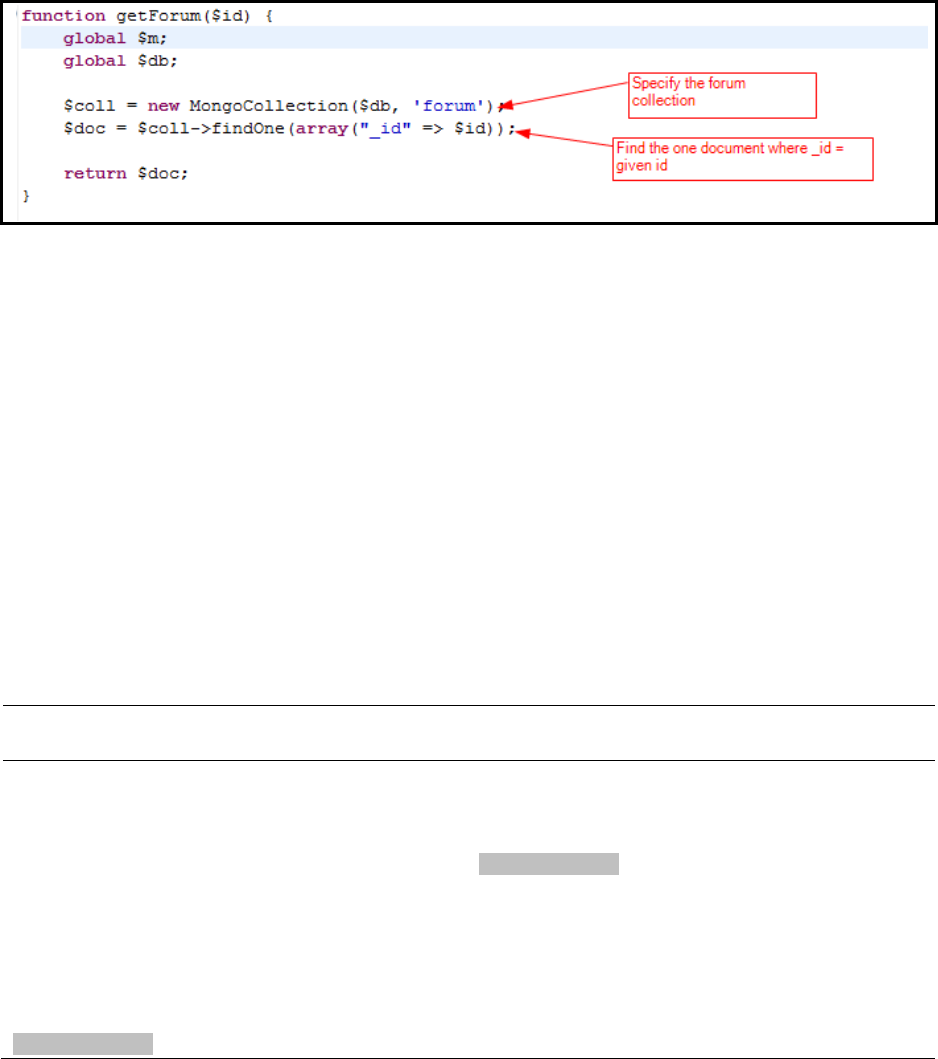
TRANSITIONING FROM RELATIONAL TO NOSQL 64
Figure 20. Converted PHP code for the getForum() function
This first conversion highlights one of the benefits of using MongoDB. The findOne
method returns an array of one row of information (to use relational terminology) from the
specified collection. In the MySQL code, the result of the SQL statement is returned as a
resource object and a further processing step is required to transpose this result in to an array,
using the function mysql_fetch_array. Table 14 below displays a comparison of the code
required for this operation with MySQL and MongoDB. Clearly, the MongoDB code is more
straightforward in this particular case.
Table 14. Comparison of PHP code for the getForum function
MySQL MongoDB
$sql = "SELECT forum_name as name,
forum_desc as description, forum_moderator
as forum_mod FROM forum_forum
WHERE id = " . $id;
$result = mysql_query($sql)
or
die
(mysql_error() . "<br>" . $sql);
$row = mysql_fetch_array($result);
return $row;
$coll =
new
MongoCollection($db, 'forum');
$doc = $coll->findOne(
array
("_id" => $id));
return $doc;
The next page that requires conversion is the index.php page, the default page for the
application. This page displays a list of the forums and some related information that are

TRANSITIONING FROM RELATIONAL TO NOSQL 65
currently available for browsing. There is only one SQL statement on this page, its details are
captured in Table 15.
Table 15. SQL Analysis for index.php
File:
index.php
Function:
N/A
Function Return Type:
N/A
SQL Statement:
SELECT f.id as id, f.forum_name as forum,
f.forum_desc as description,
count(forum_id) as threads, u.name as forum_mod
FROM forum_forum f
LEFT JOIN forum_posts p
ON f.id = p.forum_id
AND p.topic_id=0
LEFT JOIN forum_users u
ON f.forum_moderator = u.id
GROUP BY f.id
SQL Explanation:
Find each forum id, forum name, a count of threads and the forum
moderator
Replicating this statement in MongoDB presents a number of challenges. The first
element that jumps out from this statement is the presence of two joins. It was noted earlier that
joins are not supported in MongoDB. This does not mean that an equivalent query cannot be
generated for this statement, but it does mean that the data cannot be retrieved with one query.
Instead an initial query must be created with the fields from one collection and then loop through
this result and retrieve the data from each collection that needs to be joined. This is known as
client-side linking, owing to the fact that collections are joined by the client rather than on the
server as is the case with relational database systems.
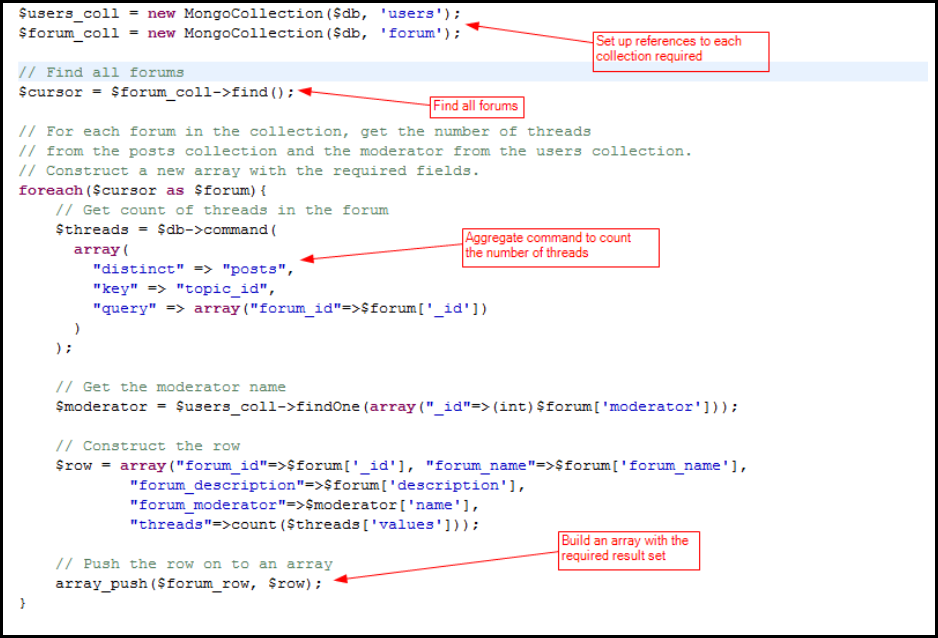
TRANSITIONING FROM RELATIONAL TO NOSQL 66
The second point to note with this query is the aggregation required to determine the
number of threads in the forum. The query retrieves this by getting a count of the number of
posts with a distinct topic id for each forum id. In MongoDB, this is can be achieved by running
the distinct command with a given key and search criteria. In this case, the key is the topic_id
and the filter criteria is the forum_id.
Figure 21. Code for index.php query
The PHP code required for this is shown in Figure 21. We can clearly see here the initial
query which finds all of the forums, followed by the iteration through this collection to retrieve
the number of threads in each forum and the moderator of the forum. This is in contrast to the
SQL query where the data is joined on the server and returned to the client. The SQL statement
TRANSITIONING FROM RELATIONAL TO NOSQL 67
requires, at worst, one scan of each table involved in the query to join the data. Analysing the
code for the MongoDB query, we can see that for each forum that exists, one scan is required of
both the posts collection and the users collection. This can have a significant impact on
performance and be must be considered carefully in the schema design. To determine the impact
a join type query will have on the design, the number of collection lookups required can be
determined using the formula below:
N
s
= 1 + (N
irf
× N
jc
)
where:
N
s
= Number of collection scans
N
irf
= Number of initial records found
N
jc
= Number of collections the initial collection is joined to
Applying this to the index.php page, if our bulletin board has 12 forums, this query will
require 25 find commands in total to retrieve the information required: 1 initial scan of the forum
collection plus 12 scans each of the users collections and the posts collection. This particular
example results in a small amount of find commands and the query time will be negligible.
However, if the forum collection became very large, or if it was necessary to add another
collection to the query, this figure could grow rapidly and have a detrimental effect on
application performance. This situation arises in the next page that will be converted.
The viewforum.php page is responsible for retrieving all the starting posts for each topic
and displaying the topic subject, along with the number of replies and the date of the last post.
The SQL analysis is given in Table 16.

TRANSITIONING FROM RELATIONAL TO NOSQL 68
Table 16. SQL Analysis for viewforum.php
File:
viewforum.php
Function:
N/A
Function Return Type:
N/A
SQL Statement:
CREATE TEMPORARY TABLE tmp (
topic_id INT(11) NOT NULL DEFAULT 0,
postdate datetime NOT NULL default '0000-00-00 00:00:00'
INSERT INTO tmp SELECT topic_id, MAX(date_posted)
FROM forum_posts
WHERE forum_id = $forumid
AND topic_id > 0
GROUP BY topic_id
SELECT t.id as topic_id, t.subject as t_subject,
u.name as t_author, count(p.id) as numreplies,
t.date_posted as t_posted, tmp.postdate as re_posted
FROM forum_users u
JOIN forum_posts t
ON t.author_id = u.id
LEFT JOIN tmp
ON t.id = tmp.topic_id
LEFT JOIN forum_posts p
ON p.topic_id = t.id
WHERE t.forum_id = $forumid
AND t.topic_id = 0
GROUP BY t.id
ORDER BY re_posted DESC
SQL Explanation:
Find the topic_id, subject, author name, number of replies, date
posted and date of last post of each starting post for a given forum id
This is a quite complex query that involves the use of a temporary table in order to first
determine the date of the most recent post for a thread. This temporary table is then joined with
TRANSITIONING FROM RELATIONAL TO NOSQL 69
the forum_posts table, which in turn is joined with the forum_users table. This enables all of the
required fields to be retrieved for the given forum id. There is also some aggregation in this
query: a count of the number of posts for each topic_id (i.e. the number of replies) and the
maximum post date for each topic_id (i.e. the date of the most recent post).
To convert this query to use MongoDB the same methodology defined in the previous
example was used. The main table involved in the query is forum_posts as this is the table that
contains all of the posts that comprise the forum. Note that there are three joins in the query. The
forum_users table is joined with the author_id field in order to get the thread author, the
temporary table is joined on the id field to include the date of the last post, and there is a self join
in order to count the number of replies. This means that one initial query of the posts collection
is required and then three subsequent queries for each record found. The initial query will find
the subject and the post date, along with the join fields required to retrieve the rest of the fields,
namely, topic_id and author_id. Retrieving the post author and the number of replies is trivial
and requires one line of code to query the users collection and the posts collection respectively.
Retrieving the date of the last post however is not so straightforward.
In order to find the last post date, we must first determine if there are any replies to the
post. If there are no replies, then the last post date is the post date of the parent post. If there is
only one reply, then the last post date is the post date of this reply. If there are multiple replies,
then the last post date is the most recent date of this collection of replies. Represented in pseudo-
code:
retrieve all date_posted records for the given topic_id
if there are no records
last_post_date = date_posted of parent post
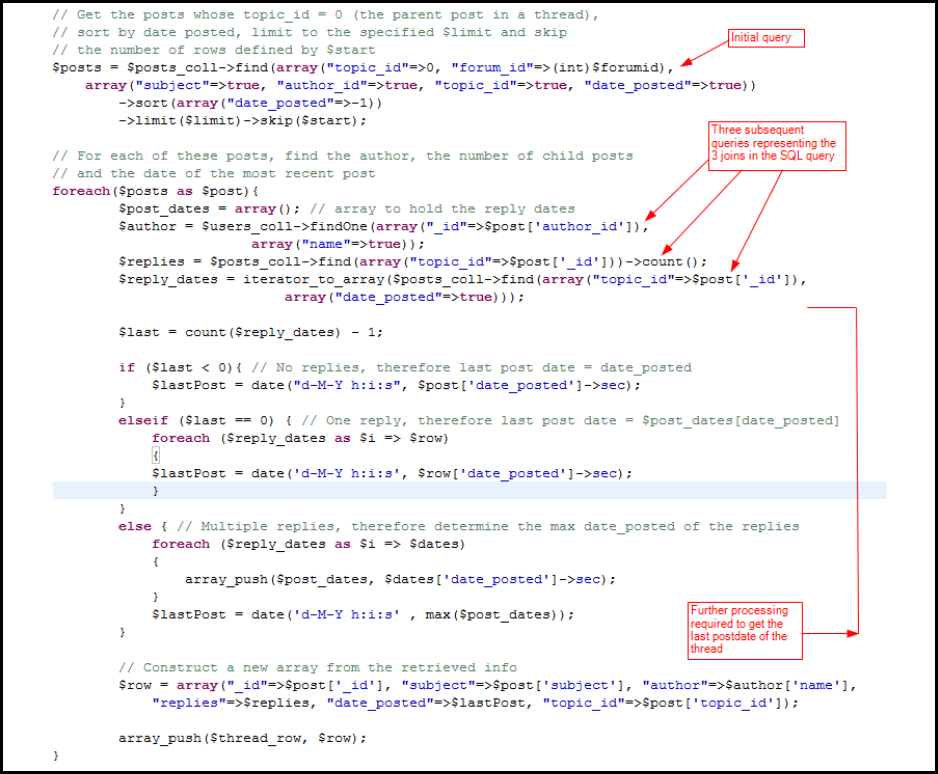
TRANSITIONING FROM RELATIONAL TO NOSQL
else if there is one record
last_post_date = date_posted of this record
else there are multiple records
last_post_date = maxium(date_posted) of the records found
The corresponding PHP implementation is shown in
Figure
TRANSITIONING FROM RELATIONAL TO NOSQL
else if there is one record
last_post_date = date_posted of this record
else there are multiple records
last_post_date = maxium(date_posted) of the records found
The corresponding PHP implementation is shown in
Figure 22.
Figure
22. Converted PHP code for viewforum.php
70
last_post_date = maxium(date_posted) of the records found
TRANSITIONING FROM RELATIONAL TO NOSQL 71
On examination of this code, the first thing that is apparent is the complexity. Although
the SQL query in the relational example was by no means straightforward, once the data had
been retrieved from the database there was very little processing required at the code level to
display this information. The other point to note is the number of total queries required to
retrieve the data. The initial query requires one scan of the posts collection, but then to retrieve
the number of replies and the last post date the posts table must be scanned twice for each record
found, as well one scan of the users table for each record. Using the formula defined in the
previous example, the number of scans required can be determined if a forum had 10,000 posts.
N
s
= 1 + (10,000 × 3) = 30,001
It must also be considered here that two of the collection scans within the for loop are
also of the posts collection, which is the collection that will contain the most amount of
documents and therefore the longest scan times.
Converting the insert/update/delete queries.
Converting the sections of the application that deal with inserting, updating and deleting
data is relatively straightforward when compared to the read operations. The bulletin board
application encapsulates all update/insert operations in 4 files:
• transact-admin.php,
• transact-affirm.php,
• transact-post.php,
• transact-user.php.
The transact-post.php file will be examined further in this section, as this file contains all
interactions relating to inserting/updating posts on the forum, however, the methodology can be
applied to all SQL statements carrying out insert/update/delete functions. The transact-post.php

TRANSITIONING FROM RELATIONAL TO NOSQL 72
file performs a number of different SQL operations depending on the parameter sent to the page.
This analysis will deal with each of these queries separately.
Inserting a new post.
The first operation is to insert a new post to the database. The analysis for the SQL
statement is shown in Table 17.
Table 17. SQL Analysis of transact-post.php insert function
File:
transact-post.php
Function:
Insert new post
Function Return Type:
N/A
SQL Statement:
INSERT INTO forum_posts VALUES (
NULL, $_POST['topic_id'],
$_POST['forum_id'] ,
$_SESSION['user_id'],
0, date("Y-m-d H:i:s",time()),
0, $_POST['subject'],
$_POST['body'];
INSERT IGNORE INTO forum_postcount
VALUES ( $_SESSION['user_id'], 0);
UPDATE forum_postcount SET count = count + 1
WHERE user_id = $_SESSION['user_id'];
SQL Explanation:
Insert a new row in to the forum_posts table with the given
parameters and update the post count for the user.
This query performs a straightforward insert to the forum_posts table and then updates
the forum_postcount table. By using INSERT IGNORE, the query handles the scenario of the
user’s first post. If the user exists, the INSERT statement is ignored and the UPDATE statement
proceeds to increment the count field. If the user does not exist, the INSERT statement will
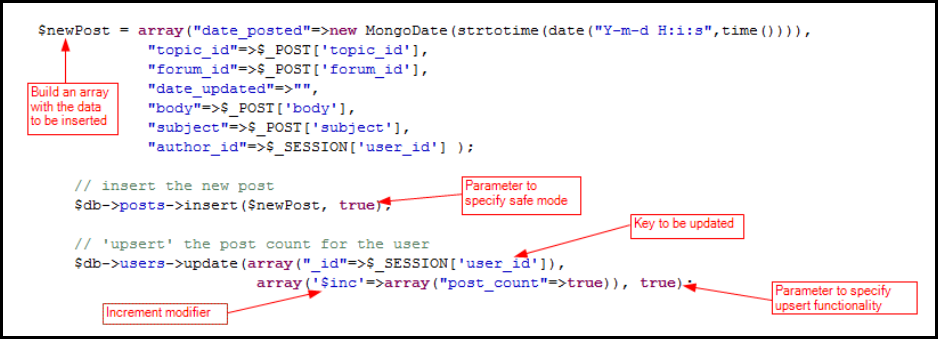
TRANSITIONING FROM RELATIONAL TO NOSQL 73
succeed and enter 0 for the post count and then proceed to increment this to 1 with the following
UPDATE statement.
To convert this functionality for the MongoDB database, an array is required that has all
the required variables and then this array is passed to the MongoDB insert function, as shown in
Figure 23. Converted PHP code for transact-post.php insert function. The second parameter
passed to this command specifies that this command should be executed in safe mode, which
tells the PHP script to wait for a response from the database. If the insert fails, the script will
throw an exception which can be handled by the code. If this parameter is not explicitly set to
true, the PHP code will continue regardless of the result of the insert command. Unless insert
speed is critically important for the application, this parameter should always be set to true.
Otherwise any issues with the database will not be captured and the command will appear to
execute successfully.
Figure 23. Converted PHP code for transact-post.php insert function
Recall that in the schema design for MongoDB, the post count was moved to the users
collection, therefore this field needs to be updated with the MongoDB update command. The
first parameter for this command corresponds to the WHERE clause in the SQL statement. The

TRANSITIONING FROM RELATIONAL TO NOSQL 74
second parameter contains the operation to perform, in this case an increment of the post count
field. Passing ‘true’ as the third parameter in this command specifies that the statement is an
“upsert” statement. This means that if the user exists, perform an update, and if the user does not
exist, perform an insert. This functionality means that the INSERT IGNORE statement in the
MySQL code does not have to be replicated and where two statements were required with SQL,
only one is required with MongoDB.
Another point to note here is that with the SQL statement, a number of dummy values are
required for fields that are not relevant to a new post such as the update_id and date_updated
fields. Because there is no schema required in the MongoDB database, the document can be
inserted without these fields at this point and added later if required.
Updating an existing post.
Table 18 details the SQL statement from transact-post.php that implements the post
update functionality. This statement simply updates one post in the forum_posts table with the
provided subject, update user id, post body and the current date.
Table 18. SQL Analysis for transact-post.php update function
File:
transact-post.php
Function:
Update existing post
Function Return Type:
N/A
SQL Statement:
UPDATE forum_posts
SET subject= $_POST['subject'] ,
update_id= $_SESSION['user_id'] ,
body= $_POST['body'] ,
date_updated=date("Y-m-d H:i:s",time())
WHERE id= $_POST['post'];
SQL Explanation:
Update the subject, user id, body and date updated fields for the
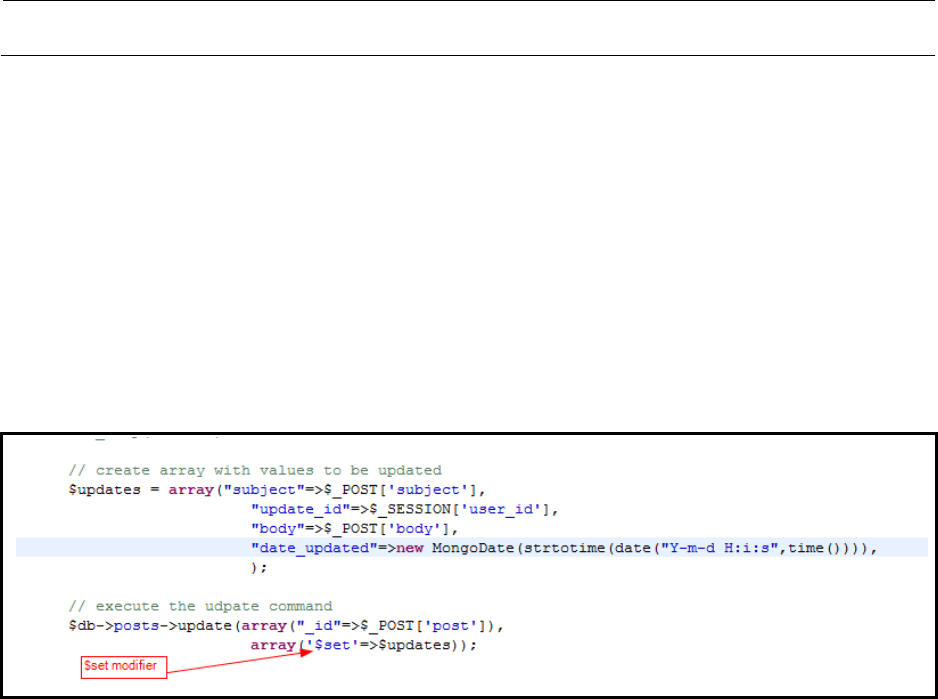
TRANSITIONING FROM RELATIONAL TO NOSQL 75
given post id.
The procedure for converting this statement to use the MongoDB database is similar to
the update operation to the post count that has been discussed already. Again, the MongoDB
update command is used, but on this occasion, the $set modifier is used rather than the $inc
modifier. The fields that need to be updated are added to an array and this array is passed to the
$set modifier in the update command. The first parameter again corresponds to the where clause
in the SQL statement. The converted code is shown in Figure 24.
Figure 24. Converted PHP code for transact-post.php update function
Because of the flexible schema provided by MongoDB, care must be taken when using
the update command. For instance, if the ‘date_updated’ field in the array above was misspelled
as ‘date_update’, the update command will still succeed and the document will either have no
‘date_updated’ field or it will have both a ‘date_updated’ field and a ‘date_update’ field. Any
queries that use the ‘date_updated’ field would then give unexpected results.
Another caveat to the update command is that, by default, only the first record that
matches the criteria gets updated. This is something that is likely to catch out SQL developers.
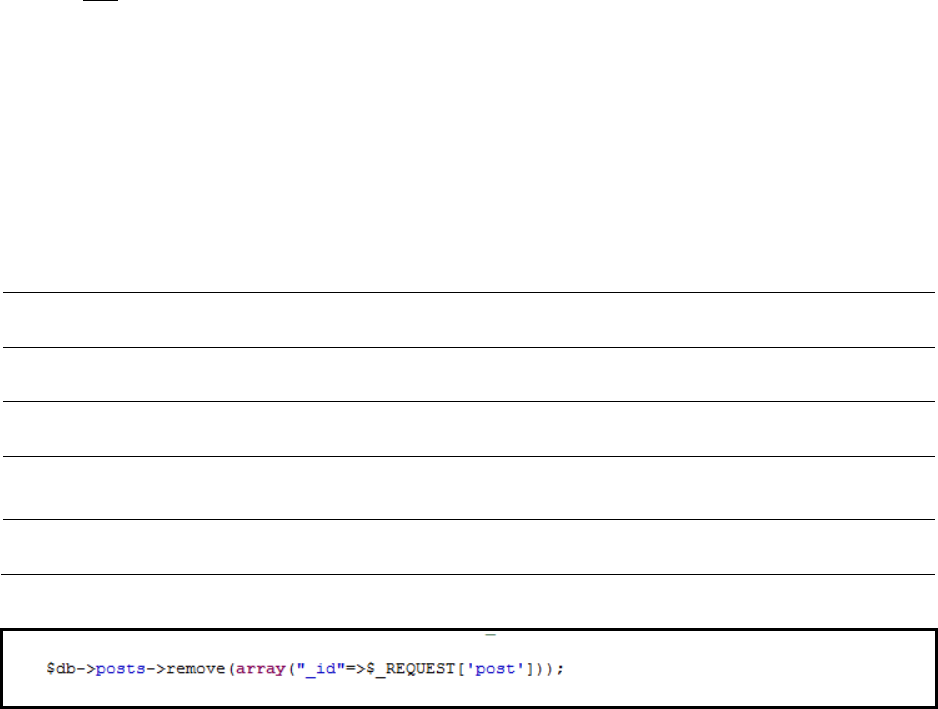
TRANSITIONING FROM RELATIONAL TO NOSQL 76
For example, to update the subject field for all posts with topic_id 39037, you expect the
command below to do this:
$db->posts->update(array("topic_id"=>39037),
array('$set'=>array("subject"=>"New subject")));
However, this will only update one record. To update all records, a value of true must be
given as a fourth parameter to the update command:
$db->posts->update(array("topic_id"=>39037),
array('$set'=>array("subject"=>"New subject")), ,true);
Deleting a post.
Table 19 outlines the SQL required to delete a post. The MongoDB implementation of
the delete operation is very similar to that required for an insert. The id of the post required to be
deleted is passed to the MongoDB remove operation, as shown in Figure 25.
Table 19. SQL Analysis of transact-post.php delete function
File:
transact-post.php
Function:
Delete post
Function Return Type:
N/A
SQL Statement:
DELETE FROM forum_posts
WHERE id= $_REQUEST['post'];
SQL Explanation:
Delete from the forum_posts table where the id matches the given id.
Figure 25. Converted PHP code for transact-post.php delete function
TRANSITIONING FROM RELATIONAL TO NOSQL 77
Performance and Optimization
One of the most important aspects of a database system is the speed with which data can
be retrieved relative to the hardware used to host the databases. This section will present a
number of performance measurements that have been taken to assess how the NoSQL system
performs relative to the relational system. These measurements will also be used to try to
optimize the data retrieval code in the PHP/MongoDB application.
Hardware setup.
In order to compare the performance of two or more database systems, it is important to
ensure that all systems are operating on the same hardware setup and that there is minimal
external influence on the database that may affect any results taken. Both the MySQL and the
MongoDB databases were set up on Amazon Elastic Cloud Compute instances with no other
applications competing for resources. As discussed in Chapter 2, one of the major claims of
NoSQL databases is their ability to run on basic hardware. To test this claim, a micro instance
was chosen as the instance type for both the MongoDB server and the MySQL server. This is the
lowest spec instance type available in Amazon EC2. Its specifications were detailed in the
previous chapter.
Method used for measurement taking.
In order to capture the execution times of the queries in the PHP application, additional
code was added to each PHP page containing either an SQL or a MongoDB query. At the start
and end point of each query, a variable was assigned with the current time. The total execution
time for the query is then the difference between these two variables. An example of this
implementation is shown in Figure 26. This calculation will capture both the query duration and
the fetch time required to return the result to the web server. This fetch time is negligible in this

TRANSITIONING FROM RELATIONAL TO NOSQL 78
case as the information is being transferred across the internal Amazon EC2 high speed network.
Furthermore, the accuracy of the calculation was verified against results in the MySQL long
running query log and the MongoDB query log, both of which report the execution time of
queries in milliseconds.
Figure 26. PHP code to measure MySQL query time
A threshold of 30 seconds was chosen as the maximum acceptable time for a query to
execute. This number was chosen because it is a common timeout limit for web requests. If the
data is not returned within this timeframe, the web server will normally return a timeout error.
However, in a real life situation, query times of much less than 30 seconds would be required for
an application such as this.
Furthermore, these tests do not consider concurrent requests for data as there is only one
statement executing at a time on the database. In a real world scenario, the database would be
handling many requests at the same time and the execution times of these tests will likely be
much longer (or potentially shorter in MySQL as the same query may have been executed by a
different connection which would leave the query result in the query cache).
Comparison of MySQL and MongoDB write performance.
This section will provide a comparison of the write performance of MySQL and
MongoDB by bulk loading data to both database systems from XML files and measuring the
execution time for each file.
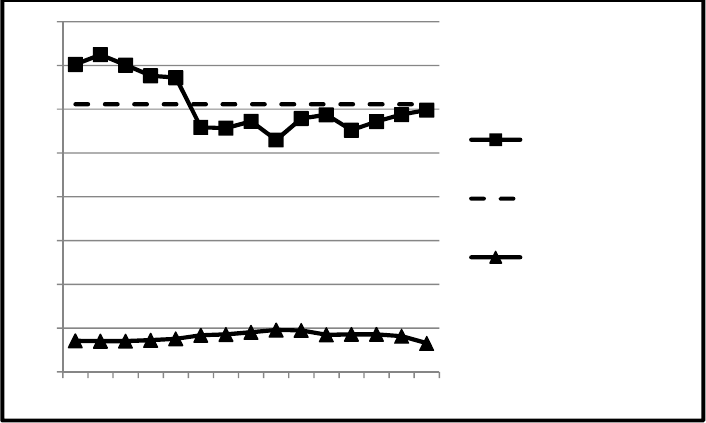
TRANSITIONING FROM RELATIONAL TO NOSQL 79
As discussed in Chapter 3, test data was loaded to both the MySQL database and the
MongoDB database from XML files containing data from the StackExchange network of
question and answer forums. Data was loaded to the forum_users and forum_posts tables in
MySQL and to the users and posts collection in MongoDB. All foreign key references were
disabled in the MySQL database. In order to effectively load the data, the respective XML files
had to be divided into smaller files of equal size. The posts.xml file was divided in to 336 files of
25.5MB each, containing approximately 20,000 rows per file. The users.xml file was divided in
to 15 files of 14.5MB each, containing approximately 60,000 rows per file.
Figure 27. Comparison of import times for users.xml files
The import times for both MySQL and MongoDB are shown in Figure 27. The average
time for MySQL was 611.24 seconds, while the MongoDB average time was 80.72 seconds,
almost 8 times faster. This test highlights the write advantage that MongoDB has over MySQL.
For the posts.xml files, the results are even more in favour of MongoDB which gave an average
0
100
200
300
400
500
600
700
800
1
2
3
4
5
6
7
8
9
10
11
12
13
14
15
MySQL Import Time
(seconds)
MySQL Average
MongoDB Import
Time (seconds)

TRANSITIONING FROM RELATIONAL TO NOSQL 80
time of only 8.93 seconds per file compared to 248.15 seconds for MySQL. These results are
shown in Figure 28.
Figure 28. Comparison of import times for posts.xml files
Comparison of MySQL and MongoDB read performance.
After converting the PHP application, it may be useful to compare the performance of the
MySQL version of the application to the new version using MongoDB. Of the pages converted,
the viewforum.php page is the most resource intensive, in terms of retrieving data from the
database. Therefore this page will be used as the basis for the performance comparison.
Optimizing the MySQL query in viewforum.php.
In order to provide a fair reflection on the performance of the MySQL database in
viewforum.php, a number of optimizations were made with the intention of obtaining the best
possible query times. Recalling from the SQL Analysis in Table 16, there are two tables involved
in the query: forum_posts and forum_users. The first step taken to optimize the query is to create
0
50
100
150
200
250
300
1 3 5 7 9 11 13 15 17 19 21
MySQL Import Time
(seconds)
MongoDB Import Time
(seconds)

TRANSITIONING FROM RELATIONAL TO NOSQL 81
indexes on the fields used in the WHERE clause and any fields used for joins, resulting in the
following indexes:
• forum_posts: id (PRIMARY KEY), topic_id, forum_id, author_id, date_posted
• forum_users: id(PRIMARY KEY)
The original query for this page uses a temporary table to store the last post date for
each topic id. This table is then joined to the forum_posts table in order to generate the required
result set. Joining the temporary table here will be a slow operation unless an index is created on
the topic_id field in the temporary table. However, creating this index is also a time consuming
operation and will still impact the overall query time for this result set.
A better approach to this is to use a view to retrieve the last post date portion of the query
and then join this view to the forum_posts table instead. The view can utilize the existing indexes
on the forum_posts table. The definition for this view is given in Figure 29.
Figure 29. Create view statement
The complete SQL statement is then revised to that shown in Figure 30.
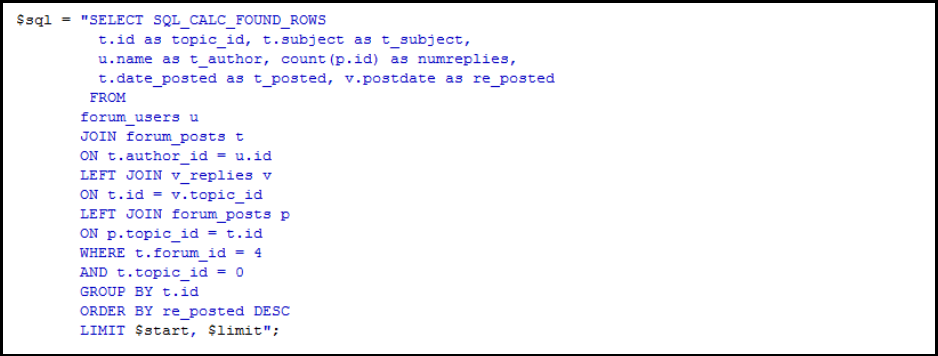
TRANSITIONING FROM RELATIONAL TO NOSQL 82
Figure 30. Revised SQL query for viewforum.php
Test specifications.
In order to compare the read performance of MySQL and MongoDB, a number of test
specifications were devised. Each test involved measuring the execution time of the query from
the viewforum.php page, varying the number of rows in the users and posts tables/collections.
For each test, the query was executed 10 times and the result was recorded each time. Table 20
lists the parameters for each test devised.

TRANSITIONING FROM RELATIONAL TO NOSQL 83
Table 20. Test specifications
Test No. Count of rows/documents in
users table/collection
Count of rows/documents
in posts table/collection
1 59998 27253
2 300000 27253
3 59998 55661
4 300000 55661
5 887373 55661
6 887373 112594
7 887373 139799
8 887373 543553
Performance test results.
Figure 31 shows the results of the performances tests for Test 1. It can be clearly seen
here that MongoDB has a lower query time for this read operation with an average time of 1.18
seconds, compared to 3.23 seconds for MySQL. This is contrary to the read performance results
presented by Cooper et al (2010) which were generated by the YCSB client. They key difference
here is the hardware in use; the setup presented here uses significantly lower hardware that used
in (Cooper et al., 2010). This suggests that MongoDB performs better on lower spec hardware.
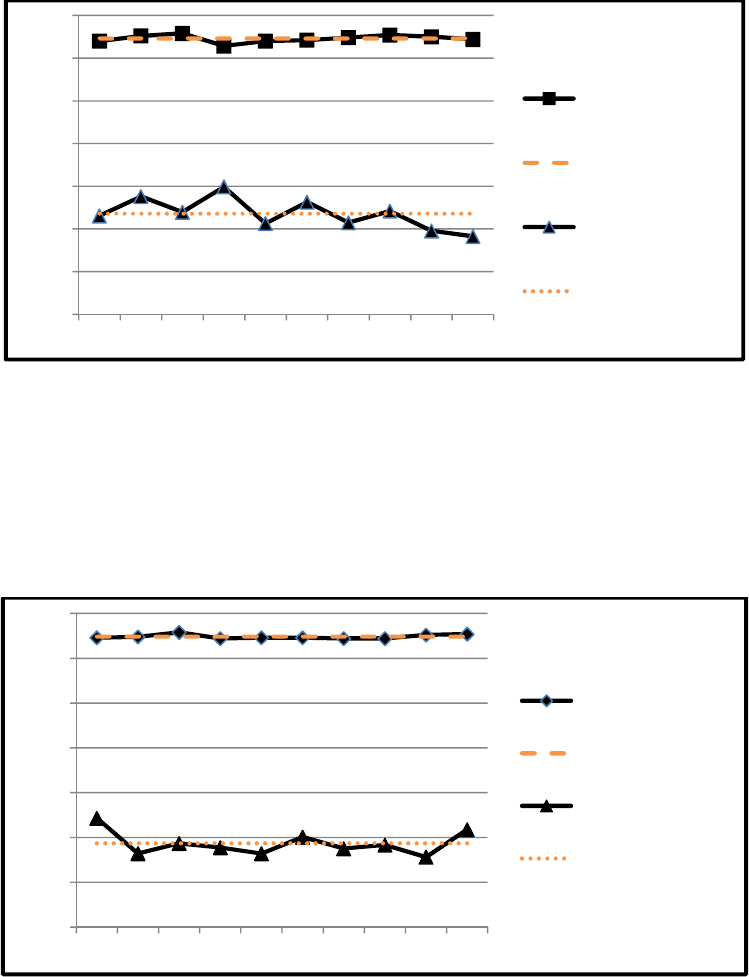
TRANSITIONING FROM RELATIONAL TO NOSQL 84
Figure 31. Results of Test No. 1
Test no. 2 increases the row count on one side of the join between the users and posts
table/collection (the users side) but as shown in Figure 32. Results of Test No. 2 this has very
little effect on query times.
Figure 32. Results of Test No. 2
However, increasing the number of rows in the posts table/collection has a significant
negative effect on the performance of the MySQL database, as shown in Figure 33. The limited
I/O performance and available CPU cycles of the EC2 micro instance are beginning to have a
0
0.5
1
1.5
2
2.5
3
3.5
1
2
3
4
5
6
7
8
9
10
MySQL Query Time
(seconds)
MySQL Average
MongoDB Query
Time (seconds)
MongoDB Average
0
0.5
1
1.5
2
2.5
3
3.5
1
2
3
4
5
6
7
8
9
10
MySQL Query
Time (seconds)
MySQL Average
MongoDB Query
Time (seconds)
MongoDB Average
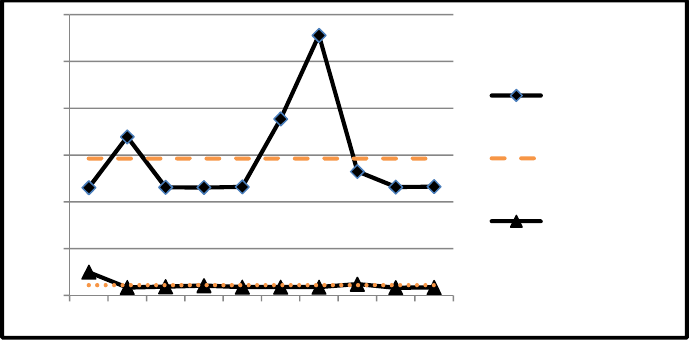
TRANSITIONING FROM RELATIONAL TO NOSQL 85
severe effect on the MySQL instance. The average query time for Test No. 3 is 14.63 seconds,
while the MongoDB instance is largely unaffected by the increase in data volume, with an
average query time of 1.1 seconds.
Figure 33. Results of Test No. 3
Moving on to Test No. 4, the results for MySQL start to go beyond the 30 second
threshold that have been defined for this test. Results also become extremely inconsistent with
query times ranging from 12 seconds to 120 seconds. At this point, either a hardware upgrade or
a schema change is required for the MySQL instance. On the other hand, MongoDB is still
capable of supporting this volume of data with results remaining consistent and only a slight
increase in the average query time to 1.28 seconds. In fact, even with further increases to the row
count in both the users and posts collection, the average read time for MongoDB stays below the
threshold of 30 seconds for tests 5 through 8. The results are summarised in Table 21.
0
5
10
15
20
25
30
1
2
3
4
5
6
7
8
9
10
MySQL Query
Time (seconds)
MySQL Average
MongoDB
Query Time
(seconds)

TRANSITIONING FROM RELATIONAL TO NOSQL 86
Table 21. MongoDB read performance results summary
Test No Average Query Time (seconds)
4 1.28
5 1.9
6 3.5
7 5.6
8 7.15
The read performance only begins to degrade when the document count for the posts
collection reaches 763,768 documents. At this point the query regularly returned the exception
“too much data for sort() with no index. add an index or specify a smaller limit”. Therefore, this
will be considered to be the breaking point for the MongoDB database. There is, however, a way
to optimise this query to handle this volume of data which will be discussed in the next section.
MySQL database engine.
For reference, the MySQL database engine for the forum_users and forum_posts table
was altered from using InnoDB to MyISAM to assess the effect on the test results. This engine
has traditionally performed better than InnoDB and this proved to be the case for this particular
test also. Re-running Test 4 with MyISAM, the MySQL database was able to return data within
the 30 second timeout limit. However, as Figure 34 shows, the average time was still
significantly lower than MongoDB. Couple this with the fact that you no longer have foreign key
support with MyISAM and the trade off does not seem worthwhile.

TRANSITIONING FROM RELATIONAL TO NOSQL 87
Figure 34. Results of Test No. 4 (Using the MyISAM engine)
Using Map-Reduce for Aggregation.
As shown in the previous section, SQL queries that use joins and aggregation do not
transfer well to NoSQL environments in terms of implementing the query. As discussed in
Chapter 2, many NoSQL vendors support Map-Reduce for queries that require aggregations. In
this section I will return to the viewforum.php page and implement the data access code with
Map-Reduce to compare the different approaches and to measure any performance benefits.
To use Map-Reduce, a map function, a reduce function and an optional finalize function
if there are further processing steps required is required. The map function will iterate over a
specified collection and output its data as a set of key-value pairs. The key part will be the field
that we are grouping on. The value part will be a list of the fields that are required in the
aggregation operation. Looking again at the SQL query from viewforum.php in Table 16, the
group by field is topic_id, therefore this will be the key for the map function. For the aggregation
0.00
5.00
10.00
15.00
20.00
25.00
30.00
1
2
3
4
5
6
7
8
9
10
MySQL Query Time
(seconds)
MySQL Average
MongoDB Query Time
(seconds)
MongoDB Average

TRANSITIONING FROM RELATIONAL TO NOSQL 88
a count of the posts for each topic_id and the maximum date_posted are required, therefore we
need the date_posted field in the value part of the map function. Any of the fields can be used to
count so no additional fields are needed for this. The map function gives its output through the
emit statement and the format for this output must be specified. The code for the map function is
shown in Figure 35. It can be seen here that the value part consists of an array that contains a
date_posted element to hold each of the dates for the given topic_id and a count element which
will be used to hold the number of replies. A filter can also be included in this function if
required. The original SQL query looks for all posts where the topic_id is not equal to zero (i.e.
replies only), so this can be included in the map function also.
Figure 35. Map function from viewforum.php
Next, the reduce function was created. This function takes the output from the map
function as its input. It performs the necessary calculations on the data and returns it in the same
format specified in the emit statement of the map function. The reduce function runs once for
each row of data it receives from the map function. The values from each row can be accessed
through the values input parameter. In this particular case, we are looking for the maximum
date_posted value and a count of the number of values in the date_posted element. To get the
maximum date, each value is examined through a for loop and some simple logic is implemented
to find the most recent date. Getting the count is simply a case of incrementing a counter for each
value found. The implementation of this reduce function can be seen in Figure 36.
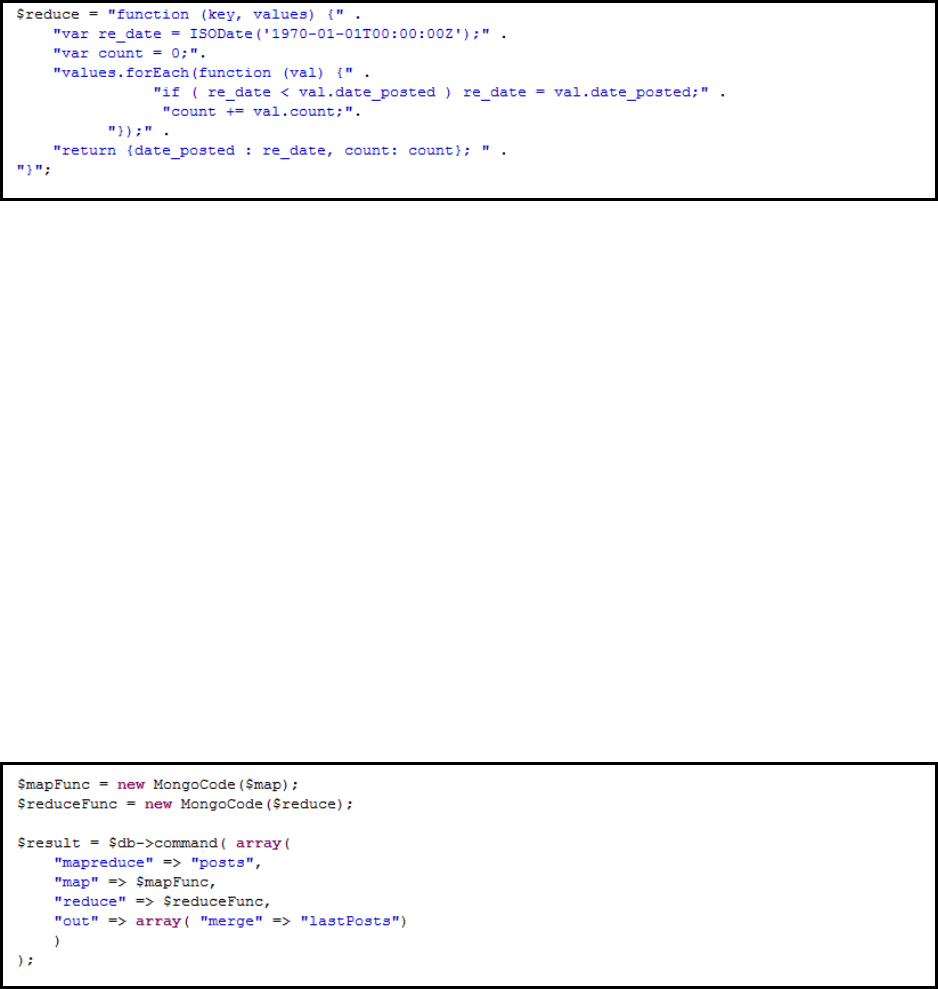
TRANSITIONING FROM RELATIONAL TO NOSQL 89
Figure 36. Reduce function from viewforum.php
To run the map-reduce functions, a command is executed on the MongoDB server,
specifying the collection on which to run the command, the map and reduce functions, how the
output will be stored and an optional query parameter to provide further filtering. This command
is shown in Figure 37. In this case, the output is stored as a collection called ‘lastPosts’. The
merge command specifies that if the collection already exists, the output will be merged with this
existing collection, i.e. if the same key exists the value will be updated, if the key does not exist
the value will be added to the collection. This command should be executed regularly to ensure
that the data in the lastPosts collection is as current as possible. Ideally, it should be executed
every time a new post is entered, or it can be executed on a schedule by a server side task.
Figure 37. Executing the Map-Reduce command
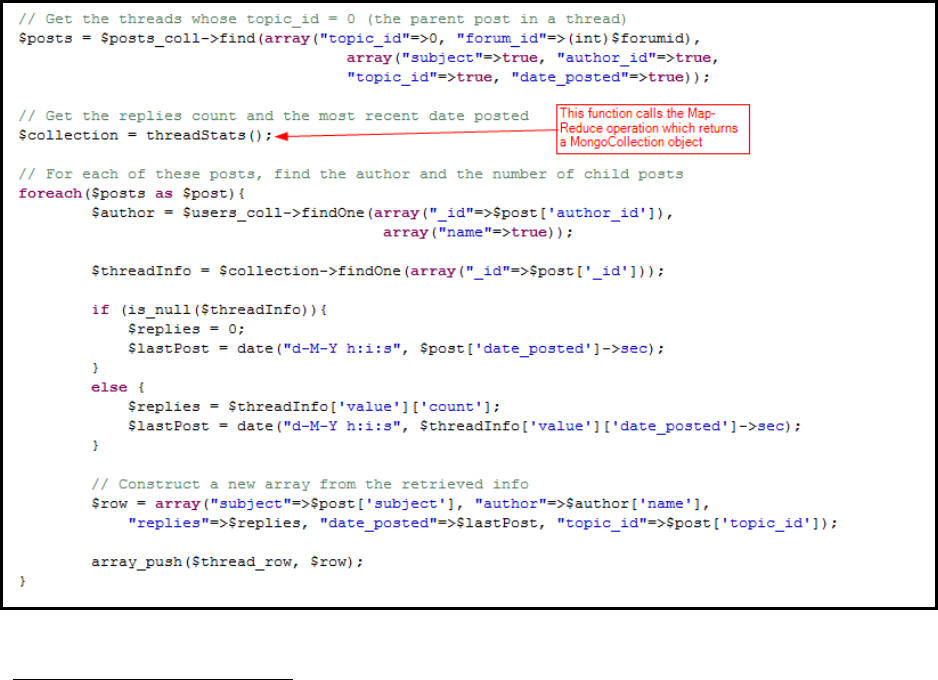
TRANSITIONING FROM RELATIONAL TO NOSQL 90
The collection will now remain available in our database until it is removed explicitly
4
and can be accessed in the same way as any other collection. Now that the required information
is contained in a new collection, the viewforum.php code can be modified. The changes are
shown in Figure 38. Most notably, the two scans of the posts collection have been eliminated and
replaced with a lookup of the collection produced as a result of implementing the Map-Reduce
function. As this collection is an aggregation of the data from the posts collection, it will be a
factor smaller, depending on the ratio of questions to replies. Therefore, the performance of this
code in theory should be much better than previously.
Figure 38. viewforum.php using Map-Reduce
4
MongoDB Version 1.8+
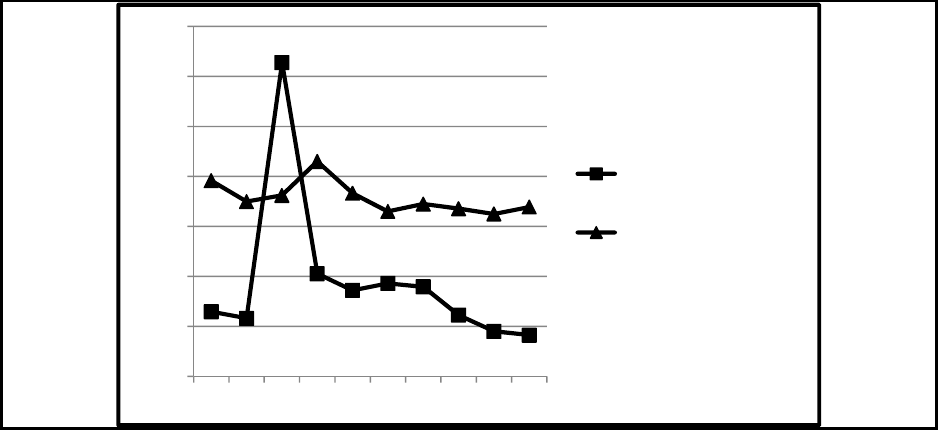
TRANSITIONING FROM RELATIONAL TO NOSQL 91
The drawback with using this approach however is that the collection may not always be
current, depending on how frequently the Map-Reduce function is executed. One other point to
note is that the Map-Reduce output collection can be indexed in the same way as any other
collection. This is analogous to an indexed view in a relational database system. The next section
will provide a comparative analysis of the performance gains as a result of these changes
Performance benefits of using Map-Reduce
The results for Test No. 8 earlier in this chapter produced an average read time of 7.15
seconds. Figure 39 presents the results of this test with and without using Map-Reduce. The
average query time reduces to 3.82 seconds with the Map-Reduce approach.
Figure 39. Comparison of query times using Map-Reduce
The key issue here however, is that the output of the Map-Reduce function must be
updated whenever a new post is entered. With this volume of data, the length of time to execute
the Map-Reduce function took an average of 537 seconds, calculated over 10 executions of the
function. This is unlikely to be an acceptable length of time for an application such as this.
0.00
2.00
4.00
6.00
8.00
10.00
12.00
14.00
1
2
3
4
5
6
7
8
9
10
Query Time with Map
-
Reduce (seconds)
Query Time without
Map-Reduce (seconds)
TRANSITIONING FROM RELATIONAL TO NOSQL 92
However, because of the Map-Reduce can deploy functions in parallel, this time would
dramatically reduce if the data was sharded over several nodes in the cluster. The more nodes
containing shards of the data, the quicker the execution time of the Map-Reduce function. This is
where the real benefit of Map-Reduce can be realised.
Chapter Summary
In this chapter, I have presented how an existing PHP application based on MySQL can
be converted to use a MongoDB backend. By extracting each of the SQL queries from the
existing application, each one can be analysed and converted to equivalent PHP code. Complex
queries involving joins and aggregations are more difficult to create in the MongoDB
environment and require having to iterate several times over each collection in the query. Map-
Reduce can be used to replicate complex SQL queries, but requires a considerable amount of
time to execute when hardware resources are limited.
In contrast, insert, update or delete functions are more straightforward to implement in
MongoDB and are more susceptible to changes in the schema of the database. In terms of
performance, I have shown that MongoDB can perform better than MySQL for both write and
read operations when the capabilities of the hardware are limited.
TRANSITIONING FROM RELATIONAL TO NOSQL 93
Chapter 5 – Conclusions
Research Findings
Transitioning from a relational to a NoSQL environment can result in many benefits for
an organisation. It is possible to take an existing relational schema and translate the design in to
an effective NoSQL schema. Document stores are especially well suited for this as their data
model allows for an almost direct translation: tables map to collections, rows map to documents
and columns map to fields. Indexes are used in the same way as they would in a relational
database.
Some of the benefits that can be realised that this study has shown include:
• Lower cost;
• Shorter development and deployment times;
• Better performance on lower cost hardware;
• The flexibility to change the schema without affecting client systems.
The majority of NoSQL databases carry no license fee and can be installed for free,
which would give a significant cost saving if transitioning from a commercial relational system.
They also perform well on low cost, low specification hardware. This is a particularly useful trait
if a company is also transitioning to cloud based services such as Amazon EC2.
Setting up a NoSQL database in a cluster is also much simpler than deploying an
equivalent distributed relational database which can reduce overall deployment time for the
database system. In the case of the MongoDB database used in this study, a total of 3 servers
were configured in a replica set and this was achieved with the minimal of effort. A simple
configuration file containing the host name and the replica set name for each member server is
TRANSITIONING FROM RELATIONAL TO NOSQL 94
all that is required. This file can also be updated on the fly to include new replicas which begin
replicating data as soon as they are joined to the set.
The thought process for designing a NoSQL schema needs to be adjusted slightly in order
to maximise the strengths of the NoSQL model. Where data would have been normalised in a
relational system to reduce redundancy, often it requires de-normalisation in a NoSQL system
which will require extra care when dealing with data that may exist in more than one location in
the database. The reason for this is the difficulty in writing the data access code to return data
from two or more collections with related fields. The conversion process needs to look at the
most common SQL queries with table joins that execute on the database and see where tables can
be consolidated in to one collection to reduce the need for joins in the NoSQL database. An
example of this was seen in Chapter 3 where three relational tables were consolidated in to one
collection in the MongoDB schema.
Adjusting to a new query language instead of SQL can be challenging at first, however,
in the case of MongoDB, it was not necessarily more difficult to query the database than it would
be to write an SQL statement to query the relational database. Insert, update and delete
operations in particular are just as straightforward as their relational counterparts. It was only
when complex SQL queries were encountered that it became difficult to transfer to a MongoDB
query. When this situation occurs, it should be seen as a trigger to re-evaluate the schema design
to look for possible improvements that would reduce the complexity of the query.
In terms of performance, the NoSQL database returned surprisingly better results than the
equivalent MySQL design. Despite the limited resources available, it is perfectly viable to
deploy a large database on the lowest spec hardware available on Amazon’s EC cloud
TRANSITIONING FROM RELATIONAL TO NOSQL 95
infrastructure. This can result in huge cost reductions to the overall annual cost of a data storage
system.
Lessons Learned
One of the most well stated characteristics of NoSQL databases is that they are not ACID
compliant, in particular that they do not support consistency in the same way as relational
databases. This actually a misconception. It is true that NoSQL databases predominantly only
support eventual consistency, however certain NoSQL databases (such as MongoDB and
Cassandra) can be made to be fully ACID compliant if necessary. Furthermore, this can be set at
the query level, providing complete customization over the consistency property.
The more striking difference between NoSQL and relational is in the area of foreign key
support. Referential integrity is one of the key characteristics of a relational database and this an
area where one needs to take the most care when transitioning to a NoSQL database. Because of
the differences in the way in which data is queried, it is often the case where data must be de-
normalised in the NoSQL database in order to create an efficient query. This can lead to issues
with data redundancy which may not have arisen in a relational system.
On a related point, converting to NoSQL may not be a viable option if the application
contains complex SQL queries. Although Map-Reduce provides a means to create complex
queries on NoSQL databases, the actual implementation can be significantly more difficult that
the equivalent SQL query.
Infrastructure-as-a-service and the cloud is becoming more and more prevalent and it is
therefore important that a database system is able to perform well in this environment. It was for
this reason that Amazon EC2 was chosen as the platform for the use case. The NoSQL database
TRANSITIONING FROM RELATIONAL TO NOSQL 96
performed very well in this environment and was surprisingly more efficient for data retrieval
than the relational database deployed on the same platform.
Summary of Contributions
This study has attempted to give an insight in to the different types of NoSQL
technologies that exist in the market today and the types of applications that these systems are
currently being used for. It is the intention of the research to enlighten the reader to the
possibility of transitioning from an existing relational environment to a NoSQL environment and
to show that this can be particularly beneficial in certain areas. The use case outlined in Chapter
3 and Chapter 4 is intended to prove that an application based on a relational back-end can be
converted to use a NoSQL back-end if the right approach is taken.
Future Research
NoSQL is a very new and exciting technology that can have many different applications.
This study has looked at only one particular use case and this research could be extended to take
into account other types of applications that are built on relational back-ends. Any high volume
OLTP type systems could potentially transfer to a NoSQL environment to provide better
scalability, availability and at a lower cost.
The area of performance testing that was touched on in the analysis chapter is an area that
warrants an entire study in itself. This paper compared the performance of a NoSQL database
with a relational database under very specific conditions. All tests were made in isolation and did
not take into account concurrency issues. Different types of workloads could also be considered
to give a better picture of the performance characteristics of each system.
TRANSITIONING FROM RELATIONAL TO NOSQL 97
References
10Gen. (2012). 10gen - MongoDB Subscription. Retrieved August 8, 2012, from
http://www.10gen.com/subscription
10Gen. (n.d.-a). MongoDB: AWS Marketplace. Retrieved from
http://www.mongodb.org/display/DOCS/AWS+Marketplace
10Gen. (n.d.-b). MongoDB: Replica Set Configuration. Retrieved from
http://www.mongodb.org/display/DOCS/Replica+Set+Configuration
Amazon. (2012a). Amazon Elastic Cloud Compute. Retrieved from http://aws.amazon.com/ec2/
Amazon. (2012b). Amazon EC Elastic IP Addresses. Retrieved from
http://aws.amazon.com/articles/1346
Amazon. (2012c). Amazon EC2 Instance Types. Retrieved August 13, 2012, from
http://aws.amazon.com/ec2/instance-types/
Amazon. (n.d.-a). AWS Marketplace. Retrieved from
https://aws.amazon.com/marketplace/help/200899830/ref=gtw_r1
Amazon. (n.d.-b). LAMP Stack - Web Stack (MySQL) provided by TurnKey Linux.
Atwood, J. (2009, April 6). Stack Overflow Creative Commons Data Dump. Retrieved July 18,
2012, from http://blog.stackoverflow.com/2009/06/stack-overflow-creative-commons-
data-dump/
Basho Technologies Inc. (2012). Basho | Riak Enterprise. Retrieved August 8, 2012, from
http://basho.com/products/riak-enterprise/
Bhat, U., & Jadhav, S. (2010). Moving Towards Non-Relational Databases.
International
Journal of Computer Applications IJCA
,
1
(13), 40–46.
TRANSITIONING FROM RELATIONAL TO NOSQL 98
Black, B. (2009, April 12). Introduction to Cassandra: Replication and Consistency. Retrieved
August 11, 2012, from http://www.slideshare.net/benjaminblack/introduction-to-
cassandra-replication-and-consistency
Bodkin, R. (2010, October 15). InfoQ: Foursquare’s MongoDB Outage. Retrieved March 10,
2012, from http://www.infoq.com/news/2010/10/4square_mongodb_outage
Brewer, E. A. (2000). Towards robust distributed systems.
Proceedings of the Annual ACM
Symposium on Principles of Distributed Computing
(Vol. 19, pp. 7–10).
Cattell, R. (2010, December). Relational Databases, Object Databases, Key-Value Stores,
Document Stores, and Extensible Record Stores: A Comparison. Retrieved from
http://www.odbms.org/download/Cattell.Dec10.pdf
Cattell, R. (2011). Scalable SQL and NoSQL data stores.
SIGMOD Rec.
,
39
(4), 12–27.
doi:10.1145/1978915.1978919
Celler, F. (2012, April 7). Is UNQL Dead? Retrieved August 18, 2012, from
http://www.arangodb.org/2012/04/07/is_unql_dead
Chodorow, K., & Merriman, D. (2011, May 13). Data Types and Conventions - MongoDB.
Retrieved July 17, 2012, from
http://www.mongodb.org/display/DOCS/Data+Types+and+Conventions
Cooper, B. F., Silberstein, A., Tam, E., Ramakrishnan, R., & Sears, R. (2010). Benchmarking
cloud serving systems with YCSB.
Proceedings of the 1st ACM symposium on Cloud
computing
(pp. 143–154).
Couchbase. (2012). NoSQL Database Technology: Post-relational data management for
interactive software systems. Retrieved from
TRANSITIONING FROM RELATIONAL TO NOSQL 99
http://www.couchbase.com/sites/default/files/uploads/all/whitepapers/NoSQL-
Whitepaper.pdf
Creative Commons. (n.d.). BSON - Binary JSON. Retrieved July 17, 2012, from
http://bsonspec.org/#/
DBPedias.com. (n.d.). Facebook Messaging - HBase Comes of Age. Retrieved February 4, 2012,
from http://dbpedias.com/wiki/HBase:Facebook_Messaging_-_HBase_Comes_of_Age
Dean, J., & Ghemawat, S. (2008). MapReduce: simplified data processing on large clusters.
Commun. ACM
,
51
(1), 107–113. doi:10.1145/1327452.1327492
Evans, D. (2011, July 15). The Internet of Things.
blogs@Cisco - Cisco Blogs
. Retrieved August
19, 2012, from http://blogs.cisco.com/news/the-internet-of-things-infographic/
Farrell, E. (2011, September 22).
Nokia: Lessons Learnt Migrating a Very Large and Highly
Relational Database into a “Classic” NoSQL
. Presented at the QCon London 2011,
London. Retrieved from http://www.infoq.com/presentations/Nokia-Lessons-Learnt-
Migrating-into-a-Classic-NoSQL
Google. (2012, April 24). GQL Reference. Retrieved August 18, 2012, from
https://developers.google.com/appengine/docs/python/datastore/gqlreference
Introducing JSON. (n.d.). Retrieved July 23, 2012, from http://www.json.org/
Merriman, D., & Francia, S. (2011, December 12). Use Cases - MongoDB. Retrieved July 4,
2012, from http://www.mongodb.org/display/DOCS/Use+Cases
Murphy, R., & Chodorow, K. (2012a, May 15). Schema Design - MongoDB. Retrieved July 15,
2012, from http://www.mongodb.org/display/DOCS/Schema+Design
Murphy, R., & Chodorow, K. (2012b, May 31). Indexes - MongoDB. Retrieved July 15, 2012,
from http://www.mongodb.org/display/DOCS/Indexes
TRANSITIONING FROM RELATIONAL TO NOSQL 100
Muthukkaruppan, K. (2011, September 29).
HBase @ Facebook
. Presented at the QCon 2011,
San Francisco. Retrieved from http://www.infoq.com/presentations/HBase-at-Facebook
Naramore, E., & Glass, M. K. (2005).
Beginning PHP5, Apache, and MySQL Web Development
.
John Wiley and Sons.
Neo Technology. (2011, November). NoSQL For The Enterprise. Retrieved from
http://www.infoq.com/resource/vcr/1706/file/NOSQLfortheEnterprise.pdf
Oracle. (2011). MySQL 5.5: Storage Engine Performance Benchmark for MyISAM and InnoDB.
Retrieved from http://www.mysql.com/why-mysql/white-
papers/mysql_5.5_perf_myisam_innodb.php
Oracle. (2012, February 10). Oracle Technology Global Price List. Retrieved August 20, 2012,
from http://www.oracle.com/us/corporate/pricing/technology-price-list-070617.pdf
Oracle. (n.d.). Product Details - MySQL Cluster Carrier Grade Edition Subscription (1-4 socket
server). Retrieved August 20, 2012, from
https://shop.oracle.com/pls/ostore/f?p=dstore:product:1061138348116637::NO:RP,6:P6_
LPI,P6_PROD_HIER_ID:60723802201480530690577,58095029061520477171389&tz=
1:00
phpBB. (2007). Features of phpBB. Retrieved July 9, 2012, from
http://www.phpbb.com/about/features/?from=submenu&sid=e21f7d440df8c9691aabdf33
db2059c1
Pokorny, J. (2011). NoSQL databases: a step to database scalability in web environment.
Proceedings of the 13th International Conference on Information Integration and Web-
based Applications and Services
, iiWAS ’11 (pp. 278–283). New York, NY, USA:
ACM. doi:10.1145/2095536.2095583
TRANSITIONING FROM RELATIONAL TO NOSQL 101
Raab, F., Kohler, W., & Shah, A. (n.d.). TPC-C - Overview of the TPC-C Benchmark. Retrieved
February 15, 2012, from http://www.tpc.org/tpcc/detail.asp
Rowe, S. (2012, April 23). Lucene Wiki. Retrieved August 18, 2012, from
http://wiki.apache.org/lucene-java/FrontPage?action=show&redirect=FrontPageEN
Stonebraker, M., & Cattell, R. (2011). 10 rules for scalable performance in “simple operation”
datastores.
Commun. ACM
,
54
(6), 72–80. doi:10.1145/1953122.1953144
The PHP Group. (2012, July 20). PHP Manual: Mongo Types. Retrieved from
http://us2.php.net/manual/en/mongo.types.php
Thorub, K. K. (2011, February 12).
Case Study: Riak on Drugs (and the Other Way Around)
.
Presented at the GOTO Conference 2011, Aarhus. Retrieved from
http://www.infoq.com/presentations/Case-Study-Riak-on-Drugs
vBulletin Solutions. (2012). vBulletin Features. Retrieved July 9, 2012, from
https://www.vbulletin.com/index.php?do=features
Wall, M. (2011, August 11). Why I Chose MongoDB for guardian.co.uk. Retrieved August 20,
2012, from http://www.infoq.com/presentations/Why-I-Chose-MongoDB-for-Guardian
Young, B. (2011, August 16). UnQL Specification. Retrieved August 18, 2012, from
http://www.unqlspec.org/display/UnQL/Home
TRANSITIONING FROM RELATIONAL TO NOSQL 102
Appendix A
Selected PHP Source Code for MySQL database access
index.php
<?php
require_once 'conn.php';
require_once 'functions.php';
require_once 'header.php';
$sql = <<<EOS
SELECT f.id as id, f.forum_name as forum,
f.forum_desc as description,
count(forum_id) as threads, u.name as forum_mod
FROM forum_forum f
LEFT JOIN forum_posts p
ON f.id = p.forum_id
AND p.topic_id=0
LEFT JOIN forum_users u
ON f.forum_moderator = u.id
GROUP BY f.id
EOS;
$result = mysql_query($sql)
or die(mysql_error());
if (mysql_num_rows($result) == 0) {
echo " <br>\n";
echo " There are currently no forums to view.\n";
} else {
echo "<table class=\"forumtable\" cellspacing=\"0\" ";
echo "cellspacing=\"0\"><tr>";
echo "<th class=\"forum\">Forum</th>";
echo "<th class=\"threadcount\">Threads</th>";
echo "<th class=\"moderator\">Moderator</th>";
echo "</tr>";
$rowclass = "";
while ($row = mysql_fetch_array($result)) {
$rowclass = ($rowclass == "row1"?"row2":"row1");
echo "<tr class=\"$rowclass\">";
echo "<td class=\"firstcolumn\"><a href=\"viewforum.php?f=" .
$row['id'] . "\">";
echo $row['forum'] . "</a><br>";
echo "<span class=\"forumdesc\">" . $row['description'];
echo "</span></td>";
echo "<td class=\"center\">" . $row['threads'] . "</td>";
echo "<td class=\"center\">" . $row['forum_mod'] . "</td>";
echo "</tr>\n";
}
echo "</table>";
}
require_once 'footer.php';
?>
TRANSITIONING FROM RELATIONAL TO NOSQL 103
viewforum.php
require_once 'conn.php';
require_once 'functions.php';
require_once 'http.php';
if (!isset($_GET['f'])) redirect('index.php');
require_once 'header.php';
$forumid = $_GET['f'];
$forum = getForum($forumid);
echo breadcrumb($forumid, "F");
if (isset($_GET['page'])) {
$page = $_GET['page'];
} else {
$page = 1;
}
$limit = $admin['pageLimit']['value'];
if ($limit == "") $limit = 25;
$start = ($page - 1) * $admin['pageLimit']['value'];
$sql = "SELECT SQL_CALC_FOUND_ROWS
t.id as topic_id, t.subject as t_subject,
u.name as t_author, count(p.id) as numreplies,
t.date_posted as t_posted, v.postdate as re_posted
FROM
forum_users u
JOIN forum_posts t
ON t.author_id = u.id
LEFT JOIN v_replies v
ON t.id = v.topic_id
LEFT JOIN forum_posts p
ON p.topic_id = t.id
WHERE t.forum_id = 4
AND t.topic_id = 0
GROUP BY t.id
ORDER BY re_posted DESC
LIMIT $start, $limit";
$time_start = microtime(true);
$result = mysql_query($sql)
or die(mysql_error() . "<br>" . $sql);
$time_end = microtime(true);
$time = $time_end - $time_start;
echo "Data Retrieved. Took " . $time . "seconds <br>";
$numrows = mysql_num_rows($result);
echo "Numrows: " . $numrows . "<br>";
if ($numrows == 0) {
$msg = "There are currently no posts. Would you " .
"like to be the first person to create a thread?";
TRANSITIONING FROM RELATIONAL TO NOSQL 104
$title = "Welcome to " . $forum['name'];
$dest = "compose.php?forumid=" . $forumid;
$sev = "Info";
$message = msgBox($msg,$title,$dest,$sev);
echo $message;
} else {
if (isset($_SESSION['user_id'])) {
echo topicReplyBar(0, $_GET['f'], "right");
}
echo "<table class=\"forumtable\" cellspacing=\"0\" ";
echo "cellpadding=\"2\"><tr>";
echo "<th class=\"thread\">Thread</th>";
echo "<th class=\"author\">Author</th>";
echo "<th class=\"replies\">Replies</th>";
echo "<th class=\"lastpost\">Last Post</th>";
echo "</tr>";
$rowclass = "";
while ($row = mysql_fetch_array($result)) {
$rowclass = ($rowclass == "row1"?"row2":"row1");
if ($row['re_posted'] == "") {
$lastpost = $row['t_posted'];
} else {
$lastpost = $row['re_posted'];
}
if ((isset($_SESSION['user_id'])) and
($_SESSION['last_login'] < $lastpost)) {
$newpost = true;
} else {
$newpost = false;
}
echo "<tr class=\"$rowclass\">";
echo "<td class=\"thread\">" . ($newpost?NEWPOST." ":"");
echo "<a href=\"viewtopic.php?t=";
echo $row['topic_id'] . "\">" . $row['t_subject'] . "</a></td>";
echo "<td class=\"author\">" . $row['t_author'] . "</td>";
echo "<td class=\"replies\">" . $row['numreplies'] . "</td>";
echo "<td class=\"lastpost\">" . $lastpost . "</td>";
echo "</tr>\n";
}
echo "</table>";
echo paginate($limit);
echo "<p>" . NEWPOST . " = New Post(s)</p>";
}
require_once 'footer.php';
functions.php
<?php
function getForum($id) {
$sql = "SELECT forum_name as name, forum_desc as description, " .
"forum_moderator as forum_mod ".
"FROM forum_forum ".
TRANSITIONING FROM RELATIONAL TO NOSQL 105
"WHERE id = " . $id;
$result = mysql_query($sql)
or die(mysql_error() . "<br>" . $sql);
$row = mysql_fetch_array($result);
return $row;
}
function getForumID($topicid) {
$sql = "SELECT forum_id FROM forum_posts WHERE id=$topicid";
$result = mysql_query($sql)
or die(mysql_error() . "<br>" . $sql);
$row = mysql_fetch_array($result);
return $row['forum_id'];
}
function breadcrumb($id, $getfrom="F") {
$sep = "<span class=\"bcsep\">";
$sep .= " · ";
$sep .= "</span>";
if ($getfrom == "P") {
$sql = "SELECT forum_id, subject FROM forum_posts " .
"WHERE id = " . $id;
$result = mysql_query($sql)
or die(mysql_error() . "<br>" . $sql);
$row = mysql_fetch_array($result);
$id = $row['forum_id'];
$topic = $row['subject'];
}
$row = getForum($id);
$bc = "<a href=\"index.php\">Home</a>$sep";
switch ($getfrom) {
case "P":
$bc .= "<a href=\"viewforum.php?f=$id\">".$row['name'] .
"</a>$sep" . $topic;
break;
case "F":
$bc .= $row['name'];
break;
}
return "<h4 class=\"breadcrumb\">" . $bc . "</h4>";
}
function showTopic($topicid, $showfull=TRUE) {
global $conn;
global $userid;
global $limit;
echo breadcrumb($topicid, "P");
if (isset($_GET['page'])) {
$page = $_GET['page'];
} else {
$page = 1;
}
if ($limit == "") $limit = 25;
TRANSITIONING FROM RELATIONAL TO NOSQL 106
$start = ($page - 1) * $limit;
if (isset($_SESSION['user_id'])) {
echo topicReplyBar($topicid, getForumID($topicid), "right");
}
$sql = "SELECT SQL_CALC_FOUND_ROWS ".
"p.id, p.subject, p.body, p.date_posted, " .
"p.date_updated, u.name as author, u.id as author_id, " .
"u.signature as sig, c.count as postcount, " .
"p.forum_id as forum_id, f.forum_moderator as forum_mod, " .
"p.update_id, u2.name as updated_by " .
"FROM forum_forum f " .
"JOIN forum_posts p " .
"ON f.id = p.forum_id " .
"JOIN forum_users u " .
"ON u.id = p.author_id " .
"LEFT JOIN forum_users u2 " .
"ON u2.id = p.update_id " .
"LEFT JOIN forum_postcount c " .
"ON u.id = c.user_id " .
"WHERE (p.topic_id = $topicid OR p.id = $topicid) " .
"ORDER BY p.topic_id, p.date_posted ".
"LIMIT $start,$limit";
$result = mysql_query($sql, $conn)
or die(mysql_error() . "<br>" . $sql);
$pagelinks = paginate($limit);
if (mysql_num_rows($result) == 0) {
$msg = "There are currently no posts. Would you " .
"like to be the first person to create a thread?";
$title = "No Posts...";
$dest = "compose.php?forumid=" . $forumid;
$sev = "Info";
$message = msgBox($msg,$title,$dest,$sev);
echo $message;
} else {
echo "<table class=\"forumtable\" cellspacing=\"0\" ";
echo "cellpadding=\"2\"><tr>";
echo "<th class=\"author\">Author</th>";
echo "<th class=\"post\">Post</th>";
echo "</tr>";
$rowclass = "";
while ($row = mysql_fetch_array($result)) {
$lastupdate = "";
$editlink = "";
$dellink = "";
$replylink = " ";
$pcount = "";
$pdate = "";
$sig = "";
if ($showfull) {
$body = $row['body'];
if (isset($_SESSION['user_id'])) {
$replylink = "<a href=\"compose.php?forumid=" .
$row['forum_id'] . "&topicid=$topicid&reid=" . $row['id'] .
"\" class=\"buttonlink\">REPLY</a> ";
} else {
TRANSITIONING FROM RELATIONAL TO NOSQL 107
$replylink = "";
}
if ($row['update_id'] > 0) {
$lastupdate = "<p class=\"smallNote\">Last updated: " .
$row['date_updated'] . " by " .
$row['updated_by'] . "</p>";
}
if (($userid == $row['author_id']) or
($userid == $row['forum_mod']) or
($_SESSION['access_lvl'] > 2)) {
$editlink = "<a href=\"compose.php?a=edit&post=".$row['id'].
"\" class=\"buttonlink\">EDIT</a> ";
$dellink = "<a href=\"transact-affirm.php?action=deletepost&".
"id=" . $row['id'] .
"\" class=\"buttonlink\">DELETE</a> ";
}
$pcount = "<br><span class=\"textsmall\">Posts: " .
($row['postcount']==""?"0":$row['postcount']) . "</span>";
$pdate = $row['date_posted'];
$sig = ($row['sig'] != ""?"<p class=\"sig\">".
bbcode(nl2br($row['sig'])):"")."</p>";
} else {
$body = trimBody($body);
}
$rowclass = ($rowclass == "row1"?"row2":"row1");
echo "<tr class=\"$rowclass\">";
echo "<td class=\"author\">" . $row['author'];
echo $pcount;
echo "</td><td class=\"post\"><p>";
if (isset($_SESSION['user_id'])
and ($_SESSION['last_login'] < $row['date_posted'])) {
echo NEWPOST . " ";
}
if (isset($_GET['page'])) {
$pagelink = "&page=" . $_GET['page'];
} else {
$pagelink = "";
}
echo "<a name=\"post" . $row['id'] .
"\" href=\"viewtopic.php?t=" . $topicid .$pagelink ."#post".
$row['id'] . "\">".POSTLINK."</a>";
if (isset($row['subject'])) {
echo " <strong>" . $row['subject'] . "</strong>";
}
echo "</p><p>" . bbcode(nl2br(htmlspecialchars($body))) . "</p>";
echo $sig;
echo $lastupdate;
echo "</td></tr>";
echo "<tr class=\"$rowclass\"><td class=\"authorfooter\">";
echo $pdate . "</td><td class=\"threadfooter\">";
echo $replylink;
echo $editlink;
echo $dellink;
echo "</td></tr>\n";
}
TRANSITIONING FROM RELATIONAL TO NOSQL 108
echo "</table>";
echo $pagelinks;
echo "<p>".NEWPOST." = New Post ";
echo POSTLINK." = Post link (use to bookmark)</p>";
}
}
function isParent($page) {
$currentpage = $_SERVER['PHP_SELF'];
if (strpos($currentpage, $page) === false) {
return FALSE;
} else {
return TRUE;
}
}
function topicReplyBar($topicid,$forumid,$pos="right") {
$html = "<p class=\"buttonBar" . $pos . "\">";
if ($topicid > 0) {
$html .= "<a href=\"compose.php?forumid=$forumid" .
"&topicid=$topicid&reid=$topicid\" " .
"class=\"buttonlink\">Reply to Thread</a>";
}
if ($forumid > 0) {
$html .= "<a href=\"compose.php?forumid=$forumid\" " .
"class=\"buttonlink\">New Thread</a>";
}
$html .= "</p>";
return $html;
}
function userOptionList($level) {
$sql = "SELECT id, name, access_lvl " .
"FROM forum_users " .
"WHERE access_lvl=" . $level . " " .
"ORDER BY name";
$result = mysql_query($sql)
or die(mysql_error());
while ($row = mysql_fetch_array($result)) {
echo "<option value=\"". $row['id'] . "\">" .
htmlspecialchars($row['name']) . "</option>";
}
}
function paginate($limit=10) {
global $admin;
$sql = "SELECT FOUND_ROWS();";
$result = mysql_query($sql)
or die(mysql_error());
$row = mysql_fetch_array($result);
$numrows = $row[0];
$pagelinks = "<div class=\"pagelinks\">";
if ($numrows > $limit) {
TRANSITIONING FROM RELATIONAL TO NOSQL 109
if(isset($_GET['page'])){
$page = $_GET['page'];
} else {
$page = 1;
}
$currpage = $_SERVER['PHP_SELF'] . "?" . $_SERVER['QUERY_STRING'];
$currpage = str_replace("&page=".$page,"",$currpage);
if($page == 1){
$pagelinks .= "<span class=\"pageprevdead\">< PREV</span>";
}else{
$pageprev = $page - 1;
$pagelinks .= "<a class=\"pageprevlink\" href=\"" . $currpage .
"&page=" . $pageprev . "\">< PREV</a>";
}
$numofpages = ceil($numrows / $limit);
$range = $admin['pageRange']['value'];
if ($range == "" or $range == 0) $range = 7;
$lrange = max(1,$page-(($range-1)/2));
$rrange = min($numofpages,$page+(($range-1)/2));
if (($rrange - $lrange) < ($range - 1)) {
if ($lrange == 1) {
$rrange = min($lrange + ($range-1), $numofpages);
} else {
$lrange = max($rrange - ($range-1), 0);
}
}
if ($lrange > 1) {
$pagelinks .= "..";
} else {
$pagelinks .= " ";
}
for($i = 1; $i <= $numofpages; $i++){
if ($i == $page) {
$pagelinks .= "<span class=\"pagenumdead\">$i</span>";
} else {
if ($lrange <= $i and $i <= $rrange) {
$pagelinks .= "<a class=\"pagenumlink\" " .
"href=\"" . $currpage . "&page=" . $i .
"\">" . $i . "</a>";
}
}
}
if ($rrange < $numofpages) {
$pagelinks .= "..";
} else {
$pagelinks .= " ";
}
if(($numrows - ($limit * $page)) > 0){
$pagenext = $page + 1;
$pagelinks .= "<a class=\"pagenextlink\" href=\"" . $currpage .
"&page=" . $pagenext . "\">NEXT ></a>";
TRANSITIONING FROM RELATIONAL TO NOSQL 110
} else {
$pagelinks .= "<span class=\"pagenextdead\">NEXT ></span>";
}
} else {
$pagelinks .= "<span class=\"pageprevdead\">< " .
"PREV</span> ";
$pagelinks .= "<span class=\"pagenextdead\"> " .
"NEXT ></span> ";
}
$pagelinks .= "</div>";
return $pagelinks;
}
TRANSITIONING FROM RELATIONAL TO NOSQL 111
Appendix B
Selected PHP Source Code for MongoDB Database Access
index.php
<?php
require_once 'mongo_conn.php';
require_once 'functions.php';
require_once 'header.php';
global $m;
global $db;
$forum_row = array();
$users_coll = new MongoCollection($db, 'users');
$forum_coll = new MongoCollection($db, 'forum');
// Find all forums
$cursor = $forum_coll->find();
// For each forum in the collection, get the number of threads
// from the posts collection and the moderator from the users collection.
// Construct a new array with the required fields.
foreach($cursor as $forum){
// Get count of threads in the forum
$threads = $db->command(
array(
"distinct" => "posts",
"key" => "topic_id",
"query" => array("forum_id"=>$forum['_id'])
)
);
// Get the moderator name
$moderator = $users_coll-
>findOne(array("_id"=>(int)$forum['moderator']));
// Construct the row
$row = array("forum_id"=>$forum['_id'], "forum"=>$forum['forum'],
"forum_description"=>$forum['description'],
"forum_moderator"=>$moderator['name'],
"threads"=>count($threads['values']));
// Push the row on to an array
array_push($forum_row, $row);
}
if (empty($cursor)) {
echo " <br>\n";
echo " There are currently no forums to view.\n";
} else {
TRANSITIONING FROM RELATIONAL TO NOSQL 112
echo "<table class=\"forumtable\" cellspacing=\"0\" ";
echo "cellspacing=\"0\"><tr>";
echo "<th class=\"forum\">Forum</th>";
echo "<th class=\"threadcount\">Threads</th>";
echo "<th class=\"moderator\">Moderator</th>";
echo "</tr>";
$rowclass = "";
foreach ($forum_row as $rows){
$rowclass = ($rowclass == "row1"?"row2":"row1");
echo "<tr class=\"$rowclass\">";
echo "<td class=\"firstcolumn\"><a href=\"viewforum.php?f=" .
$rows['forum_id'] . "\">";
echo $rows['forum'] . "</a><br>";
echo "<span class=\"forumdesc\">" . $rows['forum_description'];
echo "</span></td>";
echo "<td class=\"center\">" . $rows['threads'] . "</td>";
echo "<td class=\"center\">" . "" . "</td>";
echo "<td class=\"center\">" . $rows['forum_moderator'] . "</td>";
echo "<td class=\"center\">" . "" . "</td>";
}
echo "</table>";
}
require_once 'footer.php';
?>
viewforum.php (not using Map-Reduce)
<?php
require_once 'mongo_conn.php';
require_once 'functions.php';
require_once 'http.php';
if (!isset($_GET['f'])) redirect('index.php');
require_once 'header.php';
global $m;
global $db;
$forumid = $_GET['f'];
$forum = getForum($forumid);
set_time_limit(600);
echo breadcrumb($forumid, "F");
if (isset($_GET['page'])) {
$page = $_GET['page'];
} else {
$page = 1;
}
$limit = $admin['pageLimit']['value'];
if ($limit == "") $limit = 25;
$start = ($page - 1) * $admin['pageLimit']['value'];
TRANSITIONING FROM RELATIONAL TO NOSQL 113
$posts_coll = new MongoCollection($db, 'posts');
$users_coll = new MongoCollection($db, 'users');
// Build the array with the required information
$thread_row = array();
$time_start = microtime(true);
$posts = $posts_coll->find(array("topic_id"=>0, "forum_id"=>(int)$forumid),
array("subject"=>true, "author_id"=>true, "topic_id"=>true,
"date_posted"=>true))
->sort(array("date_posted"=>-1))
->limit($limit)->skip($start);
// For each of these posts, find the author, the number of child posts
// and the date of the most recent post
foreach($posts as $post){
$post_dates = array(); // array to hold the reply dates
$author = $users_coll-
>findOne(array("_id"=>$post['author_id']),
array("name"=>true));
$replies = $posts_coll->find(array("topic_id"=>$post['_id']))-
>count();
$reply_dates = iterator_to_array($posts_coll-
>find(array("topic_id"=>$post['_id']),
array("date_posted"=>true)));
$last = count($reply_dates) - 1;
if ($last < 0){ // No replies, therefore last post date =
date_posted
$lastPost = date("d-M-Y h:i:s", $post['date_posted']-
>sec);
}
elseif ($last == 0) { // One reply, therefore last post date =
$post_dates[date_posted]
foreach ($reply_dates as $i => $row)
{
$lastPost = date('d-M-Y h:i:s', $row['date_posted']-
>sec);
}
}
else { // Multiple replies, therefore determine the max
date_posted of the replies
foreach ($reply_dates as $i => $dates)
{
array_push($post_dates, $dates['date_posted']-
>sec);
}
$lastPost = date('d-M-Y h:i:s' , max($post_dates));
}
TRANSITIONING FROM RELATIONAL TO NOSQL 114
// Construct a new array from the retrieved info
$row = array("_id"=>$post['_id'], "subject"=>$post['subject'],
"author"=>$author['name'],
"replies"=>$replies, "date_posted"=>$lastPost,
"topic_id"=>$post['topic_id']);
array_push($thread_row, $row);
}
$time_end = microtime(true);
$time = $time_end - $time_start;
echo "Data Retrieved. Took " . $time . "seconds <br>";
if ($numrows == 0) {
$msg = "There are currently no posts. Would you " .
"like to be the first person to create a thread?";
$title = "Welcome to " . $forum['name'];
$dest = "compose.php?forumid=" . $forumid;
$sev = "Info";
$message = msgBox($msg,$title,$dest,$sev);
echo $message;
} else {
if (isset($_SESSION['user_id'])) {
echo topicReplyBar(0, $_GET['f'], "right");
}
echo "<table class=\"forumtable\" cellspacing=\"0\" ";
echo "cellpadding=\"2\"><tr>";
echo "<th class=\"thread\">Thread</th>";
echo "<th class=\"author\">Author</th>";
echo "<th class=\"replies\">Replies</th>";
echo "<th class=\"lastpost\">Last Post</th>";
echo "</tr>";
$rowclass = "";
foreach($thread_row as $row) {
$rowclass = ($rowclass == "row1"?"row2":"row1");
if ((isset($_SESSION['user_id'])) and
($_SESSION['last_login'] < $lastpost)) {
$newpost = true;
} else {
$newpost = false;
}
echo "<tr class=\"$rowclass\">";
echo "<td class=\"thread\">" . ($newpost?NEWPOST." ":"");
echo "<a href=\"viewtopic.php?t=";
echo $row['_id'] . "\">" . $row['subject'] . "</a></td>";
echo "<td class=\"author\">" . $row['author'] . "</td>";
echo "<td class=\"replies\">" . $row['replies'] . "</td>";
echo "<td class=\"lastpost\">" . $row['date_posted'] . "</td>";
echo "</tr>\n";
}
echo "</table>";
echo paginate($limit, $numrows);
echo "<p>" . NEWPOST . " = New Post(s)</p>";
}
TRANSITIONING FROM RELATIONAL TO NOSQL 115
require_once 'footer.php';
?>
viewforum.php (using Map-Reduce)
<?php
require_once 'mongo_conn.php';
require_once 'functions.php';
require_once 'map-reduce_functions.php';
require_once 'http.php';
if (!isset($_GET['f'])) redirect('index.php');
require_once 'header.php';
global $m;
global $db;
$forumid = $_GET['f'];
$forum = getForum($forumid);
echo breadcrumb($forumid, "F");
if (isset($_GET['page'])) {
$page = $_GET['page'];
} else {
$page = 1;
}
$limit = $admin['pageLimit']['value'];
if ($limit == "") $limit = 25;
$start = ($page - 1) * $admin['pageLimit']['value'];
set_time_limit(600);
$posts_coll = new MongoCollection($db, 'posts');
$users_coll = new MongoCollection($db, 'users');
// Build the array with the required information
$thread_row = array();
$time_start = microtime(true);
// Get the threads whose topic_id = 0 (the parent post in a thread)
$posts = $posts_coll->find(array("topic_id"=>0, "forum_id"=>(int)$forumid),
array("subject"=>true, "author_id"=>true,
"topic_id"=>true, "date_posted"=>true))
-
>sort(array("date_posted"=>-1))
-
>limit($limit)->skip($start);
// For each of these posts, find the author and the number of child posts
foreach($posts as $post){
$author = $users_coll-
>findOne(array("_id"=>$post['author_id']),
TRANSITIONING FROM RELATIONAL TO NOSQL 116
array("name"=>true));
// Get the last post date and the number of replies
information
// from the lastPosts collection which is produced as a result
// of running the MapReduce function
$threadInfo = $db->lastPosts-
>findOne(array("_id"=>$post['_id']));
if (is_null($threadInfo)){
$replies = 0;
$lastPost = date("d-M-Y h:i:s", $post['date_posted']-
>sec);
}
else {
$replies = $threadInfo['value']['count'];
$lastPost = date("d-M-Y h:i:s",
$threadInfo['value']['date_posted']->sec);
}
// Construct a new array from the retrieved info
$row = array("subject"=>$post['subject'],
"author"=>$author['name'],
"replies"=>$replies, "date_posted"=>$lastPost,
"topic_id"=>$post['topic_id']);
array_push($thread_row, $row);
}
$time_end = microtime(true);
$time = $time_end - $time_start;
echo "Data Retrieved. Took " . $time . "seconds <br>";
if ($numrows == 0) {
$msg = "There are currently no posts. Would you " .
"like to be the first person to create a thread?";
$title = "Welcome to " . $forum['name'];
$dest = "compose.php?forumid=" . $forumid;
$sev = "Info";
$message = msgBox($msg,$title,$dest,$sev);
echo $message;
} else {
if (isset($_SESSION['user_id'])) {
echo topicReplyBar(0, $_GET['f'], "right");
}
echo "<table class=\"forumtable\" cellspacing=\"0\" ";
echo "cellpadding=\"2\"><tr>";
echo "<th class=\"thread\">Thread</th>";
echo "<th class=\"author\">Author</th>";
echo "<th class=\"replies\">Replies</th>";
echo "<th class=\"lastpost\">Last Post</th>";
echo "</tr>";
$rowclass = "";
TRANSITIONING FROM RELATIONAL TO NOSQL 117
foreach($thread_row as $row) {
$rowclass = ($rowclass == "row1"?"row2":"row1");
if ((isset($_SESSION['user_id'])) and
($_SESSION['last_login'] < $lastpost)) {
$newpost = true;
} else {
$newpost = false;
}
echo "<tr class=\"$rowclass\">";
echo "<td class=\"thread\">" . ($newpost?NEWPOST." ":"");
echo "<a href=\"viewtopic.php?t=";
echo $row['_id'] . "\">" . $row['subject'] . "</a></td>";
echo "<td class=\"author\">" . $row['author'] . "</td>";
echo "<td class=\"replies\">" . $row['replies'] . "</td>";
echo "<td class=\"lastpost\">" . $row['date_posted'] . "</td>";
echo "</tr>\n";
}
echo "</table>";
echo paginate($limit, $numrows);
echo "<p>" . NEWPOST . " = New Post(s)</p>";
}
require_once 'footer.php';
?>
functions.php
function getForum($id) {
global $m;
global $db;
$coll = new MongoCollection($db, 'forum');
$doc = $coll->findOne(array("_id" => $id));
return $doc;
}
function getForumID($topicid) {
// Description: Returns the forum id for a given topic id
// Parameters:
// $topicid - the id of the thread
// $sql = "SELECT forum_id FROM forum_posts WHERE id=$topicid";
// $result = mysql_query($sql)
// or die(mysql_error() . "<br>" . $sql);
// $row = mysql_fetch_array($result);
// return $row['forum_id'];
global $m;
global $db;
$db->resetError();
TRANSITIONING FROM RELATIONAL TO NOSQL 118
$coll = new MongoCollection($db, 'posts');
$doc = $coll->findOne(array("_id" => $topicid));
$result = $db->lastError();
if ($result['err'] == null ) {
return $doc['forum_id'];
}
else {
var_dump($result);
die("MongoDB Error: " . $result['err']);
}
}
function breadcrumb($id, $getfrom="F") {
// Description: Returns a breadcrumb list of previous pages
// starting from the Home page down to the post level.
// e.g. Home . My Fourm . Thread Title
// Parameters:
// $m - the mongodb connection
// $id - the id of the current post
// $getfrom - the breadcrumb level, either F for Forum or P for Post
global $m;
global $db;
// Define the seperator
$sep = "<span class=\"bcsep\">";
$sep .= " · ";
$sep .= "</span>";
$db->resetError();
// if we are at the post level then we need to get the thread name and link
to it
if ($getfrom == "P") {
$coll = new MongoCollection($db, 'posts');
$doc = $coll->findOne(array("_id" => (string)$id));
$id = $doc['forum_id'];
$topic = $doc['subject'];
}
$row = getForum($id);
$bc = "<a href=\"index.php\">Home</a>$sep";
switch ($getfrom) {
case "P":
$bc .= "<a href=\"viewforum.php?f=$id\">".$row['forum_name'] .
"</a>$sep" . $topic;
break;
TRANSITIONING FROM RELATIONAL TO NOSQL 119
case "F":
$bc .= $row['forum'];
break;
}
return "<h4 class=\"breadcrumb\">" . $bc . "</h4>";
}
function showTopic($topicid, $showfull=TRUE) {
global $conn;
global $userid;
global $limit;
global $m;
global $db;
echo breadcrumb($topicid, "P");
if (isset($_GET['page'])) {
$page = $_GET['page'];
} else {
$page = 1;
}
if ($limit == "") $limit = 25;
$start = ($page - 1) * $limit;
if (isset($_SESSION['user_id'])) {
echo topicReplyBar($topicid, getForumID($topicid), "right");
}
$coll_posts = new MongoCollection($db, 'posts');
$query_1 = array("_id" => $topicid);
$posts_doc_cursor = $coll_posts->find($query_1);
$posts_result = iterator_to_array($posts_doc_cursor);
$numrows = $coll_posts->find($query_1)->count();
$coll_forum = new MongoCollection($db, 'forum');
$query_2 = array("_id" => getForumID($topicid));
$forum_doc = $coll_forum->find($query_2);
$pagelinks = paginate($limit, $numrows);
if ($posts_doc_cursor->count() == 0) {
$msg = "There are currently no posts. Would you " .
"like to be the first person to create a thread?";
$title = "No Posts...";
$dest = "compose.php?forumid=" . $forumid;
$sev = "Info";
$message = msgBox($msg,$title,$dest,$sev);
echo $message;
} else {
echo "<table class=\"forumtable\" cellspacing=\"0\" ";
echo "cellpadding=\"2\"><tr>";
echo "<th class=\"author\">Author</th>";
echo "<th class=\"post\">Post</th>";
echo "</tr>";
$rowclass = "";
while ($posts_result) {
TRANSITIONING FROM RELATIONAL TO NOSQL 120
$lastupdate = "";
$editlink = "";
$dellink = "";
$replylink = " ";
$pcount = "";
$pdate = "";
$sig = "";
if ($showfull) {
$body = $posts_result['body'];
if (isset($_SESSION['user_id'])) {
$replylink = "<a href=\"compose.php?forumid=" .
$posts_result['forum_id'] . "&topicid=$topicid&reid=" .
$posts_result['_id'] .
"\" class=\"buttonlink\">REPLY</a> ";
} else {
$replylink = "";
}
if (($userid == $posts_result['author_id']) or
($userid == $posts_result['forum_mod']) or
($_SESSION['access_lvl'] > 2)) {
$editlink = "<a
href=\"compose.php?a=edit&post=".$posts_result['id'].
"\" class=\"buttonlink\">EDIT</a> ";
$dellink = "<a href=\"transact-affirm.php?action=deletepost&".
"id=" . $posts_result['id'] .
"\" class=\"buttonlink\">DELETE</a> ";
}
$pcount = "<br><span class=\"textsmall\">Posts: " .
($posts_result['postcount']==""?"0":$row['postcount']) . "</span>";
$pdate = $posts_result['date_posted'];
} else {
$body = trimBody($body);
}
$rowclass = ($rowclass == "row1"?"row2":"row1");
echo "<tr class=\"$rowclass\">";
echo "<td class=\"author\">" . $posts_result['author'];
echo $pcount;
echo "</td><td class=\"post\"><p>";
if (isset($_SESSION['user_id'])
and ($_SESSION['last_login'] < $row['date_posted'])) {
echo NEWPOST . " ";
}
if (isset($_GET['page'])) {
$pagelink = "&page=" . $_GET['page'];
} else {
$pagelink = "";
}
echo "<a name=\"post" . $posts_result['id'] .
"\" href=\"viewtopic.php?t=" . $topicid .$pagelink ."#post".
$posts_result['id'] . "\">".POSTLINK."</a>";
if (isset($row['subject'])) {
echo " <strong>" . $row['subject'] . "</strong>";
}
echo "</p><p>" . bbcode(nl2br(htmlspecialchars($body))) . "</p>";
echo $sig;
TRANSITIONING FROM RELATIONAL TO NOSQL 121
echo $lastupdate;
echo "</td></tr>";
echo "<tr class=\"$rowclass\"><td class=\"authorfooter\">";
echo $pdate . "</td><td class=\"threadfooter\">";
echo $replylink;
echo $editlink;
echo $dellink;
echo "</td></tr>\n";
}
echo "</table>";
echo $pagelinks;
echo "<p>".NEWPOST." = New Post ";
echo POSTLINK." = Post link (use to bookmark)</p>";
}
}
function isParent($page) {
$currentpage = $_SERVER['PHP_SELF'];
if (strpos($currentpage, $page) === false) {
return FALSE;
} else {
return TRUE;
}
}
function topicReplyBar($topicid,$forumid,$pos="right") {
$html = "<p class=\"buttonBar" . $pos . "\">";
if ($topicid > 0) {
$html .= "<a href=\"compose.php?forumid=$forumid" .
"&topicid=$topicid&reid=$topicid\" " .
"class=\"buttonlink\">Reply to Thread</a>";
}
if ($forumid > 0) {
$html .= "<a href=\"compose.php?forumid=$forumid\" " .
"class=\"buttonlink\">New Thread</a>";
}
$html .= "</p>";
return $html;
}
function userOptionList($level) {
$sql = "SELECT id, name, access_lvl " .
"FROM forum_users " .
"WHERE access_lvl=" . $level . " " .
"ORDER BY name";
$result = mysql_query($sql)
or die(mysql_error());
while ($row = mysql_fetch_array($result)) {
echo "<option value=\"". $row['id'] . "\">" .
htmlspecialchars($row['name']) . "</option>";
}
}
function paginate($limit=10, $numrows) {
TRANSITIONING FROM RELATIONAL TO NOSQL 122
global $admin;
$pagelinks = "<div class=\"pagelinks\">";
if ($numrows > $limit) {
if(isset($_GET['page'])){
$page = $_GET['page'];
} else {
$page = 1;
}
$currpage = $_SERVER['PHP_SELF'] . "?" . $_SERVER['QUERY_STRING'];
$currpage = str_replace("&page=".$page,"",$currpage);
if($page == 1){
$pagelinks .= "<span class=\"pageprevdead\">< PREV</span>";
}else{
$pageprev = $page - 1;
$pagelinks .= "<a class=\"pageprevlink\" href=\"" . $currpage .
"&page=" . $pageprev . "\">< PREV</a>";
}
$numofpages = ceil($numrows / $limit);
$range = $admin['pageRange']['value'];
if ($range == "" or $range == 0) $range = 7;
$lrange = max(1,$page-(($range-1)/2));
$rrange = min($numofpages,$page+(($range-1)/2));
if (($rrange - $lrange) < ($range - 1)) {
if ($lrange == 1) {
$rrange = min($lrange + ($range-1), $numofpages);
} else {
$lrange = max($rrange - ($range-1), 0);
}
}
if ($lrange > 1) {
$pagelinks .= "..";
} else {
$pagelinks .= " ";
}
for($i = 1; $i <= $numofpages; $i++){
if ($i == $page) {
$pagelinks .= "<span class=\"pagenumdead\">$i</span>";
} else {
if ($lrange <= $i and $i <= $rrange) {
$pagelinks .= "<a class=\"pagenumlink\" " .
"href=\"" . $currpage . "&page=" . $i .
"\">" . $i . "</a>";
}
}
}
if ($rrange < $numofpages) {
$pagelinks .= "..";
} else {
$pagelinks .= " ";
}
TRANSITIONING FROM RELATIONAL TO NOSQL 123
if(($numrows - ($limit * $page)) > 0){
$pagenext = $page + 1;
$pagelinks .= "<a class=\"pagenextlink\" href=\"" . $currpage .
"&page=" . $pagenext . "\">NEXT ></a>";
} else {
$pagelinks .= "<span class=\"pagenextdead\">NEXT ></span>";
}
} else {
$pagelinks .= "<span class=\"pageprevdead\">< " .
"PREV</span> ";
$pagelinks .= "<span class=\"pagenextdead\"> " .
"NEXT ></span> ";
}
$pagelinks .= "</div>";
return $pagelinks;
}
TRANSITIONING FROM RELATIONAL TO NOSQL 124
Appendix C
PHP Source Code for MySQL Data Import
import_users.php
function getForum($id) {
global $m;
global $db;
$coll = new MongoCollection($db, 'forum');
$doc = $coll->findOne(array("_id" => $id));
return $doc;
}
function getForumID($topicid) {
// Description: Returns the forum id for a given topic id
// Parameters:
// $topicid - the id of the thread
// $sql = "SELECT forum_id FROM forum_posts WHERE id=$topicid";
// $result = mysql_query($sql)
// or die(mysql_error() . "<br>" . $sql);
// $row = mysql_fetch_array($result);
// return $row['forum_id'];
global $m;
global $db;
$db->resetError();
$coll = new MongoCollection($db, 'posts');
$doc = $coll->findOne(array("_id" => $topicid));
$result = $db->lastError();
if ($result['err'] == null ) {
return $doc['forum_id'];
}
else {
var_dump($result);
die("MongoDB Error: " . $result['err']);
}
}
function breadcrumb($id, $getfrom="F") {
// Description: Returns a breadcrumb list of previous pages
// starting from the Home page down to the post level.
// e.g. Home . My Fourm . Thread Title
// Parameters:
TRANSITIONING FROM RELATIONAL TO NOSQL 125
// $m - the mongodb connection
// $id - the id of the current post
// $getfrom - the breadcrumb level, either F for Forum or P for Post
global $m;
global $db;
// Define the seperator
$sep = "<span class=\"bcsep\">";
$sep .= " · ";
$sep .= "</span>";
$db->resetError();
// if we are at the post level then we need to get the thread name and link
to it
if ($getfrom == "P") {
$coll = new MongoCollection($db, 'posts');
$doc = $coll->findOne(array("_id" => (string)$id));
$id = $doc['forum_id'];
$topic = $doc['subject'];
}
$row = getForum($id);
$bc = "<a href=\"index.php\">Home</a>$sep";
switch ($getfrom) {
case "P":
$bc .= "<a href=\"viewforum.php?f=$id\">".$row['forum_name'] .
"</a>$sep" . $topic;
break;
case "F":
$bc .= $row['forum'];
break;
}
return "<h4 class=\"breadcrumb\">" . $bc . "</h4>";
}
function showTopic($topicid, $showfull=TRUE) {
global $conn;
global $userid;
global $limit;
global $m;
global $db;
echo breadcrumb($topicid, "P");
if (isset($_GET['page'])) {
$page = $_GET['page'];
} else {
$page = 1;
}
if ($limit == "") $limit = 25;
TRANSITIONING FROM RELATIONAL TO NOSQL 126
$start = ($page - 1) * $limit;
if (isset($_SESSION['user_id'])) {
echo topicReplyBar($topicid, getForumID($topicid), "right");
}
$coll_posts = new MongoCollection($db, 'posts');
$query_1 = array("_id" => $topicid);
$posts_doc_cursor = $coll_posts->find($query_1);
$posts_result = iterator_to_array($posts_doc_cursor);
$numrows = $coll_posts->find($query_1)->count();
$coll_forum = new MongoCollection($db, 'forum');
$query_2 = array("_id" => getForumID($topicid));
$forum_doc = $coll_forum->find($query_2);
$pagelinks = paginate($limit, $numrows);
if ($posts_doc_cursor->count() == 0) {
$msg = "There are currently no posts. Would you " .
"like to be the first person to create a thread?";
$title = "No Posts...";
$dest = "compose.php?forumid=" . $forumid;
$sev = "Info";
$message = msgBox($msg,$title,$dest,$sev);
echo $message;
} else {
echo "<table class=\"forumtable\" cellspacing=\"0\" ";
echo "cellpadding=\"2\"><tr>";
echo "<th class=\"author\">Author</th>";
echo "<th class=\"post\">Post</th>";
echo "</tr>";
$rowclass = "";
while ($posts_result) {
$lastupdate = "";
$editlink = "";
$dellink = "";
$replylink = " ";
$pcount = "";
$pdate = "";
$sig = "";
if ($showfull) {
$body = $posts_result['body'];
if (isset($_SESSION['user_id'])) {
$replylink = "<a href=\"compose.php?forumid=" .
$posts_result['forum_id'] . "&topicid=$topicid&reid=" .
$posts_result['_id'] .
"\" class=\"buttonlink\">REPLY</a> ";
} else {
$replylink = "";
}
if (($userid == $posts_result['author_id']) or
($userid == $posts_result['forum_mod']) or
($_SESSION['access_lvl'] > 2)) {
$editlink = "<a
href=\"compose.php?a=edit&post=".$posts_result['id'].
TRANSITIONING FROM RELATIONAL TO NOSQL 127
"\" class=\"buttonlink\">EDIT</a> ";
$dellink = "<a href=\"transact-affirm.php?action=deletepost&".
"id=" . $posts_result['id'] .
"\" class=\"buttonlink\">DELETE</a> ";
}
$pcount = "<br><span class=\"textsmall\">Posts: " .
($posts_result['postcount']==""?"0":$row['postcount']) . "</span>";
$pdate = $posts_result['date_posted'];
} else {
$body = trimBody($body);
}
$rowclass = ($rowclass == "row1"?"row2":"row1");
echo "<tr class=\"$rowclass\">";
echo "<td class=\"author\">" . $posts_result['author'];
echo $pcount;
echo "</td><td class=\"post\"><p>";
if (isset($_SESSION['user_id'])
and ($_SESSION['last_login'] < $row['date_posted'])) {
echo NEWPOST . " ";
}
if (isset($_GET['page'])) {
$pagelink = "&page=" . $_GET['page'];
} else {
$pagelink = "";
}
echo "<a name=\"post" . $posts_result['id'] .
"\" href=\"viewtopic.php?t=" . $topicid .$pagelink ."#post".
$posts_result['id'] . "\">".POSTLINK."</a>";
if (isset($row['subject'])) {
echo " <strong>" . $row['subject'] . "</strong>";
}
echo "</p><p>" . bbcode(nl2br(htmlspecialchars($body))) . "</p>";
echo $sig;
echo $lastupdate;
echo "</td></tr>";
echo "<tr class=\"$rowclass\"><td class=\"authorfooter\">";
echo $pdate . "</td><td class=\"threadfooter\">";
echo $replylink;
echo $editlink;
echo $dellink;
echo "</td></tr>\n";
}
echo "</table>";
echo $pagelinks;
echo "<p>".NEWPOST." = New Post ";
echo POSTLINK." = Post link (use to bookmark)</p>";
}
}
function isParent($page) {
$currentpage = $_SERVER['PHP_SELF'];
if (strpos($currentpage, $page) === false) {
return FALSE;
} else {
return TRUE;
TRANSITIONING FROM RELATIONAL TO NOSQL 128
}
}
function topicReplyBar($topicid,$forumid,$pos="right") {
$html = "<p class=\"buttonBar" . $pos . "\">";
if ($topicid > 0) {
$html .= "<a href=\"compose.php?forumid=$forumid" .
"&topicid=$topicid&reid=$topicid\" " .
"class=\"buttonlink\">Reply to Thread</a>";
}
if ($forumid > 0) {
$html .= "<a href=\"compose.php?forumid=$forumid\" " .
"class=\"buttonlink\">New Thread</a>";
}
$html .= "</p>";
return $html;
}
function userOptionList($level) {
$sql = "SELECT id, name, access_lvl " .
"FROM forum_users " .
"WHERE access_lvl=" . $level . " " .
"ORDER BY name";
$result = mysql_query($sql)
or die(mysql_error());
while ($row = mysql_fetch_array($result)) {
echo "<option value=\"". $row['id'] . "\">" .
htmlspecialchars($row['name']) . "</option>";
}
}
function paginate($limit=10, $numrows) {
global $admin;
$pagelinks = "<div class=\"pagelinks\">";
if ($numrows > $limit) {
if(isset($_GET['page'])){
$page = $_GET['page'];
} else {
$page = 1;
}
$currpage = $_SERVER['PHP_SELF'] . "?" . $_SERVER['QUERY_STRING'];
$currpage = str_replace("&page=".$page,"",$currpage);
if($page == 1){
$pagelinks .= "<span class=\"pageprevdead\">< PREV</span>";
}else{
$pageprev = $page - 1;
$pagelinks .= "<a class=\"pageprevlink\" href=\"" . $currpage .
"&page=" . $pageprev . "\">< PREV</a>";
}
$numofpages = ceil($numrows / $limit);
$range = $admin['pageRange']['value'];
TRANSITIONING FROM RELATIONAL TO NOSQL 129
if ($range == "" or $range == 0) $range = 7;
$lrange = max(1,$page-(($range-1)/2));
$rrange = min($numofpages,$page+(($range-1)/2));
if (($rrange - $lrange) < ($range - 1)) {
if ($lrange == 1) {
$rrange = min($lrange + ($range-1), $numofpages);
} else {
$lrange = max($rrange - ($range-1), 0);
}
}
if ($lrange > 1) {
$pagelinks .= "..";
} else {
$pagelinks .= " ";
}
for($i = 1; $i <= $numofpages; $i++){
if ($i == $page) {
$pagelinks .= "<span class=\"pagenumdead\">$i</span>";
} else {
if ($lrange <= $i and $i <= $rrange) {
$pagelinks .= "<a class=\"pagenumlink\" " .
"href=\"" . $currpage . "&page=" . $i .
"\">" . $i . "</a>";
}
}
}
if ($rrange < $numofpages) {
$pagelinks .= "..";
} else {
$pagelinks .= " ";
}
if(($numrows - ($limit * $page)) > 0){
$pagenext = $page + 1;
$pagelinks .= "<a class=\"pagenextlink\" href=\"" . $currpage .
"&page=" . $pagenext . "\">NEXT ></a>";
} else {
$pagelinks .= "<span class=\"pagenextdead\">NEXT ></span>";
}
} else {
$pagelinks .= "<span class=\"pageprevdead\">< " .
"PREV</span> ";
$pagelinks .= "<span class=\"pagenextdead\"> " .
"NEXT ></span> ";
}
$pagelinks .= "</div>";
return $pagelinks;
}
import_posts.php
<?php
//require_once 'conn-ec2.php';
TRANSITIONING FROM RELATIONAL TO NOSQL 130
require_once 'conn.php';
require_once 'http.php';
require_once 'functions.php';
require_once 'ChromePhp.php';
set_time_limit(900);
$time_start = microtime(true);
for ($counter=1;$counter<5;$counter+=1) {
$url = "Stack_Overflow_122011/posts" . $counter . ".xml";
$xml = simplexml_load_file($url); //puts the xml contents in to an
array like structure
//to loop through values
foreach($xml->row as $row)
{
/////////////////////////////////////////////////
/* **posts**.xml
- Id
- PostTypeId
- 1: Question (?)
- 2: Answer (?)
- ParentId (only present if PostTypeId is 2)
- AcceptedAnswerId (only present if PostTypeId is 1)
- CreationDate *
- Score
- ViewCount
- Body *
- OwnerUserId *
- LastEditorUserId *
- LastEditorDisplayName="Rich B"
- LastEditDate="2009-03-05T22:28:34.823"
- LastActivityDate="2009-03-11T12:51:01.480"
- CommunityOwnedDate="2009-03-11T12:51:01.480"
- ClosedDate="2009-03-11T12:51:01.480"
- Title= *
- Tags=
- AnswerCount
- CommentCount
- FavoriteCount
*/
///////////////////////////////////////////////////////
$id = $row["Id"];
$date_posted = $row["CreationDate"];
$date_updated = $row["LastEditDate"];
$body = mysql_real_escape_string($row["Body"]);
$author_id = $row["OwnerUserId"];
$update_id = $row["LastEditorUserId"];
if ($row["Title"]==""){
$subject = "No Subject";
}
TRANSITIONING FROM RELATIONAL TO NOSQL 131
else{ $subject = mysql_real_escape_string($row["Title"]);}
if ($row["PostTypeId"]==1){
$topic_id = 0;
}
else {
$topic_id = $row["ParentId"];
}
$forum_id = 4;
$sql = "INSERT INTO forum_posts " .
"(id,topic_id,forum_id,author_id,update_id,date_posted,date_updated,subject,b
ody) " .
"VALUES ('" . $id . "','" . $topic_id . "','" .
$forum_id . "','" .
$author_id . "','" . $update_id . "','" .
$date_posted . "','" .
$date_posted . "','" . $subject . "','" . $body
. "')";
if (!mysql_query($sql, $conn)){
if (mysql_errno()== 1064){
ChromePhp::error('Syntax Error');
ChromePhp::log("STRING", $row["Body"]);
ChromePhp::log("FIXED_STRING",
mysql_real_escape_string($row["Body"]));
}
die(mysql_error() . "<br>" . $sql);
}
}
$time_end = microtime(true);
$time = $time_end - $time_start;
echo "Import of file " . $url . " to MySQL complete. Took " . $time .
"seconds <br>";
}
?>
TRANSITIONING FROM RELATIONAL TO NOSQL 132
Appendix D
PHP Source Code for MongoDB Data Import
import_users.php
<?php
require_once 'http.php';
require_once 'functions.php';
require_once 'ChromePhp.php';
require_once 'mongo_conn-ec2.php';
global $m;
global $db;
set_time_limit(600);
$collection = $db->users;
for ($counter=1;$counter<2;$counter+=1) {
$url = "Stack_Overflow_122011/users_" . $counter .".xml";
$xml = simplexml_load_file($url); //puts the xml contents in to an
array like structure
$time_start = microtime(true);
//to loop through values
foreach($xml->row as $row) {
/* - **users**.xml DB Field
- Id * id
- Reputation
- CreationDate * date_joined
- DisplayName * name
- EmailHash * email
- LastAccessDate * last_login
- WebsiteUrl * signature
- Location
- Age
- AboutMe
- Views
- UpVotes
- DownVotes
passwd =
autoGenerate(randomNumber)
access_lvl = (1 | 2 | 3)
*/
TRANSITIONING FROM RELATIONAL TO NOSQL 133
$id = (int)$row["Id"];
$date_joined = new MongoDate(strtotime($row["CreationDate"]));
$name = (string)$row["DisplayName"];
$email = (string)$row["EmailHash"];
$last_login = new
MongoDate(strtotime($row["LastAccessDate"]));
$signature = (string)$row["WebsiteUrl"];
$passwd = generatePassword(rand(5,20), 8);
$access_lvl = rand(1,3);
try {
$arr = array('_id' => $id, 'name' => $name, 'date_joined' =>
$date_joined, 'email' => $email,
'last_login' => $last_login,
'signature' => $signature, 'password' => $passwd,
'access_lvl' => $access_lvl,
'post_count' => 0);
$db->users->insert($arr, true);
}
catch (MongoCursorException $mce){
echo "error message: ".$mce->getMessage()."\n";
echo "error code: ".$mce->getCode()."\n";
}
catch (Exception $e) {
var_dump($e->getMessage());
var_dump($arr);
logToFile($logfile, $e->getMessage());
}
}
$time_end = microtime(true);
$time = $time_end - $time_start;
echo "Import of file " . $url . " complete. Took " . $time . "seconds
<br>";
}
?>
import_posts.php
<?php
require_once 'http.php';
require_once 'functions.php';
require_once 'ChromePhp.php';
include 'mongo_conn-ec2.php';
global $m;
global $db;
$collection = $db->posts;
for ($counter=3;$counter<5;$counter+=1) {
TRANSITIONING FROM RELATIONAL TO NOSQL 134
$url = "Stack_Overflow_122011/posts" . $counter . ".xml";
$xml = simplexml_load_file($url); //puts the xml contents in to an
array like structure
$logfile = "log/import_posts-mongo_" . date("Ymdhis", mktime()) .
".log";
$time_start = microtime(true);
set_time_limit(600);
foreach($xml->row as $row) {
/////////////////////////////////////////////////
/* **posts**.xml
- Id *
- PostTypeId *
- 1: Question (?)
- 2: Answer (?)
- ParentId (only present if PostTypeId is 2)
- AcceptedAnswerId (only present if PostTypeId is 1)
- CreationDate *
- Score
- ViewCount
- Body *
- OwnerUserId *
- LastEditorUserId *
- LastEditorDisplayName="Rich B"
- LastEditDate="2009-03-05T22:28:34.823"
- LastActivityDate="2009-03-11T12:51:01.480"
- CommunityOwnedDate="2009-03-11T12:51:01.480"
- ClosedDate="2009-03-11T12:51:01.480"
- Title= *
- Tags=
- AnswerCount
- CommentCount
- FavoriteCount
*/
///////////////////////////////////////////////////////
$id = (string)$row["Id"];
$date_posted = new MongoDate(strtotime($row["CreationDate"]));
$date_updated = new
MongoDate(strtotime($row["LastEditDate"]));
$body = (string)$row["Body"];
$author_id = (string)$row["OwnerUserId"];
$update_id = (string)$row["LastEditorUserId"];
if ($row["Title"]==""){
$subject = "No Subject";
}
else{ $subject = (string)$row["Title"];}
if ($row["PostTypeId"]==1){
$topic_id = 0;
}
elseif ($row["PostTypeId"]==2) {
TRANSITIONING FROM RELATIONAL TO NOSQL 135
$topic_id = (string)$row["ParentId"];
}
$forum_id = 4;
try {
$arr = array('_id' => $id, 'date_posted' =>
$date_posted, 'date_updated' => $date_updated, 'body' => $body,
'author_id' =>
$author_id, 'update_id' => $update_id, 'subject' => $subject,
'topic_id' => $topic_id,
'forum_id' => $forum_id);
($db->posts->insert($arr));
}
catch (MongoCursorException $mce){
echo "error message: ".$mce->getMessage()."\n";
echo "error code: ".$mce->getCode()."\n";
}
catch (Exception $e) {
var_dump($e->getMessage());
var_dump($arr);
logToFile($logfile, $e->getMessage());
}
}
$time_end = microtime(true);
$time = $time_end - $time_start;
echo "Import of file " . $url . " complete. Took " . $time . "seconds
<br>";
}
?>
